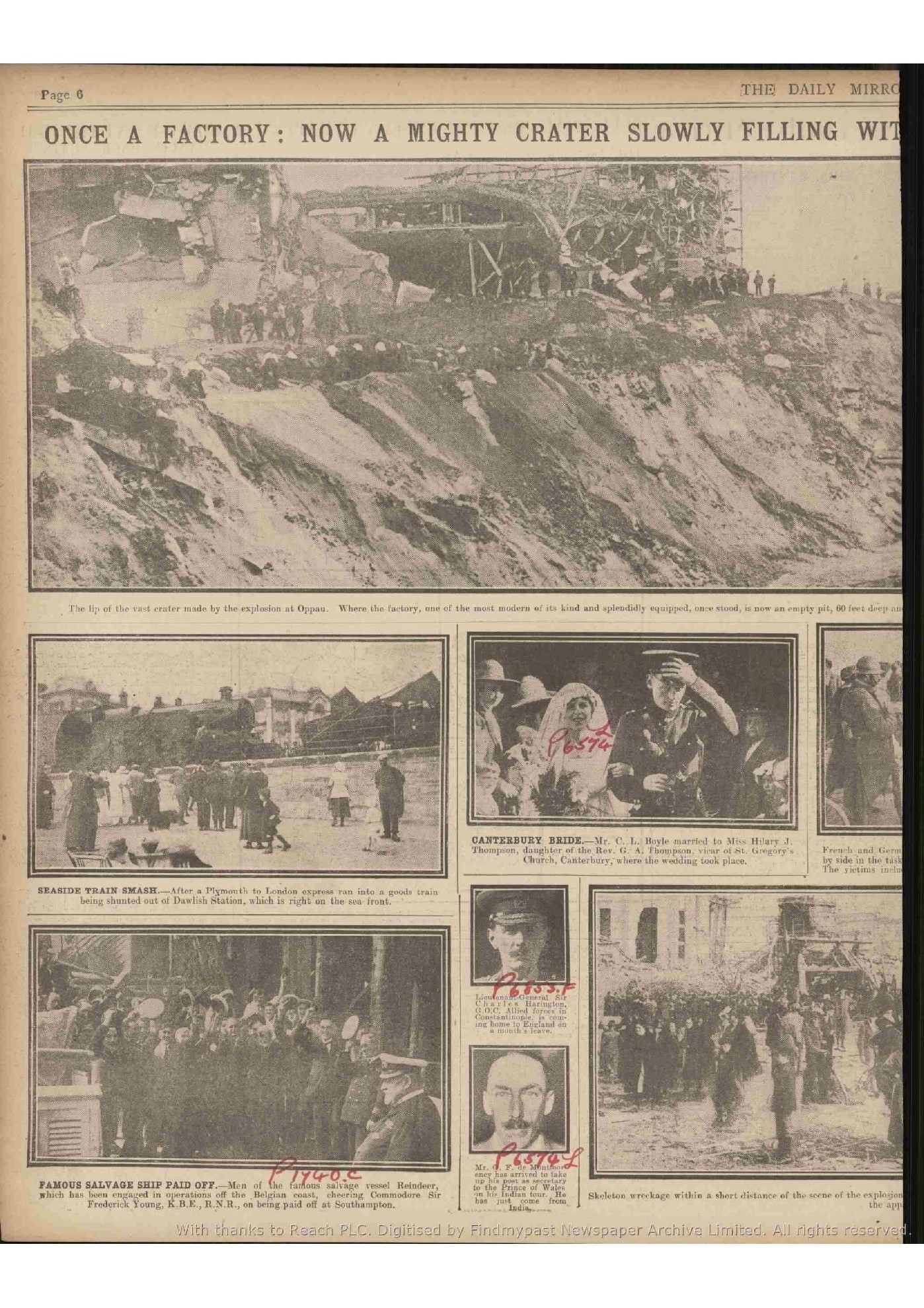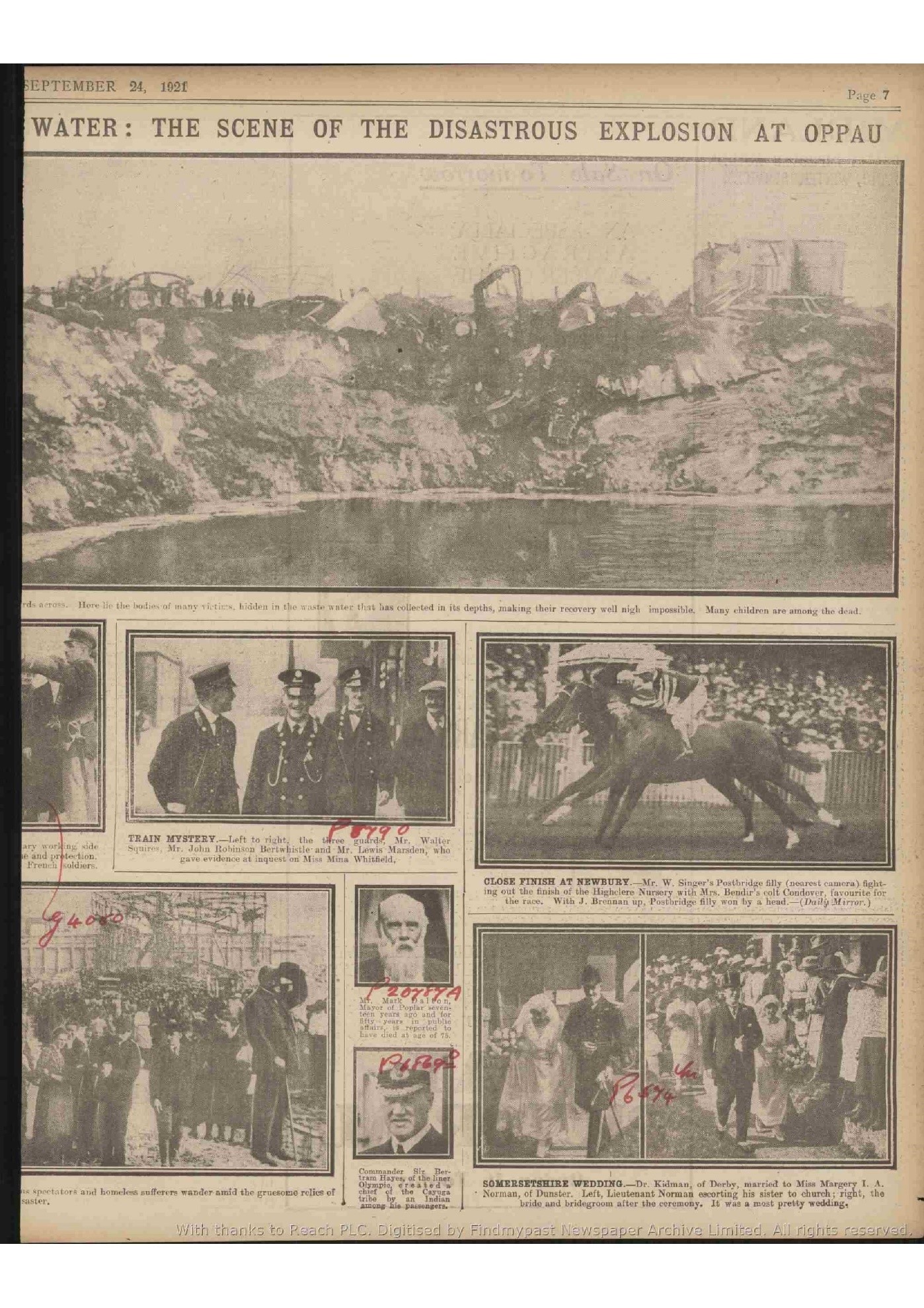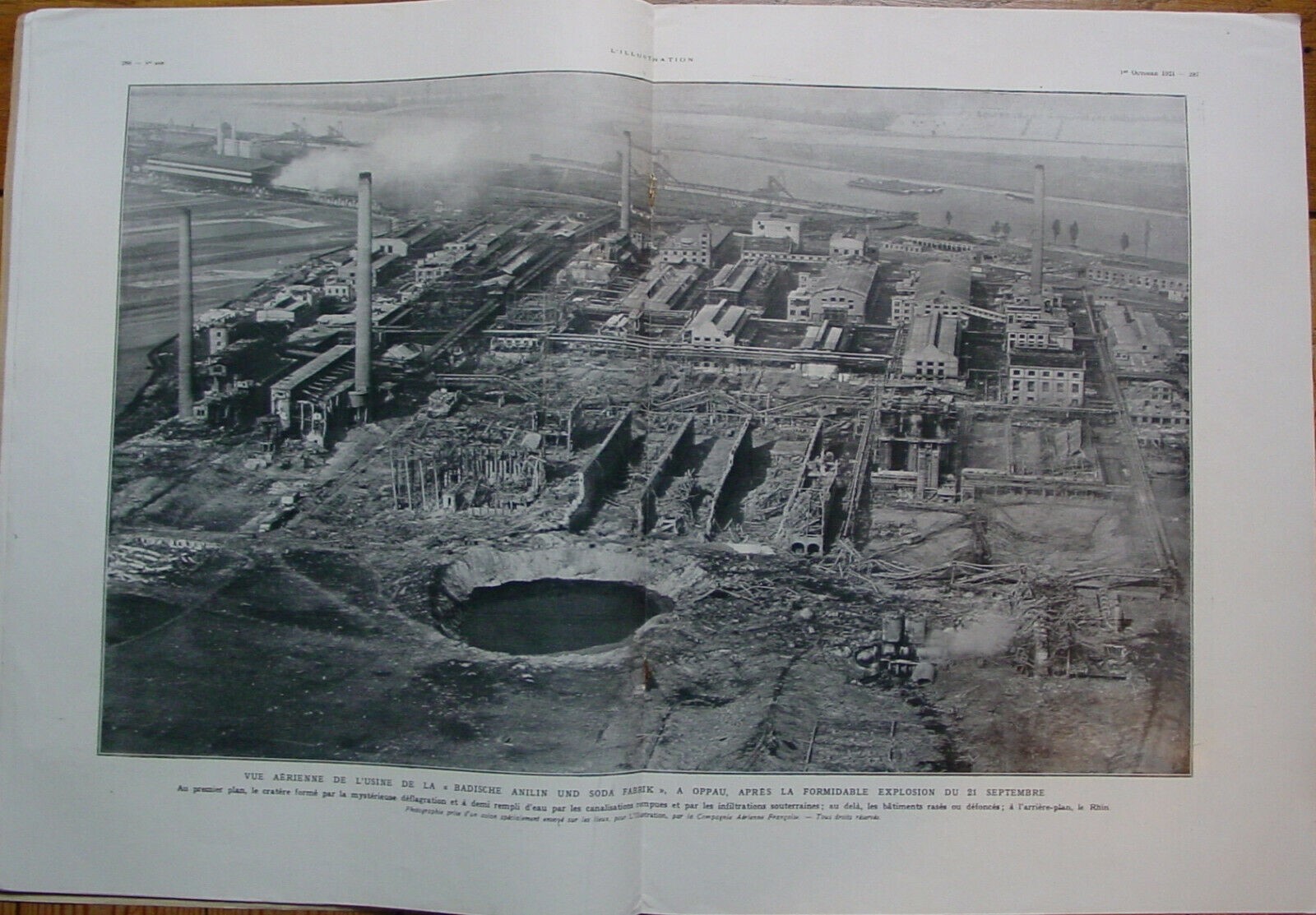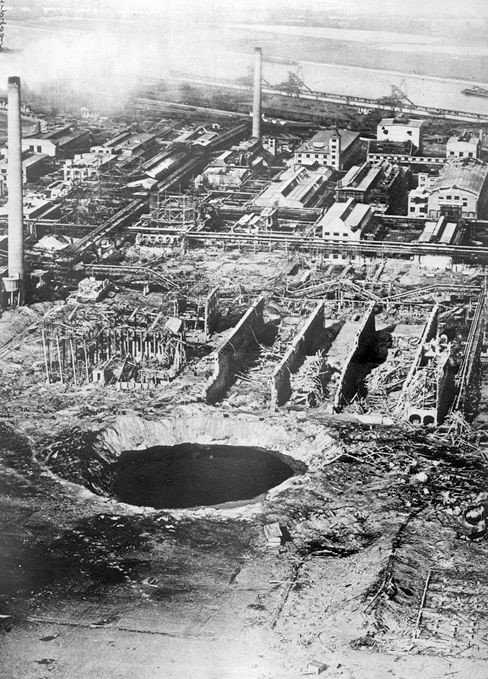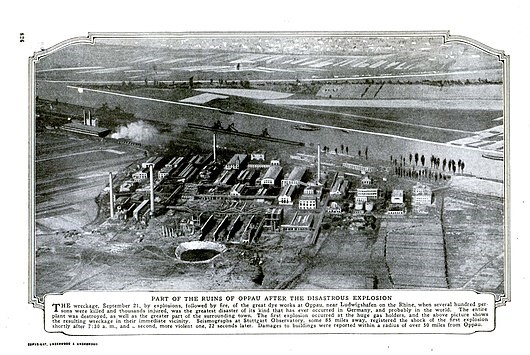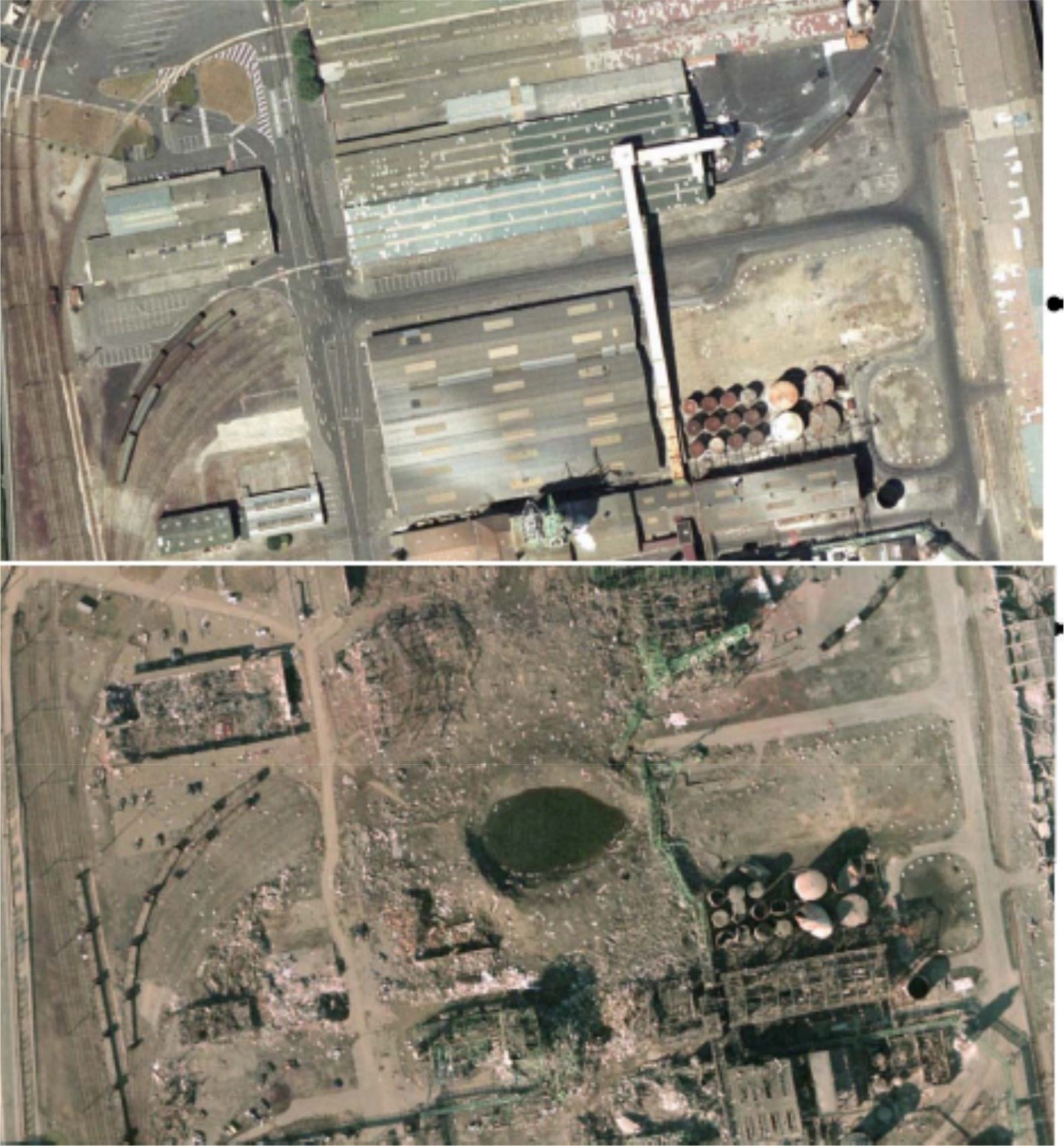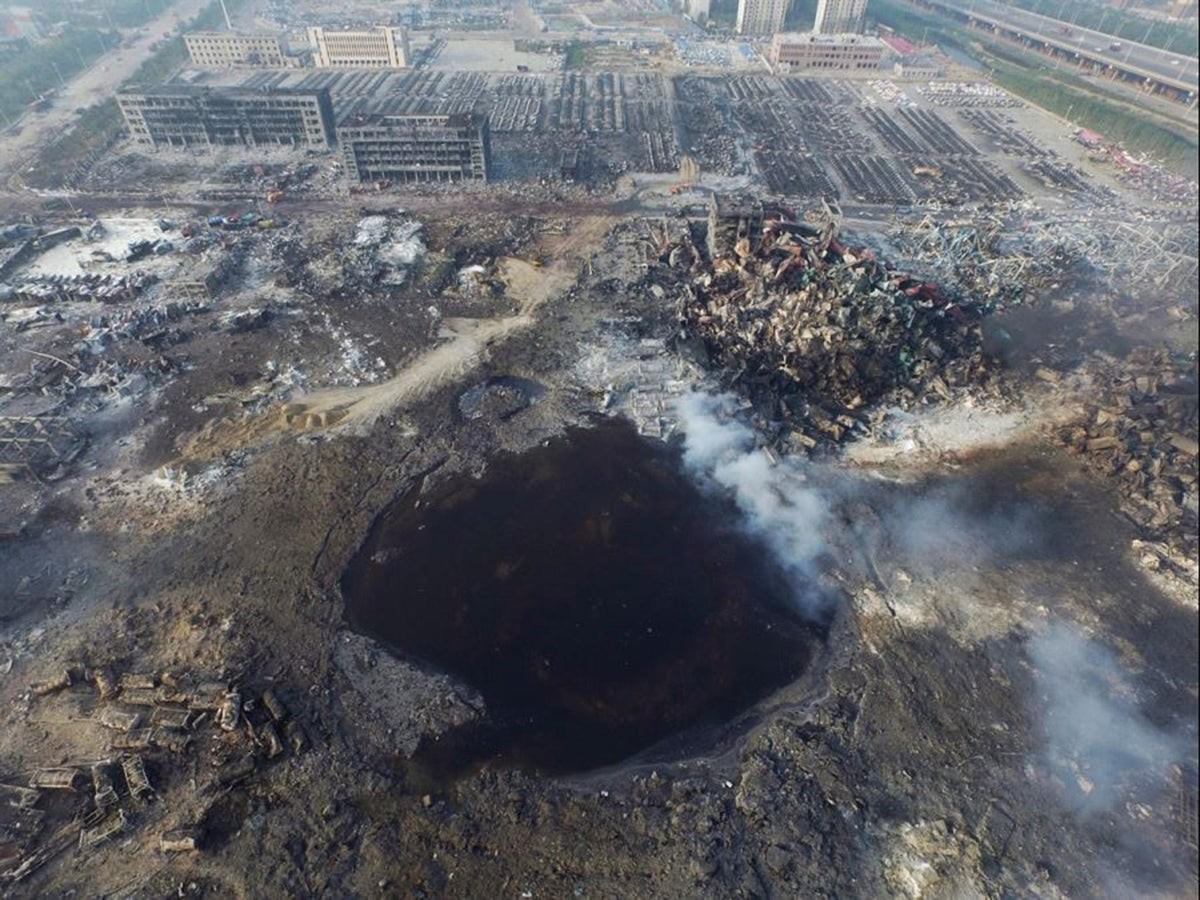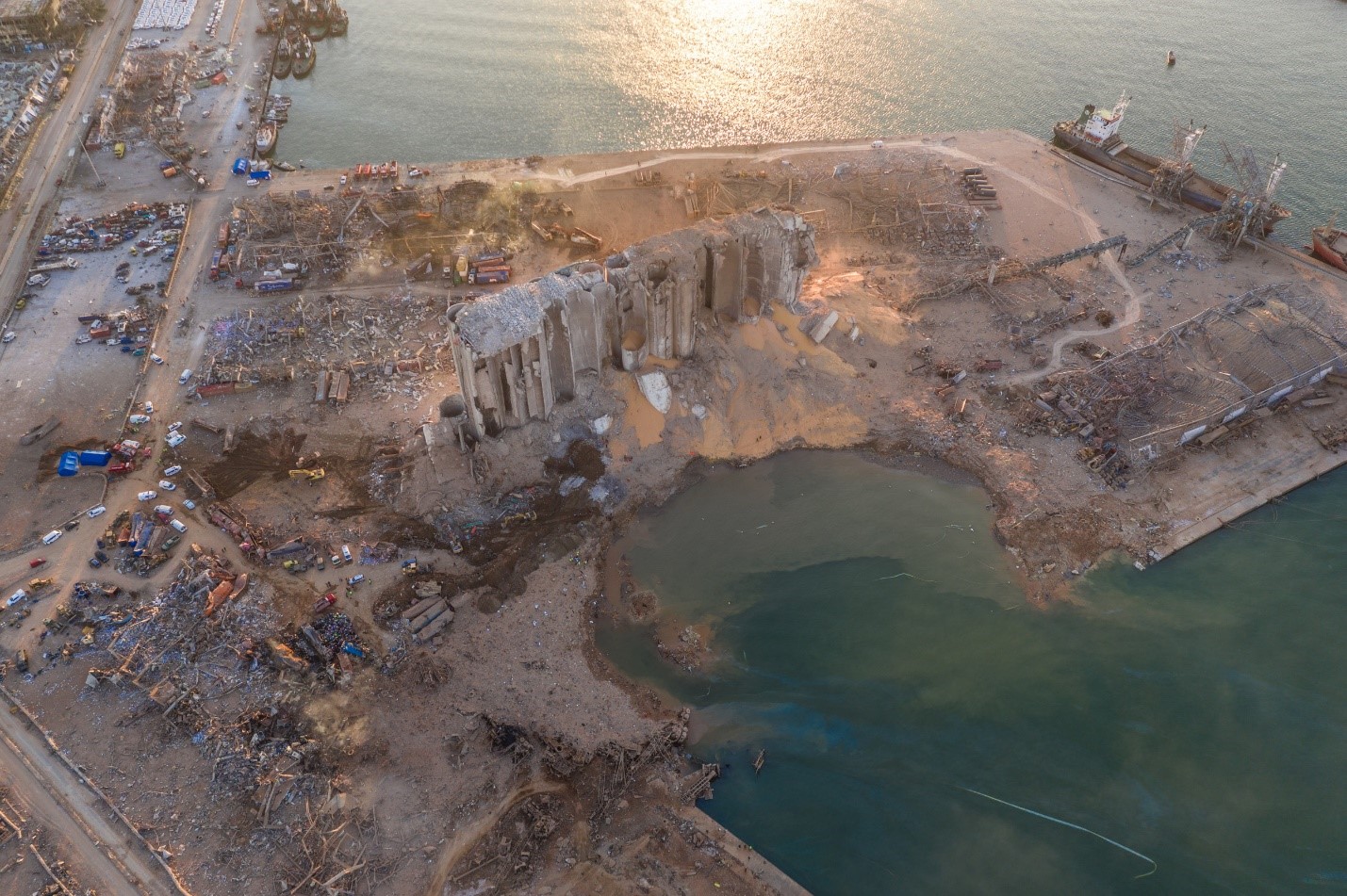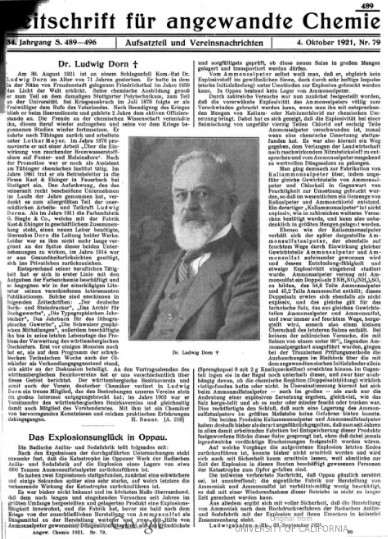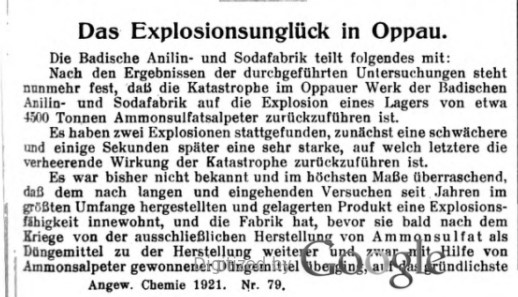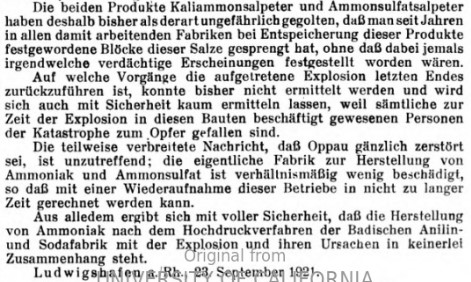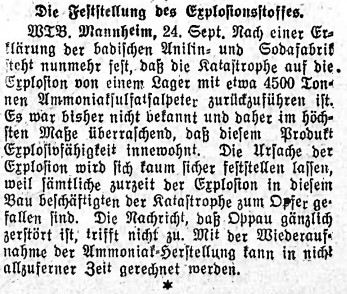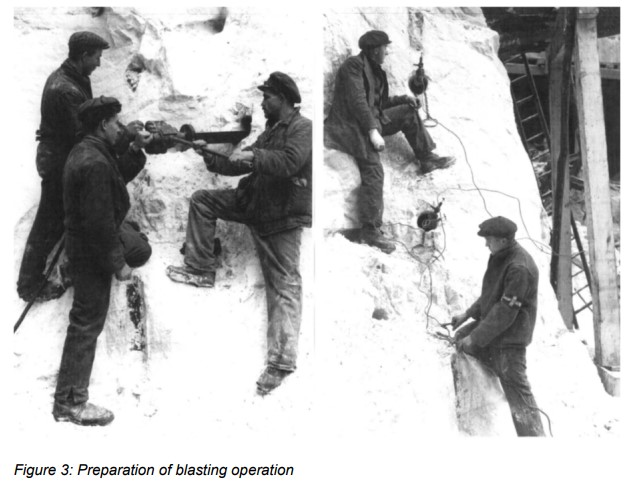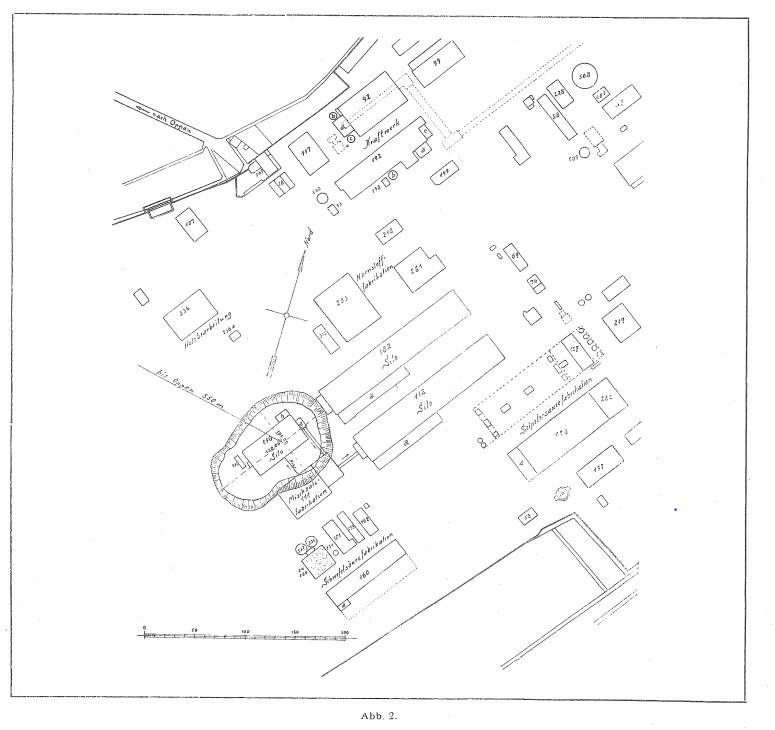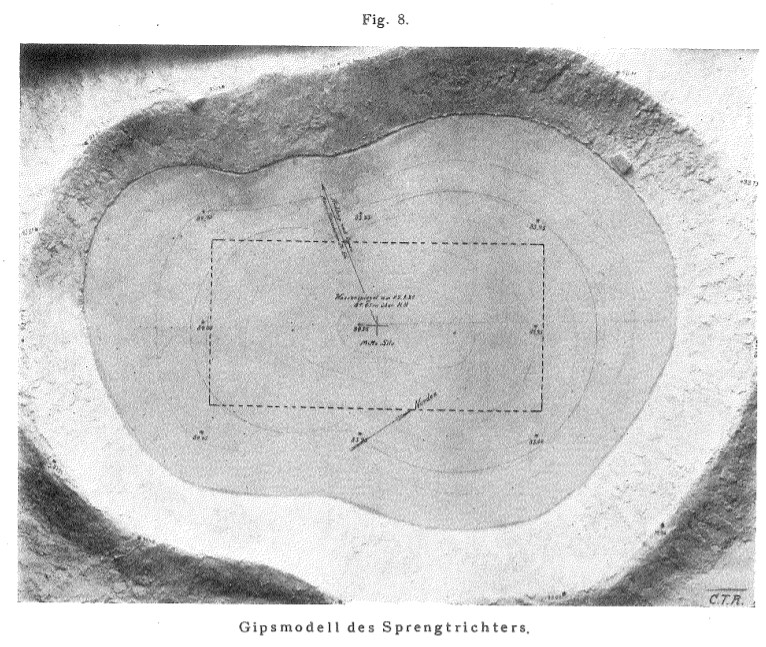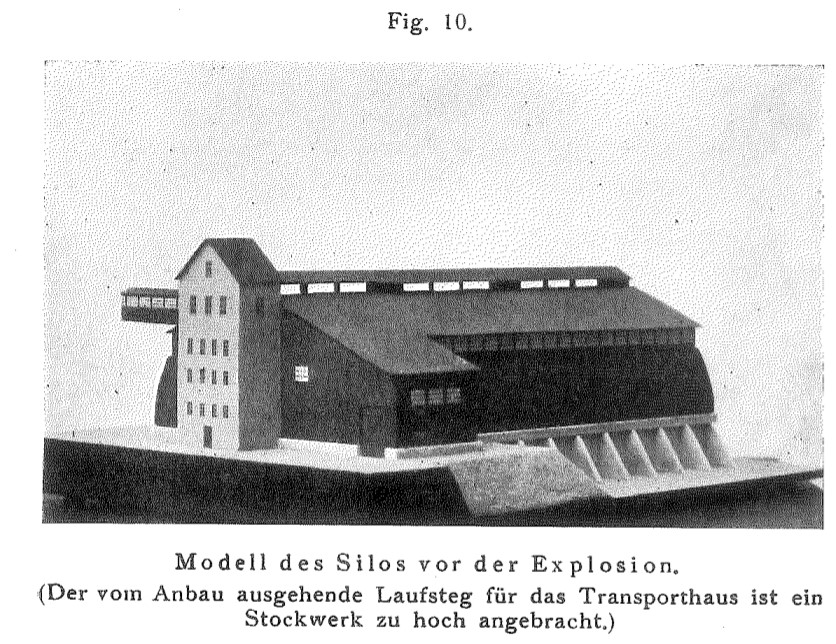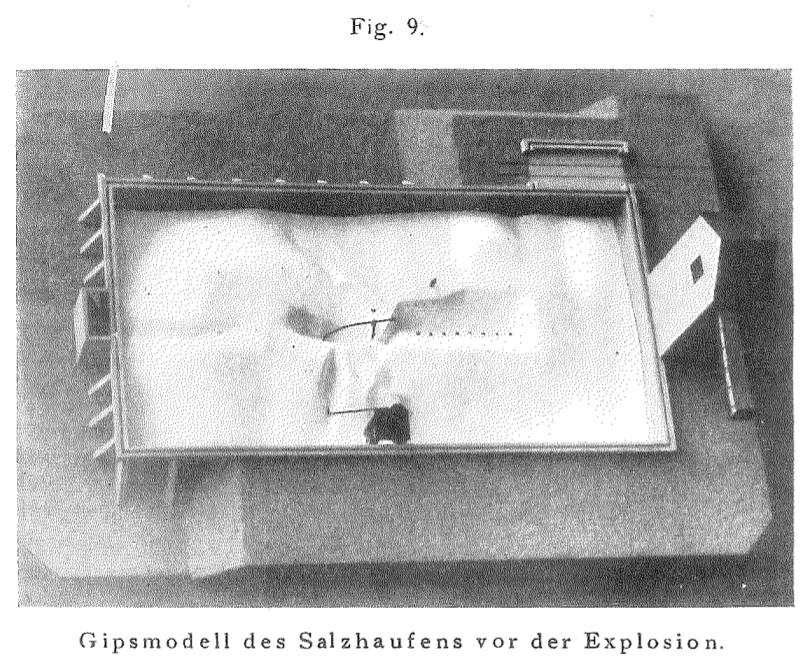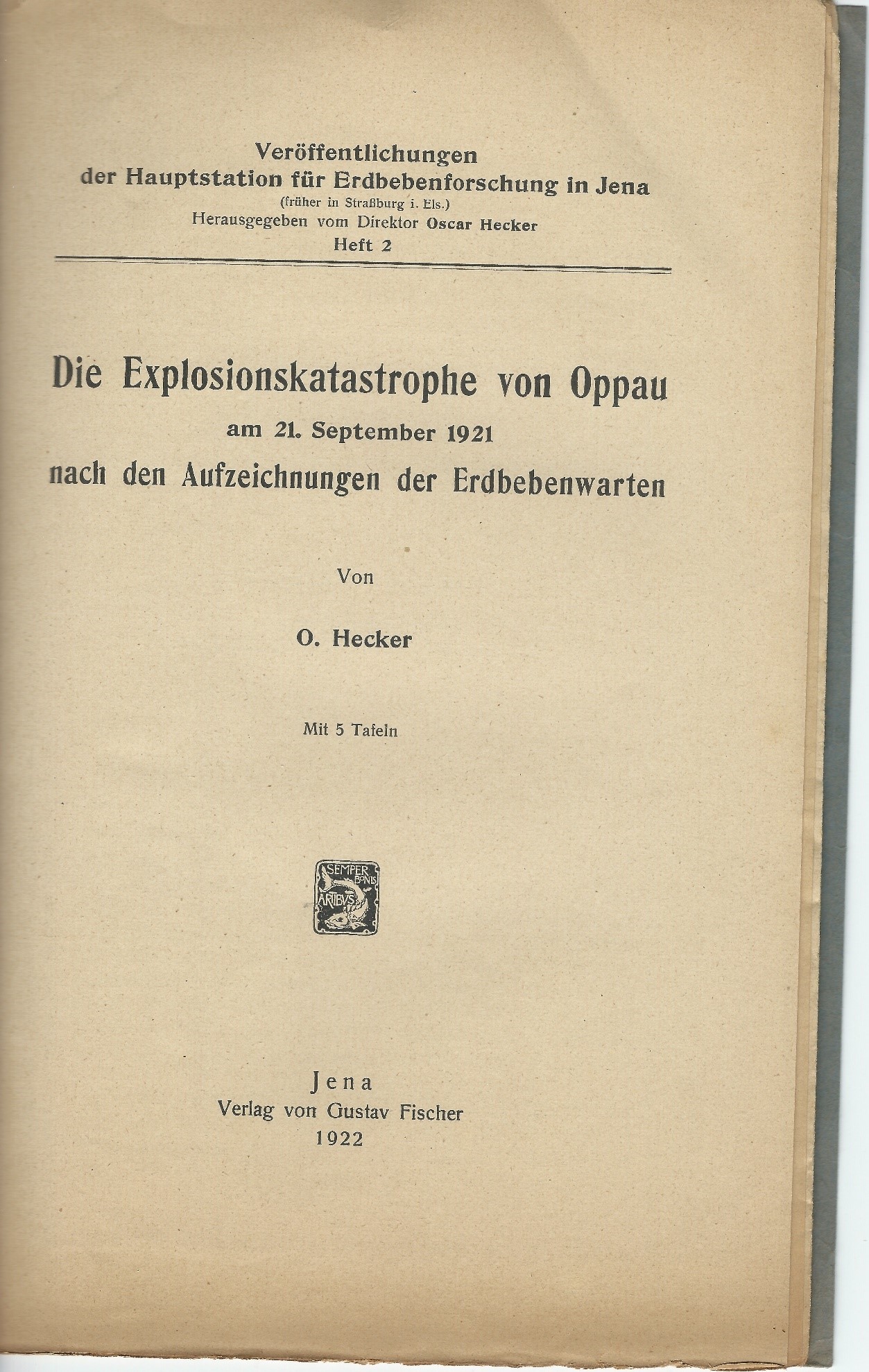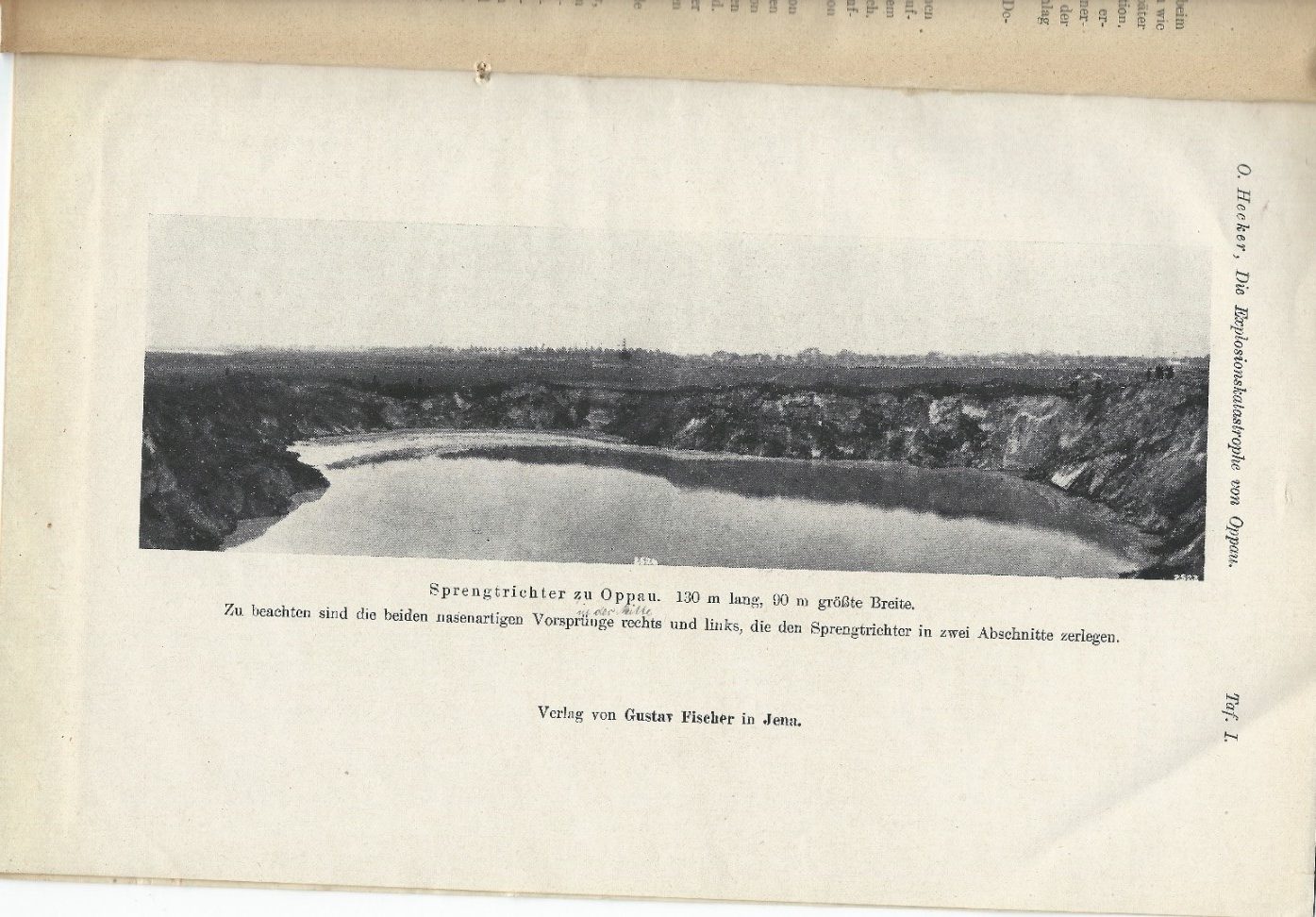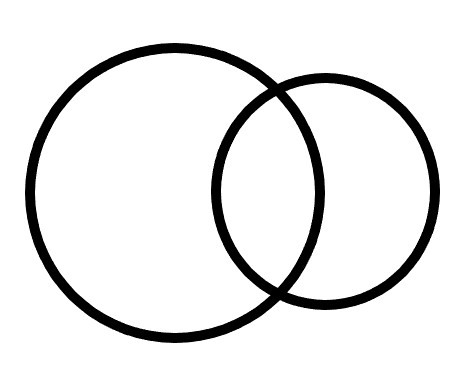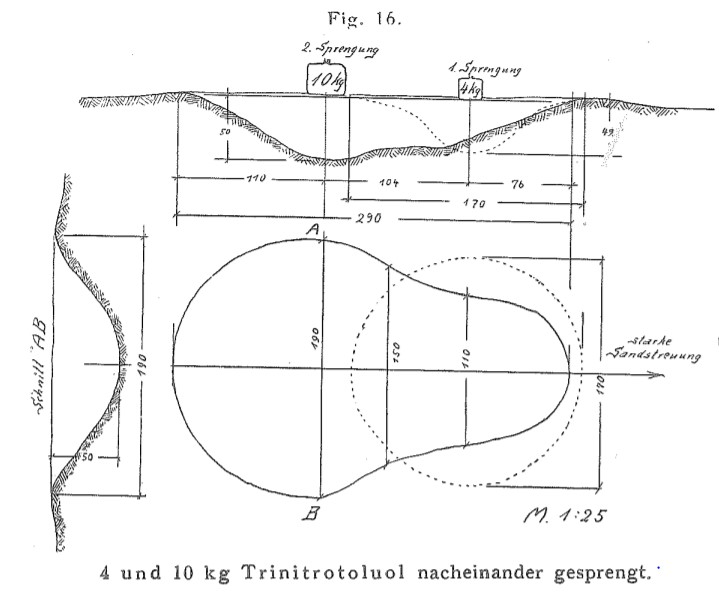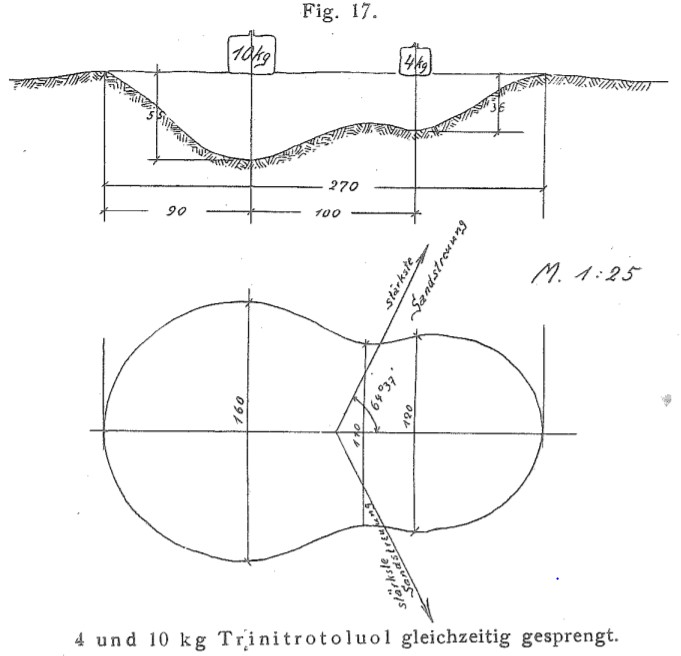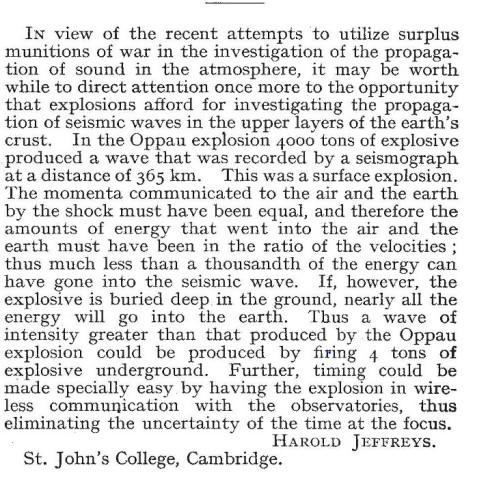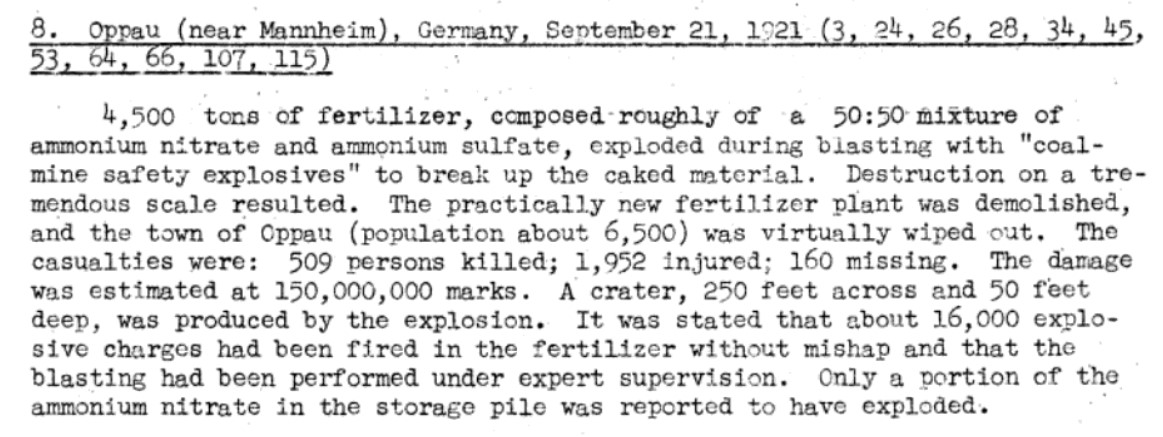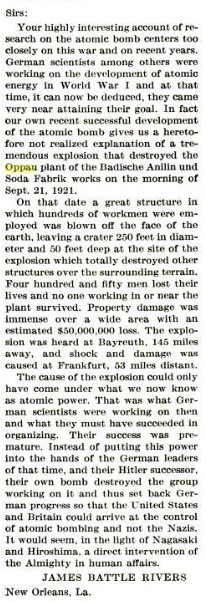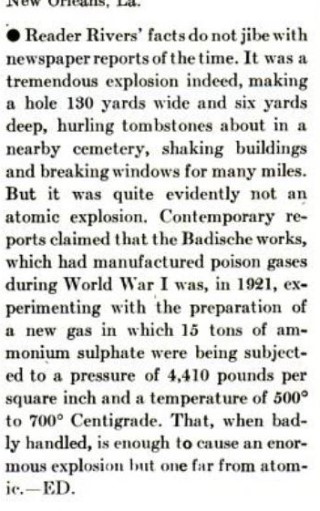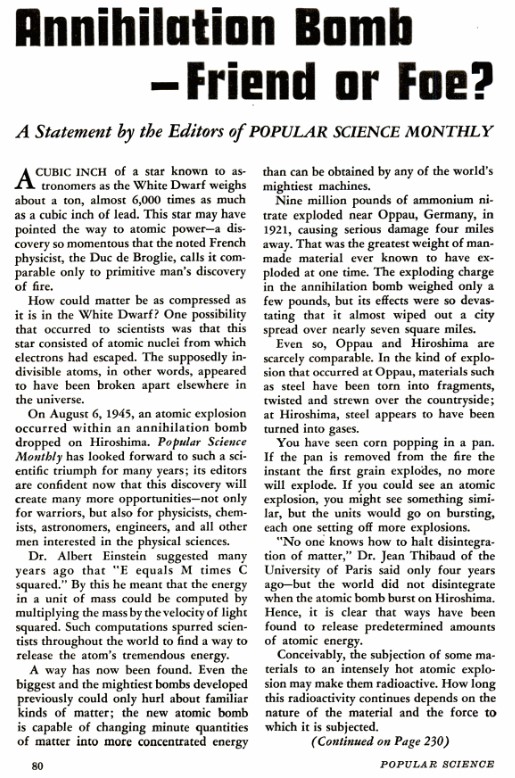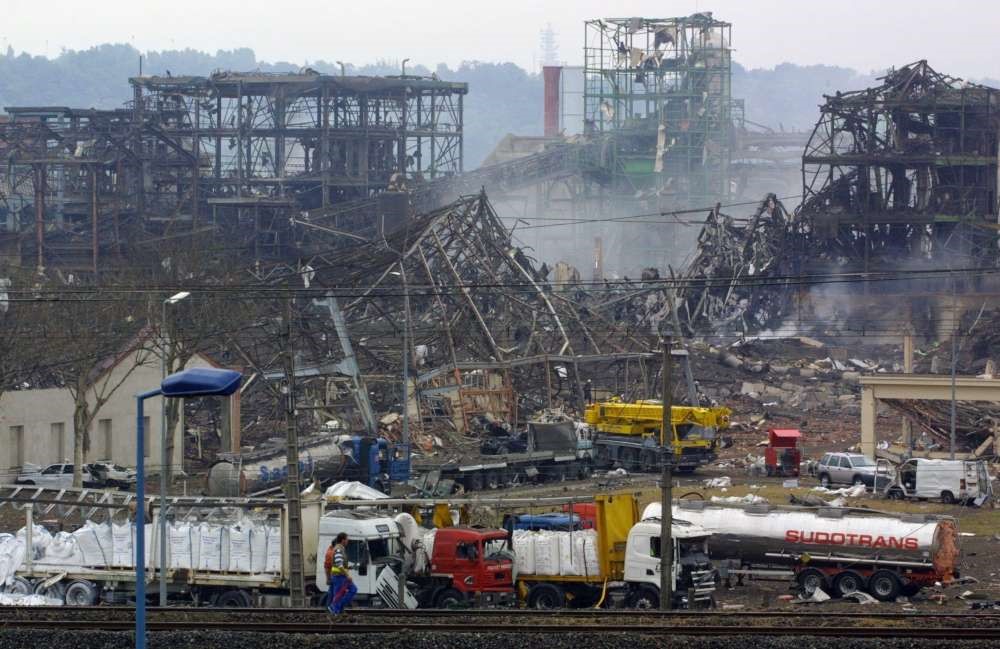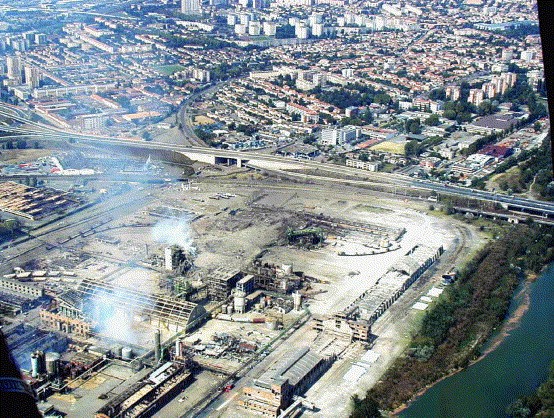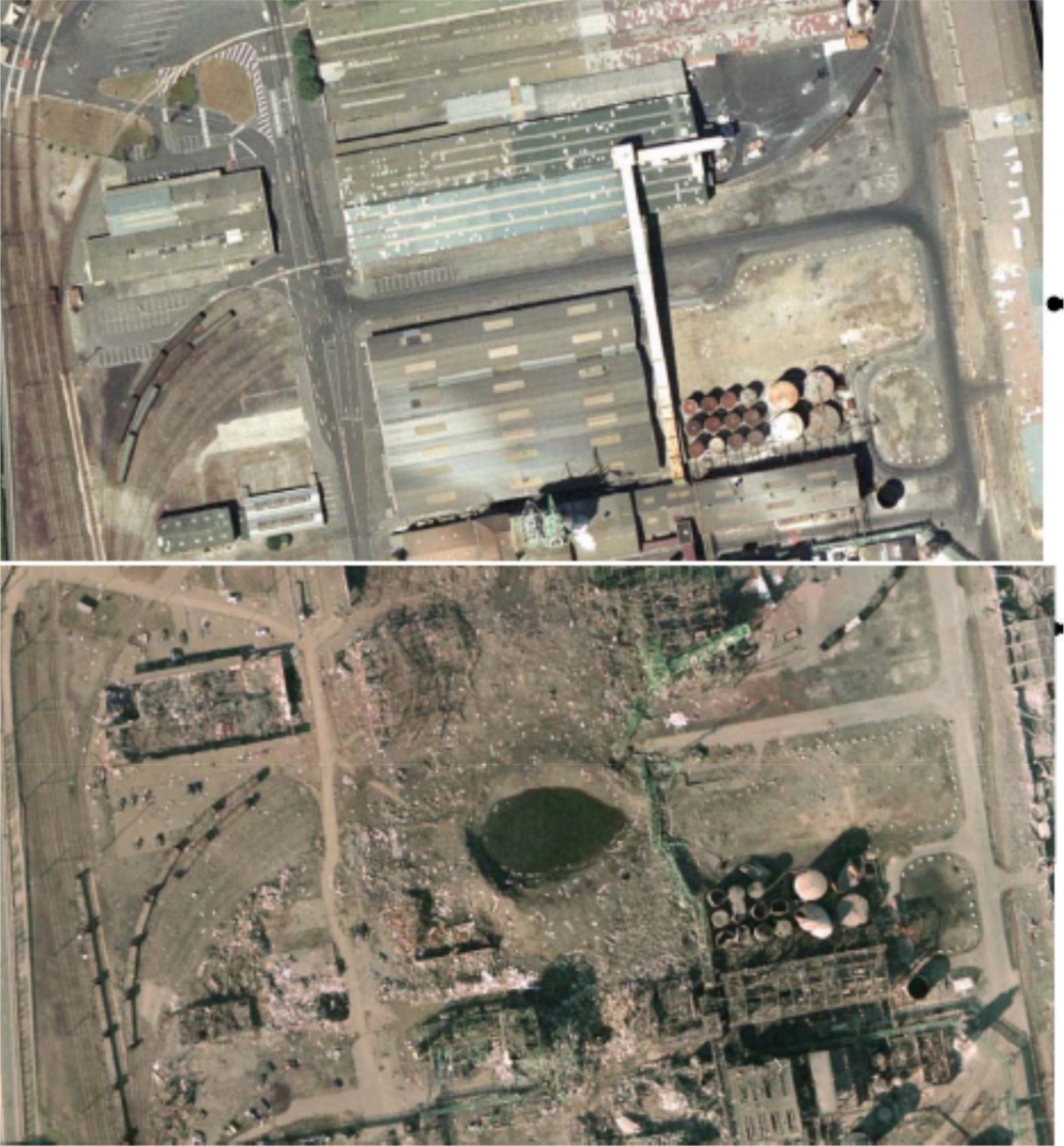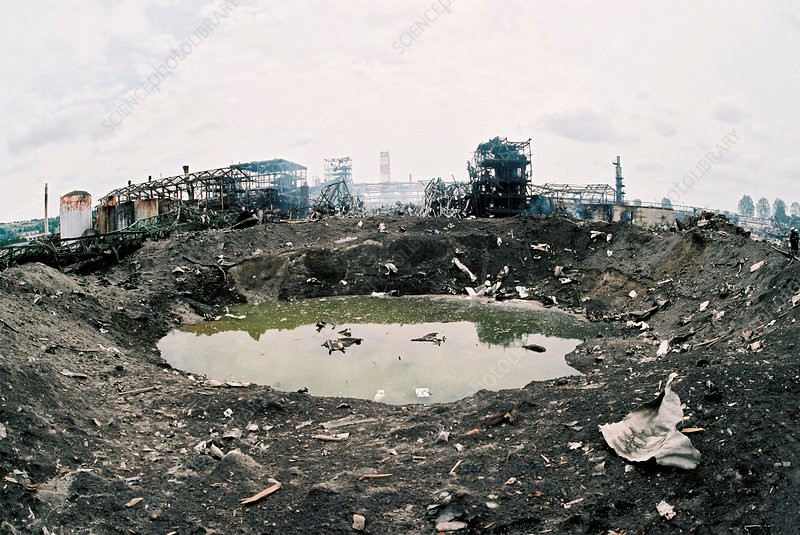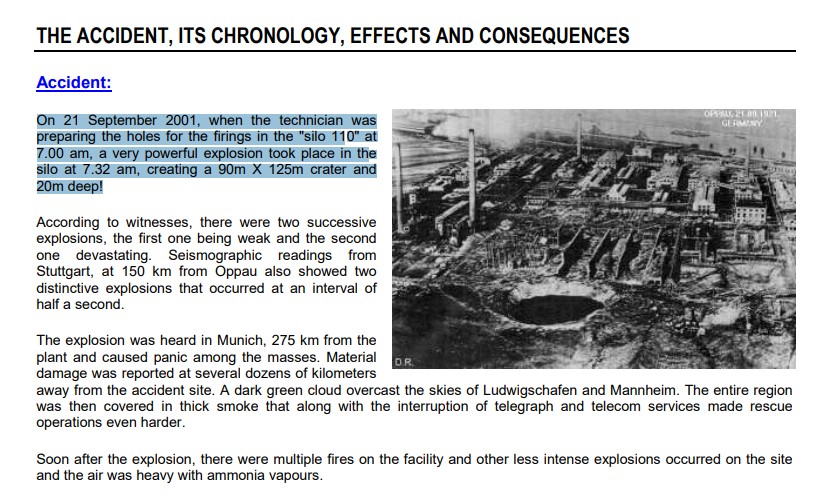On the occasion of the 100th anniversary in September 2021 the German magazine Der Spiegel wrote that what happened at the Badische Anilin- & Sodafabrik (hereafter BASF) facility in Oppau at 7:32 a.m. on 21 September 1921 was “bis heute größte Explosionskatastrophe der deutschen Geschichte” (“still considered the largest explosion disaster in German history”) in which 559 people died and nearly 2,000 were injured. 1
Even if some reporters tended to embellishment: the two detonations that followed each other in quick succession reached the force of a small atomic bomb, and according to eyewitnesses, their rumble could be heard as far away as Zurich, Göttingen and Munich. In Heidelberg, 25 kilometers to the east, the pressure wave blasted houses, smashed windows and lifted a tram from the rails; even in Frankfurt, 80 kilometers away, windows were broken. 2
Several news accounts reported that people in Oppau and Mannheim had rushed out of their homes thinking there was an earthquake. 3 Fritz Haber (1868-1934) – inventor of the process of producing ammonia (NH3) by reacting atmospheric nitrogen (N2) with hydrogen (H2) using a metal catalyst under high temperatures and pressures that was scaled up by Carl Bosch (1874-1940) — Chairman of BASF’s Board of Executive Directors from 1919 to 1925 and IG Farben from 1925 to 1935 — at the BASF Oppau facility for industrial-level production (work for which both Haber and Bosch would eventually win Nobel Prizes in Chemistry) – was reported in the New York Times as saying
I myself felt the explosion at Frankfort. It was equivalent to an earthquake. It could have been caused only by an explosion of heavy materials, not gases. Materials made out of air by my processes have never been known to explode. We thought they would not explode. Yet the fact faces us even in the seismographic records. From studying the causes we may discover something new in explosive forces. 4
But the images that always sticks in people’s minds about the Oppau disaster are photographs of the huge crater that marked the precise site of the explosion site. On September 24, 1921, the London Daily Mirror published this two-page photo spread titled ”Once a Factory: Now a Mighty Crater Slowly Filling with Water: The Scene of the Disastrous Explosion at Oppau” that captures better than any subsequent photo the immense size of the crater in contrast to the size of the people standing on the crater lip. 5
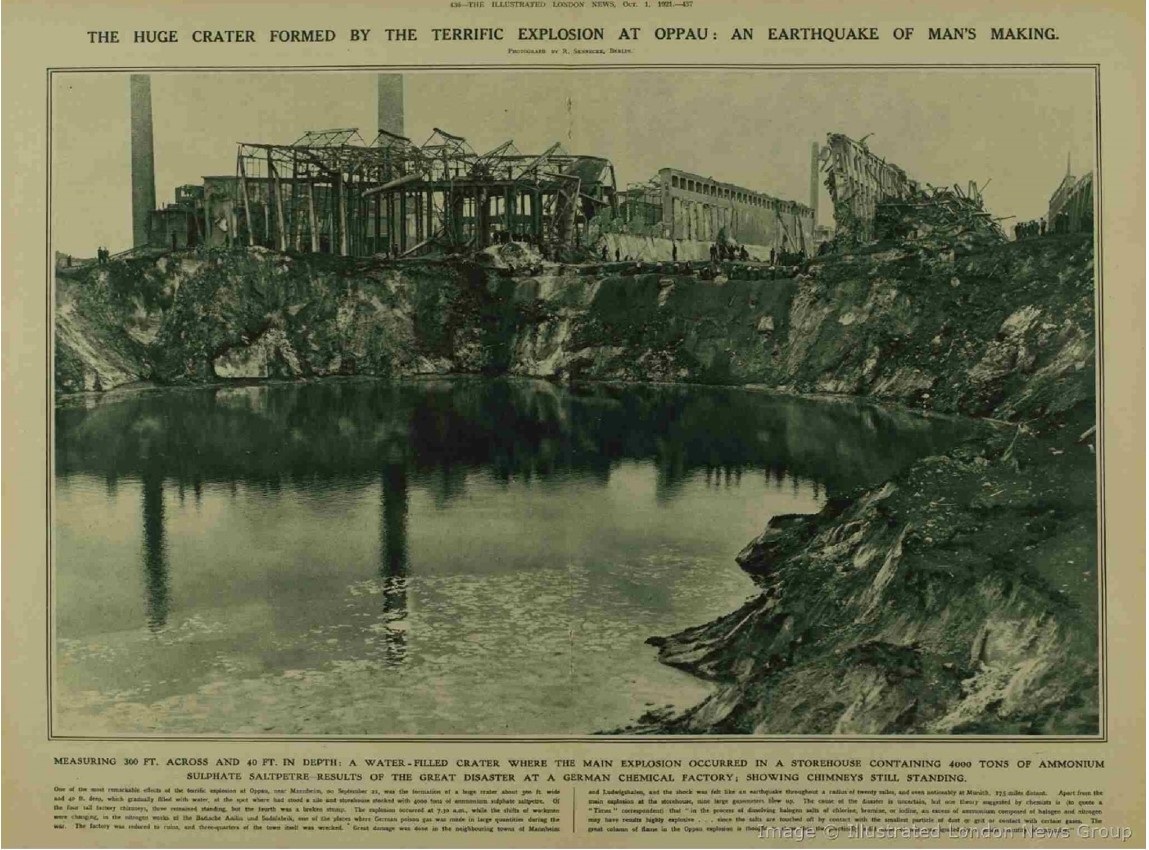
Here’s another view published in Illustrated London News on 1 October 1921. 6
But the most iconic image of all the Oppau images is this aerial photo that was taken by a pilot from the French airline Compagnie Aérienne Française and first published in the October 1, 1921 edition of the French weekly newspaper L’Illustration and later published over and over in newspapers and magazine all around the world. 7
The caption reads:
Vue Aerienne de l’Usine de la “Badische Anilin und Soda Fabrik”, a Oppau, aprés la Formidable Explosion du 21 Septembre
Au premier plan, le cratére formé par la mystérieuse déflagration et à demi rempli d’eau par les canalisations rompues et par les infiltrations souterraines; au delà, les bâtiments rasés ou défoncés; a l’arrière-plan, le Rhin
Photographe pris d’un avion specialment envoyé sur les lieux pour L’Illustration, par la Compagnie Arienne Française – Tous droits réservé.
Aerial View of the Factory of the “Badische Anilin und Soda Fabrik”, in Oppau, after the Formidable Explosion of September 21
In the foreground, the crater formed by the mysterious explosion and half-filled with water from broken pipes and underground seepage; beyond, the razed or smashed buildings; in the background, the Rhine
Photograph taken from a plane specially sent to the scene for L’Illustration, by the Compagnie Arienne Française – All rights reserved.
This cropped version of the iconic aerial photo was published in the October 8, 1921 edition of Illustrated London News. 8
The aerial photo was republished in numerous American newspapers and even made its way into the December 1921 issue of Popular Mechanics Magazine (see above). 9
In the last twenty years, this iconic 1921 aerial photo from Oppau has again become familiar, showing up following every major “ammonium nitrate” warehouse explosion: Toulouse in 2001; Tianjin in 2015; and Beirut in August 2020. Indeed, juxtaposed next to photos from each of these latter-day disasters, each with their own prominent crater (albeit with the Beirut crater invaded by the sea) amidst the devastation, the Oppau photo is quite striking for its similarity.
Toulouse 2001 10
Tianjin 2015 11
Beirut 2020 12
Anyone looking at these photos would surely imagine that understanding what happened at Oppau in 1921 might be very helpful for what happened in these later disasters. Indeed, “experts” have used Oppau as a precedent for their explanations of these latter-day disasters. In turn, current theorizing about these latter day “ammonium ntirate” explosions has reinforced what has become the “official” explanation of the Oppau explosion. 13
In this chapter and the next chapter we are mainly interested in a question that the “experts” both 100 years ago as well as today barely addressed: Could the “official” story really be right? Could the explosion of the contents in Building 110 – whether 450 metric tons or 4500 metric tons of Ammonsulfatsalpeter – today commonly called in English “ammonium sulfate nitrate” (hereafter ASN) really have blasted such a large crater? More generally could any large aboveground explosions truly blast such a large crater? 14
These are obviously NOT just 100-year-old questions. Indeed, as we have already shown with our analysis of the 1995 Oklahoma City bombing and discussion of truck bombs in general in Chapter 1, ferreting out the answer to these questions raises serious issues with our misplaced trust in so-called “experts” to reveal the truth about ANY major explosive event, past or present.
Early BASF Press Releases
If you thought reporting about the 1995 OKC explosion was all over the place, that was nothing compared to reporting about the 1921 Oppau bombing where we are talking about order of magnitude differences. From Day One to the present, accounts about Oppau regularly confuse any distinction between how much ASN was stored in Building 110 at the time of the explosion and how much ASN actually exploded. Although many articles referred to the amount stored and others referred to the amount exploded, there was really no distinction in any newspaper account, a confusion that persists to the present 100 years later.
Two wildly contradictory press releases from the BASF directorate on the day of the explosion–contradictions that have never been explained–set the groundwork for this confusion. According to the earliest BASF press release:
MTB. Ludwigschafen, 21. Sept. Die Direktion der Anilinfabrik teilt solgendes mit: Es ist nunmehr einwandsfrei sestgestellt, dass die Explosion im Oppauer Werke auf einer Explosion von 4000 Tonnen Amonsulfatsalpeter beruhte. Bevor zur Lagerung dieser Produikte geschritten wurder, war das Pulver sowohl in der Anilinfabrik als auch anderwärts eingehend untersucht worder, so dass mit einer Explosion in keiner Weise gerchnet werden konnte. Ueber dienäheren Umstände der Entstehung der Explosion ist die Untersuchung im Gange. Bis zur Stunde ist die Zahl der Toten und Derwundeten noch nicht festzustellen.
[MTB. Ludwigschafen, September 21. The management of the aniline factory reports the following: It has now been established with absolute certainty that the explosion in the Oppau works was based on an explosion of 4,000 tons of ammonium sulphate nitrate. Before these products were stored, the powder had been thoroughly examined both in the aniline factory and elsewhere, so that an explosion was in no way to be expected. Investigations are underway into the circumstances of the origin of the explosion. Up to the present hour the number of dead and wounded has not yet been determined.] 15
On that very same day – the day of the explosion – BASF issued another press release with quite similar wording, claiming again with absolute certainty, not that 4000 Tonnen (metric tons) of ASN had exploded, but that there was 4000 Zentner of ASN in the silo. A German Zentner – translated into English variously as “centner”, “quintal” and “hundredweight” – was equivalent to 50 kilograms, so 4,000 Zentner was equivalent to 200,000 kg or 200 metric tons, an order of magnitude different from 4000 metric tons! Furthermore, the 4000 Tonnen statement claimed 4000 metric tons of ASN had actually exploded whereas the 4000 Zentner statement merely claimed that the explosion happened in a storage building that had 200 metric tons of ASN, NOT that 200 metric tons of ASN had actually exploded. 16
The table below compares and contrasts the two BASF press releases (both the original German and an English translation) from 21 September 1921, with identical passages highlighted in yellow and key differences in blue.
17|
Es ist nunmehr einwandsfrei festgestellt, daß die Explosion im Oppauer Werke auf einer Explosion von 4000 Tonnen Amonsulfatsalpeter beruhte. Bevor zur Lagerung dieser Produkte geschritten wurde, war das Pulver sowohl in der Anilinfabrik als auch anderwärts eingehend untersucht worden, so daß mit einer Explosion in keiner Weise gerchnet werden konnte. Ueber die näheren Umstände der Entstehung der Explosion ist die Untersuchung im Gange. Bis zur Stunde ist die Zahl der Toten und Derwundeten noch nicht festzustellen.
|
Es ist nunmehr einwandfrei festgestellt, daß die Explosion im Oppauer Werk in einem Lager stattgefunden hat, in dem 4000 Zentner Ammonsulfatsalpeter lagerten. Bevor zur Herstellung und Einlagerung dieses Produkts geschritten wurde, war es sowohl in der Anilinfabrik als auch anderwärts eingehend untersucht worden, so daß eine Explosionsgefahr für vollkommen ausgeschlossen galt. Ueber die näheren Umstände der Entstehung der Explosion ist die Untersuchung im Gange. Bis zur Stunde ist die Zahl der Opfer an Toten und Berletzten, da das Unglück in die Zeit des Schichtwechfels fiel, noch nicht festzustellen.
|
|
It has now been unequivocally established that the explosion in the Oppau works was based on an explosion of 4,000 tons of ammonium sulphate nitrate. Before these products proceeded to storage, the powder had been thoroughly examined both in the aniline factory and elsewhere, so that an explosion could not be expected in any way. Investigations are under way into the exact circumstances of the origin of the explosion. At this time the number of dead and wounded has not yet been ascertained.
|
It has now been unequivocally established that the explosion in the Oppau factory took place in a storehouse in which 4,000 hundredweight of ammonium sulphate nitrate were stored. Before this product proceeded to manufacture and storage, it had been thoroughly examined both in the aniline factory and elsewhere, so that the risk of explosion was considered to be well excluded. Investigations are under way into the exact circumstances of the origin of the explosion. At this time the number of dead and injured, since the accident happened at the time of the shift change, has not yet been ascertained.
|
In the Sept. 22, 1921 edition of the New York Times, reporter Cyril Brown covered both press releases. He refers to the early press release in writing “Directors of the company are quoted as saying that the explosion occurred in a storehouse containing 4,000 tons of nitrous sulphates, which had previously been examined and were believed to be free from danger of explosion.” (Note: Brown mistakenly reports here that directors had said merely that the storehouse contained 4,000 tons of “nitrous sulphates” whereas BASF in the first press release stated that 4,000 tons of ASN had actually exploded.) But in the same article, referring to the later press release, Brown claimed “A late statement issued by the management of the Oppau factory says that the explosion occurred in a reservoir containing 200 tons of ammonium sulphate.” 18
Some articles in other newspapers, seemingly mixing reports from different sources, mentioned both 4,000 tons and 4,000 hundredweight (or 200 tons) with no recognition of any incongruity. 19
But neither the 4,000 tons ASN exploded nor the 200 tons ASN in the storehouse would last more than a couple of days. A third BASF press release, dated September 23, 1921, proclaimed 4,500 metric tons was in the storehouse and that claim would become the “official” number that BASF has stuck with to this day.
According to this much more detailed press release published in the Oct. 4, 1921, issue of Zeitschrift für angewandte Chemie, BASF drew up an announcement dated September 23, 1921, in which they claimed
Nach den Ergebnissen der durchgeführten Untersuchung steht nunmehr fest, daß die Katastrophe im Oppauer der Badischen Anilin- und Sodafabrik auf die Explosion eines Lagers von etwa 4500 Tonnen Ammonsulfatsalpeter zurückzuführen ist.
[According to the results of the investigation, it is now certain that the catastrophe in Oppau of the Badische Anilin- und Sodafabrik can be traced back to the explosion of a store [Lager] of around 4,500 metric tons of ammonium sulphate nitrate.] 20
Although dated September 23, it is unclear when this BASF press release was first made public.
A summary of the Sept. 23 BASF press release was published at least as early as Sept. 26, 1921 in Breisgauer Nachrichten. 21 The Oct. 2, 1921 issue of Zeitschrift für das gesamte Schiess- und Sprengstoffwesen published what appears to be the entire September 23 “final” press release although this version of the statement curiously did not include the etwa (“around”) in “etwa 4500 Tonnen” suggesting the amount of ASN in the store was NOT “around” 4500 tons but EXACTLY 4500 tons of ASN. 22
The September 23rd BASF press release differs from both press releases of two days earlier in some interesting ways. First, where BASF had asserted both 4,000 Tonne and 4,000 Zentner with “absolute certainty”, now BASF only states that “according to the results of the investigation” 4,500 Tonnen is merely “certain.” Whereas the previous statements had claimed either “an explosion of 4,000 tons of ASN” or “the explosion in the Oppau factory took place in a storehouse in which 4,000 hundredweight of ASN were stored,” the September 23 press release states more obscurely “die Explosion eines Lagers von etwa 4500 Tonnen Ammonsulfatsalpeter” (“the explosion of a store [Lager] of around [etwa] 4,500 metric tons of ammonium sulphate nitrate”). In the earliest reports Lager had clearly referred to Bau 110 where BASF claimed the ASN was stored. But, in the September 23rd press release, by using the preposition “von” rather than “mit” with Lager, BASF now “seemed” to be using Lager to refer to the “store” or “stock” of ASN that was reportedly inside Bau 110, NOT Bau 110 itself. Although the new wording still seemed to leave open the possiblility that not all the store of ASN exploded, saying the “stock” of ASN exploded certainly seems to suggest the entire stock of 4,500 tons of ASN exploded more strongly than merely claiming that the “storehouse” exploded. It appears to me that BASF wanted a statement with more wiggle room that was closer to the first press release (albeit with 4000 tons bumped up to 4500 tons) without outright claiming that 4500 tons of ASN had actually exploded.
All three BASF press releases proclaimed – as the company maintained in the days, months and years following and continues to maintain to this day – that there had been no inkling that the ASN was explosive. Indeed, the September 23 press release reported that the company admitted regularly using explosive charges to loosen hardened ASN but could not see how that practice could have possibly have caused the explosion of the ASN. That’s how non-explosive BASF believed ASN to be.
Die beiden Produkt Kaliammonsalpeter und Ammonsulfatsalpeter haben deshalb bisher als derart ungefährlich gegolten, daß man seit Jahren in allen damit arbeitenden Fabriken bei Entspeicherung dieser Produkte festgewordene Blöcke dieser Salze gesprengt hat, ohne daß dabei jemals irgendwelche verdächtige Erscheinungen festgestellt worden wären.
[The two products potassium ammonium nitrate and ammonium sulphate nitrate have so far been considered to be so harmless that solid blocks of these salts have been blasted in all factories working with them for years without any suspicious phenomena ever being detected.]
The Oct. 6, 1921, issue of Der Echo reported 20,000 such loosening explosions had previously been carried out in Oppau and elsewhere without anything untoward happening, including two days earlier in the same Lager (clearly here referring to the “storehouse” rather than the “stock”) and a witness had testified “on the day of the accident a demolition was being prepared in the fateful storehouse [Lager] that contained 4500 tons of the fertilizer salt.”
Wohl sind festgewordene Blöcke des Salzes zum Zwecke der Zerkleinerung gesprengt worden, es sind aber vorher an 20 000 solcher Sprengungen in Oppau und anderwärts ausgeführt worden, selbst noch zwei Tage zuvor in demselben Lager von demselben Sprengmeister, ohne dass irgenwie mehr passiert wäre, als dass die Blöcke zerkleinertt wurden.
Ein Zeuge, der sich nachträglich gemeldet hat, bekundete, dass am Unglückstage eine Sprengung in dem verhängnisvollen Lager vorbereitet wurde, das 4500 Tonnen des Düngesalzes enthalten hat, aber dieser Umstand an sich gäbe nach dem Vortstehenden nuch keinen genügenden Hinweis auf die Ursache des Unglücks.
[Blocks of salt that had solidified were indeed blown up for the purpose of crushing, but 20,000 such explosions had previously been carried out in Oppau and elsewhere, even two days earlier in the same storehouse [Lager] by the same demolition expert, without anything more than that having happened the blocks were crushed.
A witness who reported afterwards testified that on the day of the accident a demolition was being prepared in the fateful storehouse [Lager] that contained 4500 tons of the fertilizer salt, but this fact in itself does not give sufficient indication of the cause of the accident after the above.] 23
Figure 3 shows photos of what must have been a common sight of workmen preparing the ASN for blasting. 24
The September 23rd BASF press release also acknowledged there had actually been TWO explosions on September 21, “first a weak one and a few seconds later a very strong one, to which the latter is due the devastating effect of the catastrophe.” 25
Even before the BASF acknowledgement, newspapers in the days after the Oppau explosion had already reported on the “two blast in close succession” that could be heard as far away as Karlsruhe and Frankfurt. 26 Some newspapers added that seismographs in Stuttgart and other German cities had detected “two distinct shocks, the second more violent than the first.” 27
Whether it was the intention of BASF or not, their September 23rd press release announcement that the explosion happened in a “stock” of 4,500 metric tons ASN quickly transformed into categorical statements that 4,500 metric tons ASN had ACTUALLY EXPLODED. This first comes across in English translations.
The first appearance (that I have found) of the 4,500-ton announcement in English was a brief notice in the October 5, 1921 issue of the Chemical & Metallurgical Engineering magazine that claims it got its information from a Reuters cable from Berlin that stated that the Oppau disaster “was caused by the explosion of 4,500 tons” of ASN, without even the qualifying “around” 4500 tons. 28
As far as I can discern, the Reuters cable was not picked up by the New York Times or, indeed, any American newspaper. Indeed, the only American newspaper that I have found that actually reported accurately the information in the September 23rd BASF press release was the German-language New Yorker Volkszeitung! 29 However, quite a few American trade journals reported, like the Chemical & Metallurgical Engineering journal, that the Oppau catastrophe was caused by the explosion of 4,500 tons of ASN (again with no recognition of any distinction between U.S. and metric tons). 30
I have only found a couple of English translations of the BASF September 23 press release that did not come right out and declare that 4,500 tons of ASN exploded. First, on October 27, 1921, the prestigious British journal Nature published a summary based on the version of the BASF press release in the October 4 issue of Zeitschrift für Angewandte Chemie, translating the passage in question as the explosion “took place in a store containing about 4500 tons of ammonium sulphate nitrate.” By “store” Nature certainly chose an appropriate equivalent to the German Lager, but both English and German terms unfortunately leave open the question whether the term is referring to a “storehouse” or “stock” because “store” like Lager can mean either. Whereas the German phrase “die Explosion eines Lagers von” suggests the BASF press release was referring to “the explosion of a a stock of” ASN, the English phrase “took place in a store containing” is much more ambiguous sincs “store” could refer to either a “storehouse” or a “stock.” If “store” is taken in the sense of “storehouse,” it leaves even more open the impression that not all of the 4500 tons of ASN might have exploded. 31
Second, the October 31, 1921, issue of Journal of the Society of Chemical Industry published its own English translation of the September 23 BASF press release as well as a detailed summary of additional news from Germany about the Oppau explosion, reporting
The cause of the disaster, it is stated, has definitely been traced to the explosion of a store of 4500 tons of “Ammonsulfatsalpeter.”
The choice of “a store of” rather than Nature’s “a store containing” seems a much better translation of the Sept. 23 BASF press release, although one notes the JSCI dropped the point that it was AROUND, not exactly 4500 tons. 32
One should note that the problem of claiming 4,500 tons ASN actually exploded was not just restricted to English-language articles. Eugen Rugel in his book Die Katastrophe von Oppau (published in October, 1921) asserted on the first page that “4500 Tonnen Ammon-Sulfat-Salpeter, die dort lagerten, flogen in die Luft” [“4,500 tons of ammonium sulphate nitrate stored there blew up”]. 33
Investigations
Following the Oppau explosion, in addition to a judicial investigation, both the Bavarian state parliament & the Reichstag of the Weimar Republic formed commissions to investigate the causes of the explosion. The Reichstag commission appointed a number of German explosives “experts” (Sachverständigen) including Emil Bergmann (1857-1922), Hermann Kast (1869-1927), Fritz Lenze (1866-1946), Alexander Gutbier (1876-1926), Ernst Richard Escales (1863–1924), and Lothar Wöhler (1870-1952). 34
In Great Britain the Chemistry Research Board of the Department of Scientific and Industrial Research (hereafter CRB) also carried out a substantial investigation at the Royal Arsenal and at the Government Laboratory, involving renowned scientists like Sir Robert Robertson (1869–1949), Sir Richard Threlfall (1861–1932), Sir William Henry Bragg (1862–1942), Arthur Francis Hallimond (1890–1968), Herbert Henry Thomas (1876–1935) and the Woolwich Research Department explosives and munitions specialist Godrey Rotter (1879– 1969). 35
“Taken together,” observes Tor Kristensen, ”the zenith of available expertise within energetic materials chemical technology in Europe at the time was summoned to clarify the actualities and causes of the Oppau explosion disaster.” 36
Specialist journals followed closely and discussed “the progress and results of the investigation” with at least 50 articles in 17 specialist journals from Germany (6), England (3), France (3), the United States (3), Holland (1) and Switzerland (1). 37
For all this effort, as the American journal Industrial and Engineering Chemistry concluded in June 1924 after reviewing the final report of the Reichstag commission, none of the “experts” could explain “the true cause of the disaster.” Although the “experts” agreed that the use of high explosives to break up the solidified ASN must have detonated the store of ASN in Silo 110, they could not come up with a good explanation for WHY the non-explosive ASN exploded. 38
As published in Verhandlungen des Reichstags, No. 6402, the final report of the Reichstag commission titled “Bericht des 34. Ausschusses zur Untersuchung der Ursachen des Unglücks in Oppau” (”Report of the 34th committee investigating the causes of the accident in Oppau”) dated December 13, 1923. 39
The main conclusions of the 34th Reichstag Committee were:
On September 21, 1921, a large quantity of fertilizer salt exploded in silo 110 in the Oppau plant of the Badische Anilin- und Sodafabrik in Ludwigshafen, causing enormous damage….The fertilizer salt is either a mixture or a double of ammonium nitrate and ammonium sulphate. The first substance is explosive, the second non-explosive. This fertilizer salt has the property of clumping when stored for a long time. In order to make it transportable, it was blown apart with certain explosives. At a time when such a blast was supposed to take place, the fertilizer exploded, and in fact two detonations took place, first a smaller one and about four seconds later a larger one….The committee did not consider it justified to draw any conclusions about the composition of the salt that had exploded in silo 110….For its part, the committee exclaims: the explosion in Oppau is one of those industrial accidents whose causes cannot be reliably determined by all efforts of investigation with the help of science and technology. 40
Nevertheless, the 34th Reichstag Committee noted, that based on the presumption that the blasting charges had set off the ASN explosion, the government authorities had banned the use of such blasting charges for breaking up fertilizer salts in order to prevent such a catastrophe happening again.
In order to prevent such an accident from happening again, the industrial prospecting authorities have ordered the demolition of the remaining stocks of ammonium sulphate of nitrate by blasting to be stopped. The shredding takes place mechanically during transport. In the meantime, the Reich Ministry of Labor has issued a police ordinance drawn up by the central inspection office for explosives and munitions factories on the treatment of storage facilities for fertilizer salts containing ammonium nitrate, which is intended to serve as a guideline for the trade inspectors. According to this ordinance, blasting may not be carried out either in the warehouses of the production sites or in the commercial warehouses. 41
“In order to assess the entire complex of investigations,” the 34th Reichstag Committee attached to their report the “Zusammenfassendes Gutachten der Sachverständigen des 34. Reichstagsausschusses zur Erforschung der Ursachen des Oppauer Unglücks” (Summarizing opinion of the experts of the 34th Reichstag Committee for investigating the causes of the Oppau accident) signed by Dr. Baumann, Bertram, Dr. Escales, Dr. Guthier, Dr. Kast, Dr. Kempf, Stöpel, and Dr. Wöhler, dated September 26, 1922, at Darmstadt, that Wohler later claimed to have written. 42
The ”experts” investigated the possibility that the spray-drying process for producing ASN begun in silo 110 in April 1921 might have produced a physical separation of the spray jet into fine ammonium nitrate (AN) and coarse ammonium sulphate (AS). Although the investigations offered “no support for the assumption of a physical separation of the spray jet into fine nitrate and coarse sulphate,” if the blast master Humpe had inadvertently detonated his explosive charges on September 21, 1921, in a pocket rich in the more explosive AN that could explain the first explosion. 43
The “experts” concluded that although all this scenario had only “a low probability” it still had “the greatest” possibility of all the scenarios considered.
Since all of these questions only ever concern possibilities, even if the answer is strongly positive, the main question remains, at what point can an answer be given with positive certainty and how can this answer further serve to answer the question of the cause of the accident?
A positive answer cannot be given to this. The formation of a layer richer in nitrate on the outside of the bunker, in which Master Humpe’s triggering shot demonstrably landed, has only a low probability, but of all the possibilities it is still the greatest. The nitrate enrichment only needed to be 10-15% nitrate beyond the double salt formation of 55%, but in a layer depth of at least 40-50 cm, in order to ensure sufficient confinement in the hazardous material – even pure nitrate requires good confinement—, and the limited detonability of a dry sulfate nitrate was thus given. Material that has become moist as a result of its hygroscopicity would call this possibility into question. It should therefore be repeatedly emphasized that this is only a possibility, the only one, as the cause of the accident, that the coincidence of such a connection cannot be assumed to be probable, but by no means certain. [Es sei daher wiederholt betont, daß dies nur eine Möglichkeit, die einzige, darstellen könnte als Ursache des Unglücks, daß die Zufälligkeit eines solchen Zusammenhanges auch gerade nicht als wahrscheinlich, keineswegs aber als sicher angenommen werden kann.] 44
On the other hand, as mentioned, the probability is very high that Master Humpe’s explosive shots were the cause of the accident, although it is certain that more than 20,000 times in similar material and at least many thousands of times in the same material in the silo 110 and in silo 112 was blown up without any particular observations. In any case, the entire silo 112 with sprayed material was cleared like this six weeks before the accident. 45
Since nitrate of ammonium sulphate is not dangerous, even if there is a normal risk of fire, the manufacture of nitrate of sulphate is in itself completely safe, even if the nitrate content of the double salt mixture accidentally increases. In any case, the only dangerous thing under certain circumstances is blasting in sulphate nitrate with explosives of the most varied kinds, especially when it is exposed and the salt is heavily dammed. If, in future, one refrains from effecting the comminution in a nitrate sulphate by blasting with explosives, as in general, based on experience, one must refrain in the future from technical blasting in nitrate-containing fertilizer salts, then the further manufacture of this fertilizer salt is opposed no objections from the safety point of view. Even the manufacture of pure ammonium nitrate, considering its special properties, especially in the event of a fire, offers no reason for a fundamental ban on manufacture. 46
Interestingly, most later references to the 34th Reichstag Committee report and the “Summarizing Opinion of the Experts” do not refer to the “official” report published in Verhandlungen des Reichstags, but rather to an article that Hermann Kast had published in the March 13 and March 20 editions of Chemiker Zeitung. 47These issues are unfortunately not available online as far as I can discover so I am not sure to what degree they are exact transcripts or just abstracts. An article in the April 18, 1924, edition of the journal Engineering states that the report was published in March 1924 and “An abstract of this appeared in the Chemiker Zeitung, March 13 and 20.” 48
British Investigation
The results of the British investigation into the Oppau catastrophe were presented at a meeting of the Faraday Society on April 14, 1924, with formal papers by Sir Robert Robertson and Godfrey Rotter. The papers—along with an introduction by Sir Richard Threlfall, attached appendices and a discussion section—were later published in Transactions of the Faraday Society. 49
Threlfall’s contribution was not merely an introduction to Robertson’s paper but also represented the summary opinion of the CRB that seemed to have a standing in official British circles comparable to the 34th Reichstag Committee in Germany. Threlfall states the CRB had reported their conclusions BEFORE the report of the official German committee of enquiry had been published but it is unclear whether he is referring to December 13, 1923, the date of the 34th Reichstag Committee report or some later date when the report was actually published.
Threlfall overall noted that the conclusions of the CRB and the 34th Reichstag Committee “agreed very closely.” 50 Employing the same kind of ambiguous use of the word “store” in the September 23rd BASF press release and the Nature article, he stated
The great explosion at the Oppau factory of the Badische Anilin and Soda Fabrik occurred on September 21st, 1921, on the site of a large store containing 4500 tons of the double salt ammonium sulphate-nitrate 51
Threlfall summarized the findings of Robertson and Rotter:
Sir Robert Robertson’s investigation of the physical condition, and the chemical composition of the double salt disclosed no circumstances which afforded a possible clue of the cause of the explosion. In particular, no evidence could be found in favour of suggestions which have appeared in the technical press, that the presence of certain impurities rendered the salt sufficiently unstable to be explosive. In the experiments carried out at Woolwich under the direction of Dr. Rotter, it was found impossible to detonate the salt, even under the most powerful compression and by the use of the most powerful initiators. 52
Thus, Threlfall stated the CRB,
after careful consideration of these results and of information obtained from other sources, finally came to the conclusion that it was impossible on scientific grounds to arrive definitely at the cause of the explosion. 53
However, like the 34th Reichstag Committee, the CRB reported that of all the “improbabilites” that might have caused the explosion, “the least extreme” improbability was
That through some oversight or accident there existed in the store large pockets of ammonium nitrate either unmixed with ammonium sulphate, or mixed with a proportion insufficient to prevent detonation. 54
Threlfall felt strengthened in this conclusion “one circumstance of material importance unknown to the Board” briefly mentioned in the 34th Reichstag Committee report.
It is stated that for some time previous to the explosion the practice of mixing the ammonium sulphate and nitrate in (saturated) solution before drying, had been replaced by the practice of squirting ammonium nitrate on to a conveyor band and adding solid ammonium sulphate by hand. If this is true, it certainly increases the possibility that large pockets of material containing too high a proportion of nitrate were present in the store. It is stated in the report that a mixture containing 70 per cent. ammonium nitrate is capable of detonation. 55
The passage in the 34th Reichstag Committee report that Threlfall is referring to states specifically:
The method used was such that the slurry mixture was squirted out of a nozzle. For 3 days the procedure was such that ammonium nitrate was sprayed onto the treadmill and the solid ammonium sulphate was added shovel by shovel. In this process, some of the ammonium nitrate could escape from the mixture, leaving residues in which the nitrate dangerously predominated.[7674]
One should note that this “circumstance” was curiously NOT mentioned in the “experts” report.
Furthermore, like the 34th Reichstag Committee, the CRB had to conclude that regardless of the cause of the Oppau catastrophe, the best solution to avoid another such catastrophe was to cease all blasting of the fertilizer salt.
The chief interest in the enquiry so far as this country is concerned, is as to the safety or otherwise of the double salt if used as a fertiliser. On this point the Woolwich experiments must be regarded as decisive for anything like reasonable quantities; but it must be presumed that neither in Germany nor elsewhere will blasting again be resorted to as a means of breaking up solid masses of the material. 56
What if Humpe’s Blasts Did NOT Cause the Oppau Explosion(s)?
Both the British and Germans considered alternative to the “official” conclusion that Humpe’s blasts caused the Oppau explosion(s).
Among the “three improbabilities” as to “the cause of the explosion,” Threlfall says the CRB considered the possibility
3. That a quantity of 50 to 100 tons of high explosive was concealed deliberately under the store, and that it was the explosion of this material which led to the disaster. 57
All we learn about this possibility is that the CRB must have considered it a “more extreme” improbability than their “large pockets” improbability. One wonders who and how they came up with 50-100 tons of high explosive and why they rejected this as a “more extreme” improbability. Was 50-100 tons of high explosive supposed to be equivalent to however much ASN they thought had exploded, an amount that they never present? Or was 50-100 tons of high explosive based on somebody’s judgment of the level of damage, the size of the crater, etc? Was the assumption in this scenario that NONE of the fertilizer salt exploded?
We learn a lot more about disputes among the German “experts” over “explosive” alternatives because of the German attempts to explain the TWO explosions and the PEAR-SHAPED crater, two pieces of evidence that the British at least publically did not concern themselves with.
For their part the Germans gave some serious effort to considering that Humpe’s blasts may NOT have caused the explosion.
“Direktor Guckel’s Theory”
In a later report published in 1925/26 on the work of the CTR in the Oppau investigation, Kast deals at length with attempting to identify the “cause of the two separately perceived explosions”.
Among the discussions of the experts, the treatment of the question of the origin of the two successive explosions observed by most of the eye and ear witnesses occupied a special place. Great importance was generally attached to answering this question because it could contribute significantly to clarifying the cause. Therefore, the speaker [i.e., Kast] on the basis of his many years of experience in test blasting and in explosions in explosives factories and warehouses, took on this question in particular and expressed the following in an expert opinion of the Chemical-Technical Reichsanstalt. 58
In a CTR report dated June 6, 1922 (excerpted in Kast’s 1925/26 report), Kast went over a list of eight possible explanations of “the origin of the two explosions separated by several seconds” that the CTR had considered. Kast readily dismissed six of the eight on various grounds, leaving only two explanations for serious consideration. 59
One theory (no. 6 in the list) Kast attributed to “Direktor Guckel” (also mentioned in the 34th Reichstag Committee report, see below) who argued that one could actually see evidence “that two locally separated explosions had taken place” in the shape of “the oblong shape of the crater, which had a constriction on both long sides,” supporting “the conclusion that there were two overlapping craters.” 60
Kast acknowledges
A complication in assessing the situation was the fact that, according to the sensory perceptions of eye and ear witnesses [Augen- und Ohrenzeugen], there were undoubtedly two detonations, first a weaker one and a few seconds later a stronger one, the last of which caused the main destruction, and it was therefore an obvious thought that two locally separate explosions had taken place, all the more so since the oblong shape [länglichen Form] of the blast crater [Sprengkrater], which had a constriction on both long sides, led to the conclusion that there were two overlapping craters [zwei überschneidende Krater]. 61
Although it is hard to see in the photos above this “narrowing in the longitudinal direction” that Guckel noted in the photos of the Oppau crater above, it was apparently obvious to all familiar with the exact shape of the crater.
As Kast notes, although there was some initial confusion over what had exploded, “the location of the blast crater [Der Ort des Sprengkraters] and the nature of the destruction left no doubt at first glance that a large explosion had taken place at the site of silo 110” as can be clearly seen in Figures 2 and 8. 62
Fig. 2 included in the 1925/26 report shows the outline of Building 110 surrounded by the superimposed contours of the oblong crater following the explosion. 63
The “oblong shape” and “constriction on both long sides” of the crater can clearly be seen in this image of the plaster model of the crater prepared by BASF (Figure 8) as well as the drawing of the site plan (Figure 2) that Kast included in his 1925/26 report. The oblong shape is also indicated by the dimensions of the crater reported by Kast with a width of 96 m and length of 165 m. 64
Whether Guckel intended it or not, Kast recognized that “Guckel’s theory” represented a major problem for the consensus view that Master Humpe’s blast had caused the initial smaller explosion.
6. Both explosions would have – as can be seen from the shape of the blast crater, which shows a narrowing in the longitudinal direction and was thus formed from two partially overlapping blast craters – as mentioned under 1., took place in silo 110; but it was the first, smaller explosion at the narrower part of the crater facing away from the factory, e. g. on the south side of the silo, the second, more powerful, occurred on the north side facing the factory, from which it appears that the explosion was not initiated by one of the explosive shells set off on the north side, but was attributable to another cause. 65
If the smaller explosion came several seconds before the large explosion and the smaller explosion was responsible for the smaller crater the whole “official” narrative falls apart because the smaller funnel was on “the south side” of silo 110 while, as Kast notes, Humpe was blasting in “the north side facing the factory.” So, if Guckel was right, there would be no way that Guckel’s blast could have been responsible for the initial explosion.
In the June 6, 1922, CTR report, Kast presents some arguments against “Guckel’s theory.”
It should be said about this that the special shape of the blasting crater can also be explained in other ways than by assuming that it was formed from two partially overlapping individual craters, namely by the fact that most of the salt is distributed over the two ends of the silo that the salt heap in the middle part was already severely degraded and low and that the cavity of the so-called bunker was at this point. A weaker effect must therefore appear here than at the two ends. Finally, it is also inconceivable that the two craters were formed one after the other, because the second larger explosion would have deformed the first partial crater beyond recognition. 66
“In addition, the drawing submitted by the Badische Anilin- und Sodafabrik cannot be used to draw the conclusion with certainty that the blasting crater really arose from two overlapping individual craters, especially when one considers that the earth was subsequently displaced on the crater walls, and that the ground on which the silo stood was mostly and not evenly filled. This was precisely the case at the point where the larger bulge of the crater is located, while on the other hand the southern end of the crater, which faces away from the factory, is less extensive because a large amount of the salt has demonstrably not exploded here. This is also evident from the investigations of the Bavarian Committee of Inquiry. In the report of this committee of January 3, 1922, it is stated in the final sentence that on the southwest side of the silo (at the location of the so-called, smaller crater) there was about 3000 t of strongly hardened salt, on the north side only 300 t of it. The rest would have been freshly sprayed, more easily explodable salt. 67
“In addition, the above theory contradicts the fact already discussed that the explosion of the silo occurred in two chronologically separated intervals.” 68
Figure 10 (from Kast’s 1925/26 report) is a model of the exterior of silo before the explosion. 69
What Kast is saying here is that the oblong shape of the crater reflected, NOT two consecutive explosions, but a single explosion of the explosible ASN in silo 110 that was NOT evenly distributed but heavily concentrated in the pile on the NE side of the building (to the right in Figure 9 which is a plaster model of the salt heap before the explosion prepared by BASF) with much smaller amount of explosive ASN in the pile on the SW side, with a constriction in between the two bulges due to the lower levels of ASN in the center. Kast also argues that if the larger explosion had happened a few seconds after the initial smaller explosion, “the second larger explosion would have deformed the first partial crater beyond recognition” so the two bulges was actually proof that “Guckel’s theory” was wrong.
With “Guckel’s theory” dismissed, Kast in the June 22, 1922, report argued that his own theory (no. 8 in the list) remained as “the most probable one.” 70
8. The two explosions are said to be the result of two separate explosive shots, which were set by the demolition engineer and ignited one after the other, with the first explosive shot causing a smaller, localized explosion in the salt storage which in turn put the remaining salt in a state, which was favorable to the production of a larger explosion, so that a second explosive shot, fired later, could produce a considerably greater effect than the first. 71
Kast does not offer much in terms of support for his hypothesis except to compare it to experience with delayed secondary explosions in ammunition dumps. He basically argues that Humpe must have had a row of 6-8 shots ready to go and one of those shots, although it was only “very limited and purely local, i.e., that it only extended to a few meters in the salt heap” put the remaining salt into a much more explosible state so that a subsequent shot in the row of 6-8 shots detonated a massive explosion (that blasted the oblong crater based on the distribution of the explosible salt).
It is based not only on mere guesswork, but also, for example, on much experience with explosions of ammunition dumps that even projectiles provided with initial ignitions do not immediately explode as a result of the violent shock of an explosion, but are thrown away and only detonate afterwards on impact at a distant point. If, for example, two explosive shots are fired at a distance from each other, and the salt layer surrounding the second explosive shot does not explode when the first shot is started, it can offer so much resistance to the simple mechanical shock of the first explosion that the explosive shot can be stopped after a while, regardless of the first one for ignition comes. A prerequisite for this explanation, however, is that the first explosion was only very limited and purely local, i.e., that it only extended to a few meters in the salt heap. This view is supported by the statements of the demolition technician Gentner, who states that as a rule six or eight shots were fired, which were 80-120 cm apart. The entire linear extension of the row of explosive shots was therefore no more than about 8-10 m, while the firing of the shots was measured in such a way that there was a period of one minute between the first and last shot, because it took about a minute to light the eight fuses and the fuse length was measured for a burning time of 2 minutes (= 120 cm). If one accepts the above assumption as correct, the theoretical possibility arose that between the first and second explosion there was not only a gap of four seconds, but even one of one minute.” 72
Although Kast’s 1925/26 report in describing Figure 9 does not say so, it seems likely that the eight dots that lie at the bottom of the depression that was referred to as the “bunker”( underneath which the conveyor belt ran taking ASN to silo 112) represents where Kast and others believed the row of shots was placed, with the first shot in the sequence starting closest to the center of silo 110.
Apparently, Kast’s arguments did not satisfy all of the “experts” because some of them started coming out in support of “Guckel’s theory” after the CTR report of June 6, 1922. One of leading “experts” of the 34th Reichstag Committee, Lothar Wöhler – who certainly would have understood the implications of making such a statement for the “official” narrative – om July 31, 1922, addressed a statement to the committee chairman leaning to Guckel’s view that “two explosive funnels, of which the smaller one to the southwest was created first, the other larger four seconds later.” 73 In addition, apparently at the instigation of Wöhler, on the same date Dr. ing. Kesselheim submitted an expert opinion in support of “Guckel’s theory,” reporting that “the natural soil of the two apparent craters is of the same kind, so that the smaller first explosion must correspond to the smaller south-west crater, and the much stronger second explosion to the larger north-east crater.” 74
Oscar Hecker
But perhaps the biggest public challenge to Kast’s arguments came with the publication of Oscar Hecker’s booklet Die Explosionskatastrophe von Oppau am 21. September 1921 nach den Aufzeichnungen der Erdbebenwarten [The explosion catastrophe in Oppau on September 21, 1921 according to the records of the earthquake monitoring station] (1922). 75
Hecker was the Director of the Hauptstation für Erdbebenforschung (Main Station for Earthquake Research) in Jena, who published a report on the seismic evidence associated with the Oppau explosion in which he made the case that there had been two explosions based on both seismic evidence, the observations of numerous persons from across Germany, and the “pear shape” of the crater.
Seismometers at Göttingen, Durlach, and Heidelberg registered a weak signal followed 4 seconds later by a stronger signal that he concluded “as a fact” represented an initial weak explosion followed four seconds later by a more powerful explosion. Since the two signals had an average amplitude ratio of 1/4 to 1/5, based on his understanding that the signal amplitide was proportional to the amount of energy released by the two explosions, he believed the second explosion was 4-5 times as powerful as the first. 76
The results provided by the seismometers were confirmed by the observations of 92 persons from 60 different locations who, following a request from the Bavarian National Weather Service, sent messages to them. 77
Hecker “completely rejected” the idea that either of the explosions could have been caused by the explosion of one of the gasometers (a large tank in which gas is stored near atmospheric pressure at ambient temperatures) because a gas explosion could not cause ground vibrations of such magnitude that they could be detected by seismometers as great distances and, furthermore, his visit to the explosion site did not show the kind of evidence that would have been from a gasometer explosion. 78 However, Hecker obviously did not reject the notion that the explosion of a silo full of ASN could have caused “ground vibrations of such magnitude” although he never attempts to explain the difference between the two kinds of explosions.
Hecker also argued that although at present there was only one ground funnel [Bodentrichter], the funnel actually consisted of two overlapping blast funnels [Sprengtrichter]. Firstly,
The energy of the first explosion was so great that a large ground funnel must have formed, otherwise the occurrence of such a strong earthquake would not be possible.
Secondly, the seemingly single crater was not round, bulging on all sides as one would expect from a single explosion but a huge crater elongated with a length of about 130 m and width about 90 m in “the shape of the longitudinal section of a pear [Birne]” with two nose-like projections protruding in on both the right and left [die beiden nasenartigen Vorsprünge rechts und links], as might be expected from two overlapping blast funnels. 79 Hecker notes these nose-like projections can be readily seen in this photo (Plate 1) that was published by Gustav Fischer in Jena, the only photo of the Oppau crater that I have seen facing south toward the town of Oppau that clearly shows the pear shape that Hecker refers to.
In the photo caption, Hecker gives the crater length as 130 m and the crater width as 90 m, both values close to length-to-width ratio of the largest crater (200 m length x 150 m width) reported in German newspapers although only 60-65% as long and wide. Based on all the evidence, and after having visited the explosion site, Hecker proposed the crater could best be explained by the scenario of two intersecting funnels of 70 m and 90 m in diameter blasted by two separate explosions.
It can then be assumed that first a small part of ammonium nitrate sulphate located at the southwestern point of the current explosive funnel exploded, causing a funnel with a diameter of about 70 m and then the second explosion, the center 30-40 m. further northeast, a second explosive funnel holding more than 90 m in diameter was formed. 80
One presumes that Hecker may have come up with 90 m based on the greatest width of the crater while the smaller “lobe” of the crater had a width closer to 70 m. However, I am not certain how he came up centers of the explosion spaced 30-40 m apart. Since Hecker claims the the crater was 130 m long (as noted in the caption of the photo of the crater in Hecker’s book), that would actually put the centers of his two funnels at be 50 m apart rather than 30-40 m, equal to the length minus the two radii (130 – 45 – 35 = 50 m) with 30 m of overlap, something close to the proportions of the figure below whose perimeter shows both the pear shape as well as the two nose-like projections along the crater’s length.
Unfortunately, as we will see in the next section, there is a major problem reconciling Hecker’s hypothesis with Figure 8.
Kast’s Further Arguments Against “Guckel’s Theory”
Faced with such “expert” challenges to his theory, Kast pulled out all the stops in a report to the Chairman of the 34th Reichstag Committee dated August 21, 1922. 81 In this report Kast claimed that even before the statements of Wöhler, Kesselheim, and Hecker were known, “in order to clarify the question from an experimental point of view, the Reichsanstalt carried out a few small-scale blasting tests on the Tegel shooting range.” 82 According to Kast, the CTR carried out test mines using 2-3 small charges of TNT in a seeming attempt to replicate the shape of the Oppau crater to determine the relative size of the explosions, whether the explosions were aboveground or belowground and whether the explosions were simultaneous or sequential.
Of the tests, Kast claimed the most comparable were those depicted in Figure 16 (“4 and 10 kg of trinitrotoluene blasted one after the other.”) and Figure 17 (“4 and 10 kg of trinitrotoluene exploded at the same time.”) involving the aboveground explosion of two paper bags, one with 4 kg and the other with 10 kg of TNT, sitting on the surface. Kast notes that crater formed from the simultaneous [gleichzeitig] detonation (Fig. 17) much closer to the shape of the Oppau crater than detonation one after the other [nacheinander] (Fig. 16) where the “the smaller funnel formed first was deformed during the subsequent blast in the direction opposite to the second larger funnel”. 83
However, Kast in his 21 August 1922 report acknowledges a major problem with not just his theory but any theory (including Hecker’s) presuming the smaller “bulge” was caused by the explosion of ASN in silo 110. And that is as Kast claims to have explained in earlier discussions in Ludwigshagen and Oppau that
The center of this [smaller] bulge is also on the outermost (south-western) edge of the silo and not, where it should actually be, in the middle of the south-western half of the salt house, which is an impossibility in terms of explosive technology. 84
Some discussion of the supposed “center” of the smaller “bulge” based on Kast’s theory that the center of the smaller bulge should be directly under the peak of the pile on the left in Figure 9 (approximately in the center of the SW half of silo 110) is indicated by two dots marking the approximate centers of two intersecting circles in the SW and NE halves of silo 110 in Figure 8. 85 One can clearly see from Figure 8 that the actual “center” of the smaller “bulge” is far to the left of the center of the SW half of silo 110 and, if anything, appears to lie at the outermost SW edge of silo 110 or even outside the building altogether. 86
Indeed, based on Hecker’s hypothesis of two intersecting craters of 70 m and 90 m diameter with a distance between the two centers of 50 m in order to give an overall crater length of 130 m, if the center of the larger crater is located at the dot in the NE half of Silo 110 as indicated in Figure 8, then the center of the smaller crater would have to be 5 m OUTSIDE the SW wall of silo 110 (based on the reported length of silo 110 of 61 m). Perhaps the is the reason Hecker reported the distance between the two centers as only 30-40 m is because he also realized his two funnel theory would fly in the face of theotherpart of his theory that accepted it was the ASN in silo 110 that blasted the two crarters which, as Kast observes, would be “an impossibility in terms of explosive technology.” One notes that the distance between the two dots that Kast identifies as would should have been the two centers of the second larger explosion is actually 30 m.
Kast in the 21 April 1922 report further critiques Hecker’s analysis.
“According to Professor Hecker, the amounts of energy developed in the two explosions must have been in a ratio of 1:4 to 5, and the content of the two explosive craters should therefore also correspond to this ratio. (See about this below.) After the calculation, however, one comes to a ratio of 1:2.5, since the content of the larger bulge (without raised edges) is around 8,500 cubic meters, that of the smaller one around 3,400 cubic meters. It can therefore also be concluded from this that the two bulges cannot have been created by the perceived 2 explosions but must have another cause.” 87
In Chapter 3 we will have a chance to raise some serious questions about the way Kast calculates crater volumes but here we simply note Kast’s argument that he believes the crater volume is directly proportional to explosive yield, so Hecker’s claim that the second explosion was 4-5 times as powerful as the first explosion should have caused a much larger difference in the size of the bulges than seen at Oppau if, one presumes, you could calculate as Kast does here the volume of the respective craters. Kast does not address at all any crater that might have been caused by the first explosion.
Kast adds a further critique of Hecker claiming
“Furthermore, the fact that the nose projecting into the funnel at the essential end, which can be seen from the photographs, does not in fact coincide with the intersection of the two alleged funnel edges does not speak in favor of Director Guckel’s theory.”
Although it is not clear what Kast is saying here, it might be he is criticizing Hecker’s assertion of the intersection of 70 m and 90 m diameter circles to represent the Oppau crater. Kast presumably used different assumptions in calculating the volumes of his two bulges.
Overall, Kast sticks by his original theory that “the external shape of the blast funnel” was due to “the mass distribution of the amount of explosives that actually exploded,” NOT one after the other but simultaneously. 88
Interestingly, Kast adds as an aside that “the amount of explosives that actually exploded…by all appearances…totaled only a 10th part [10. Teil] of the amount that was in the silo.”
In the 21 August 1922 report, Kast unfortunately does not explain how he came up with that “10th part” which as we will see later in this chapter is a number often bandied about with regard to the 1921 Oppau explosion.
Kast does, however, volunteer quite a bit more information on his thinking about the first explosion. Quoting from the 1925/26 report which quotes from the 21 August 1922 report which quotes Kast’s statement from an “expert” meeting of 1 August 1922 (hence the double quotes):
“”He [i.e., Kast] is therefore of the opinion that, prompted by the Humpe blast, an explosion of perhaps 60-80 tons of the salt took place at a restricted point in the middle of the salt heap, and that this explosion ignited another large part of the salt heap surrounding it into a state that promoted the possibility of exploding, and that the decomposition of this part was accelerated under the influence of the great heat generated by the first explosion, so that it, too, had to lead to an explosion of a larger magnitude within a short period of time. One does not necessarily have to assume that the second explosion was caused by a subsequent explosive device.”” 89
This statement from the 21 August 1922 report seems to contradict Kast’s statements from two months earlier in the 22 June 1922 report. Whereas previously Humpe was blasting on “the north side” of silo 100 “facing the factory”, now Kast has him blasting in the middle of silo 110. While this might be more convenient for Kast’s theory, the question arises where was Humpe actually blasting. As we will see the “experts” of the 34th Reichstag Committee will report “Humpe’s blasting only took place with certainty in the north-eastern part” of silo 110.[7678]
Kast’s claim that 60-80 tons of ASN exploded in the first explosion also seems to contradict his earlier assertion that for his theory to work, the first explosion HAD TO BE only “very limited and purely local, i.e., that it only extended to a few meters in the salt heap.” Surely the explosion of 60-80 tons of ASN would hardly be “very limited and purely local” if the total Oppau disaster was caused by 10% of the quantity of ASN in silo 110. (If one assumes Kast accepted the “official” 4,500 tons ASN was in silo 110, that would mean 450 tons overall explode and the second explosion was thus 370-390 tons ASN, the second explosion was 4.6-6.5 times as powerful as the first explosion, surely a massive explosion in its own right!
Lastly, in the 21 August 1921 report, Kast makes the categorical assertion that
“”Die Tatsache, dass der Zeitpunkt der ersten Explosion nachweislich mit dem Augenblick der Sprengung durch den Sprengmeister Humpe zusammenfalle, spreche aber dafür, dass diese erste Explosion von dem Sprengschuss ausgegangen sei.””
“”The fact that the time of the first explosion can be PROVEN to coincide with the MOMENT of the demolition by the demolition engineer Humpe, however, suggests that this first explosion was caused by the demolition shot.”” 90
Kast never stated anything so categorical in the 22 June report and, indeed, one wonders how Kast could even make such a claim since all witnesses close enough to have see when and if Humpe actually detonated his charges were supposedly dead, killed by the explosion. Certainly, as we have already noted, the 34th Reichstag Committee did not go along with such an unequivocal claim, merely claiming “At a time when such a blast was supposed to take place, the fertilizer exploded … ” Indeed, in the 1925/26 report that we have been quoting from, Kast himself states early on, just as unequivocally,
The fact that at about the time of the explosion a blast was being prepared by the demolition expert appointed for the purpose provided a clue for pursuing this idea. However, it HAS NOT BEEN PROVEN WITH CERTAINTY that this demolition was actually carried out. 91
34th Reichstag Committee “Experts”
The 34th Reichstag Committee “experts” also addressed the two-crater conundrum in their “Summarizing Opinion” of September 26, 1922, that we have already discussed in part. According to Wöhler in an article he wrote in July 1924, he was the one who actually wrote the “Summarizing Opinion” so we might expect at least some openness to at least considering “Guckel’s theory.” 92 Nevertheless, the “experts” completely rejected any suggestion that the initiating cause of the Oppau disaster was anything but Humpe’s blasts while leaving unresolved exactly how Humpe’s blasts could have led to the two explosions.
The “experts” state in their “Summarizing Opinion” seem to accept Kast’s argument rejecting any suggestion that the initiating cause of the Oppau disaster was anything but Humpe’s blasts but leave open how exactly Humpe’s blasts could have led to the two explosions. The “expert’s” argument, for the most part, seems to follow that of Kast in his 22 June and 21 August 1921 reports:
The report opens their analysis of the “two explosions” laying out “Guckel’s theory” much as Kast had done:
8. Does the sure observation of the two explosions, four seconds apart, perhaps represent a possible cause of the accident other than Humpe’s blasts, or can the two explosions be reconciled with this last interpretation?
The answer to the first question is in the negative, and the answer to the second question is in the affirmative with qualifications.
It is certain that the second explosion, according to the seismograms and according to all observations, was incomparably more violent than the first — see O. Hecker, Die Explosionskatastrophe von Oppau, Main Station for Earthquake Research in Jena, Issue 2 —. There is no doubt that a gas explosion is impossible, since both detonations were caused by explosions of the solid fertilizer salt. It is proved that altogether only a very small part of the silo contents actually explodes, the other part is scattered because the explosion stopped in it. 93
The ”experts” begin the challenge to “Guckel’s theory” by questioning the assumptions that Oppau crater was the result of two intersecting funnels, rather the ONE crater was simply divided by a “slope gradient” (Böschungsgrad) thus merely giving it the appearance of two intersecting funnels.
The division of the resulting crater by a slope gradient into a smaller south-western one and a larger north-eastern one gives Director Guckel reason to assume that there are two funnels that were created one after the other as a result of the two explosions. The report of director Dr.-Ing. e. H. Kesselheim in Frankfurt demonstrates that the natural soil of the two apparent craters is of the same kind, so that the smaller first explosion must correspond to the smaller south-west crater, and the much stronger second explosion to the larger north-east crater. 94
Then the 34th Reichstag Committee “experts” diverge sharply from Kast’s 21 August report claiming “Humpe’s blasting only took place with certainty in the north-eastern part” of silo 110 (NOT the middle) and “it is certain that Humpe was at the time of the accident at least in the process of detonating the blasts” (NOT “the first explosion can be PROVEN to coincide with the MOMENT of the demolition by the demolition engineer Humpe”).
Since Humpe’s blasting only took place with certainty in the north-eastern part, and could not have taken place in the south-western part for many reasons, it would follow that Humpe’s explosive device was not the cause of the accident at all, even though it is certain that Humpe was at the time of the accident at least in the process of detonating the blasts. 95
The “experts” end up rejecting “Guckel’s theory” on the grounds that there is no way that Humpe’s blasts could have blasted “the southwestern apparent funnel” (der südwestlicher scheinbarer Trichter) – i.e., not really a funnel, only an apparent funnel – the center of which actually lay “outside the silo, or at most in the stairwell” (i.e., on the extreme left of photo of the model of silo 110 in Fig. 9 above). The “experts” rejected the idea that first explosion could have taken place at the extreme SW side of silo 110 because such an explosion would have required “a criminal attack or the explosion of explosives brought there by unauthorized parties” and “there are no indications” that anything like that occurred.
If this strange coincidence of events is not exactly probable, it makes the theory even less tenable, as the center of the southwestern apparent funnel would lie outside the silo, or at most in the stairwell, according to the reliably constructed model of the Badische Anilin- und Sodafabrik of the south-western entrance, as long as the earth has not shifted in the meantime and the source of the explosion was above the bottom of the funnel. But then only the assumption of a criminal attack or the explosion of explosives brought there by unauthorized parties at this point can be considered, for which there are no indications. [Dann aber kommt nur die Annahme eines verbrecherischen Anschlags oder die Explosion von unberufener Seite dorthin verbrachter Sprengstoffe an dieser Stelle in Betracht, wofür aber Anhaltapunkte nicht gegeben sind.] 96
The “experts” instead favored “the interpretation of the two apparent funnels” that they claimed was “at least not improbable if one makes the following assumptions according to Professor Kast”:
On the other hand, the interpretation of the two apparent funnels is at least not improbable if one makes the following assumptions according to Professor Kast: Due to unexplained causes – perhaps as a result of the possibility mentioned at the end under 6. – the Humpel explosive shells caused a relatively small amount of material to explode, which quickly “peter out” in the insensitive sulfate nitrate. 70-80 tons may have detonated from the loose, freshly sprayed material near the bunker. Without the other material in the silo being completely thrown away, the first explosion with a house-high flame caused it to heat up unusually and self-destruct, which led to the second explosion after four seconds, with four to five times the amount, i.e., about 300-400 tons, according to the seismographic record, detonated, forming the only funnel now in existence. The slope gradient, which simulates two funnels, came about in such a way that the material near the first explosion, i.e., at the bunker, was looser and therefore exploded in far larger quantities than the heavily hardened old material from spring 1921 in the south-west of which were estimated at 3000 tons, which were very insensitive and were thrown away as blocks in the explosion without detonating. Thus, in the south-west of the silo, the effect was less than in the north-east and so simulated two funnels, as they could also be obtained artificially in a similar way by Mr. Kast in small-scale experiments. 97
Kast’s “assumptions” as stated in the “Summarizing Analysis” are slightly different than his earlier statements from the 22 June and 21 August 1922 reports. Whereas earlier Kast had asserted “an explosion of perhaps 60-80 tons of the salt took place at a restricted point in the middle of the salt heap”, here “Summarizing Opinion” has Kast saying more obscurely “70-80 tons may have detonated from the loose, freshly sprayed material near the bunker“. Perhaps it is possible to reconcile these different statements about the location of the center of the explosion by saying the explosion took place near the bunker at a restricted point in the middle of the salt heap which might correspond to the leftmost dot in the line of 8 dots in Figure 9. And maybe both “may have detonated” and “perhaps” refer only to the same uncertainty about the exact amount of ASN that exploded in the first explosion, not whether ASN exploded. And perhaps whether it was 60-80 or 70-80 tons ASN is not important because Kast is not really even claiming that that amount of ASN actually exploded, only “perhaps.” Furthermore, neither Kast’s earlier statement nor the “Summarizing Opinion” gives any evidence to support the conjecture that 60-80 or 70-80 tons ASN exploded in the first explosion so what are we to make of such a statement?
But the “Summarizing Opinion” goes further to claim confusingly that the first explosion led to the second explosion “after four seconds” with the detonation of “four to five times the amount” of ASN as the first explosion, i.e., “about 300-400 tons,” “according to the seismographic record.” By citing “the seismographic record,” it seems there is actually some solid evidence to back up this claim. But what exactly did “the seismographic record” say?
By “the seismic record” one presumes Kast and the “experts” are referring to Hecker’s thorough study but the only thing they cite Hecker for in the “Summarizing Opinion” is the statement that “the second explosion, according to the seismograms and according to all observations, was incomparably more violent that the first.” We know from the summary of Hecker’s book above that he also claims the second explosion took place 4 seconds after the first and was 4-5 times as powerful as the first. But what Hecker does NOT say is that the second explosions involved the detonation of 300-400 tons of ASN. Indeed, Hecker makes no claim about how much ASN was involved in either explosion. So what we appear to have here is “the seismic record” claim that the second explosion was 4-5 times as powerful as the first being used to convert a completely unsupported claim of 70-80 tons ASN in the first explosion into the pseudofactual claim that 300-400 tons ASN detonated in the second explosion. (Calculating the minimum by multiplying 70 x 4 and the maximum by mutliplying 80 x 5 actually gives a range of 280-400 tons ASN.)
Kast and the “experts” further add that the explosion of this 300-400 tons ASN formed “the only funnel now in existence.” So here they are saying that the first explosion of 70-80 tons ASN did NOT form a funnel now in existence but that leaves unanswered whether they mean the first explosion NEVER formed a funnel or it did form a funnel but it is simply no longer in existence and, if so, what happened to the funnel.
Although, the “experts” completely rejected Guckel’s theory, nevertheless they had to acknowledge that there were major problems with Kast’s theory.
The latter view does not resolve the difficulty of assuming that the first explosion, which could be heard as far as Göttingen and beyond, did not already scatter the entire contents of the silo, and it does add the further difficulty of the second detonation as a result of self-decomposition of the poorly conducting and insensitive silo material four seconds. 98
But the “experts” concluded that these “difficulties” were “not completely unsolvable, so that this interpretation is not exactly improbable.” Furthermore, they added the “difficulties” were “not greater than” (thus “less than or equal to”?) those associated with Guckel’s theory. 99
The German “experts” thus ended up in a position quite similar to the British “experts” in rejecting one “improbable” theory — the British 50-100 tons high explosives deliberately concealed under the store or the German first explosion to the extreme SW of silo 110 necessarily involving criminal action or unauthorized use of explosives — for another theory that the British still considered “improbable” but “the least extreme” and the Germans thought more generously was “not exactly improbable” with difficulties “not completely unsolvable” and “not greater” than the alternative.
Later Writings of German “Experts”
As we will see next, the later writings of Wöhler and Kast resolve some of the confusion over these statements in the “Summarizing Report”.
In July 1924, Lother Wöhler published an article in the journal Angewandte Chemie that he claimed was strictly “my personal view of the situation” in which he openly stated his support for Kast’s response to whatever concerns had led him earlier to lean to Guckel’s views. 100
Wöhler provided his own estimates of the amount of ASN that exploded. He stated that overall, like Kast, that “an estimated tenth part” detonated but curiously only claims that there was “about 4000 t [i.e., tons]” of ASN (rather than the “official” 4,500 tons ASN) in “the exploded storehouse Op. 110.”
Considering that the exploded storehouse [Speicher] Op. 110 contained about 4000 t of sulphate nitrate in the explosion, of which only an estimated tenth part, i.e. 400 t, detonated, the rest covered the surrounding fields.
Experience has shown, however, that in large quantities of nitrate sulphate, as in all insensitive explosives, it quickly dies, especially if it is too heavily compressed, insufficiently sealed or even exposed. The higher the nitrate content, the larger the quantity carried along. Even on the day of the accident, the explosion was exhausted after the detonation of an estimated 400 t. 101
Like the 34th Reichstag Committee “experts” and the British CRB, Wöhler considered and rejected the idea that criminals could have planted a large amount of explosives in the store or under the storeroom to cause the first and/or second explosion. He firstly rejects the idea that criminals could have set off the first explosion because “the demolitions expert was about to release the explosive shots immediately before the catastrophe,” so it would be “extremely strange” if Humpe’s blast did not cause the first explosion.
Which factor or which factors together could have brought about the entrainment of a relatively large part of the sulfate nitrate in the exploding explosives on the day of the accident, if the catastrophe was caused by the explosion in the storage facility at all? In order to answer the last preliminary question, it should be pointed out that the demolitions expert was about to release the explosive shots immediately before the catastrophe, so that otherwise the timing of the two events would be extremely strange. 102
Wöhler further argues that even the relatively small first explosion “would have had to be so large that they absolutely had to be observed in the store itself or under the storeroom below.”
There are no indications for the assumption of a criminal attack. The explosive masses for the first criminal explosion, albeit a much weaker one, would have had to be so large that they absolutely had to be observed in the store itself or under the storeroom below. 103
Instead, Wöhler accepts Kast’s explanation for the second explosion.
However, if one assumes that the demolition expert’s explosive shots brought a relatively small amount – barely 100 t – of the sulphate nitrate to the first observed co-detonation, with the explosion dying in the insensitive salt mass, then it becomes understandable that the rest of the silo contents were caused by the high temperature led to strong exothermic decomposition, which, as with all exothermic systems, must lead to their detonation if the amount of substance is sufficient. The fact that the time between explosions was only four seconds is due to the high temperature, i. e., caused the unusually strongly overheated state in which the whole mass had suddenly gotten by the first explosion. 104
Here, Wöhler assumes Humpe’s first “explosive shots” involved only “a relatively small amount – barely 100 t” which is actually greater than the 60-80 tons ASN that Kast had conjectured or the 70-80 tons guesstimated in the “Summarizing Opinion.”
Wöhler suggests an answer to the question why the unexploded ASN didn’t just scatter after first explosion, a question the “Summarizing Opinion” left unanswered.
The question of why most of the mass escaped the co-detonation in the first explosion seems to have been answered. Of the 4000 t sulphate nitrate in the exploded silo, there was in the northeast – the silo part next to the factory buildings – apart from the small amount of loose, freshly sprayed and about 300 t old hardened material, which is naturally much more difficult to detonate due to the lack of fine distribution. In the opposite southwestern part – towards Oppau – there were still 3000 tons of other old, hardened material. Only the relatively small amount of loose material in the north-east was swept up by the explosives engineer’s shots, the larger mass of hardened material in the north-east and especially that in the south-west only detonated four seconds later as a result of chemical decomposition from the first explosion. These two hardened masses, of which the one in the vicinity of the blast was naturally more heated so that more of it exploded, together caused the second detonation. They formed – so it is assumed – the two funnels that were created at the same time, the larger one in the north-east, the smaller one in the south-west, which can still be seen on the attached figure, while the funnel of the first explosion in the north-east was naturally destroyed by the following second explosion. As already mentioned, only a tenth of the saltpeter exploded, and the hard, insensitive material was ejected in large blocks without detonating, presumably during the first explosion. 105
Here Wöhler offers a different spin on the funnel formation than either the “Summarizing Opinion” or Kast’s reports. Wöhler claims that the NE funnel was larger because that was where the first explosion took place thus causing more “chemical decomposition” of the ASN in the NE half of silo 110 due to proximity compared to the SW half. Wöhler cites Kast’s test results proving the “two funnels” of the Oppau crater were caused by the simultaneous rather than consecutive explosions of two larger masses of ASN, but adds that “the funnel of the first explosion in the north-east was naturally destroyed by the following second explosion,” something certainly consistent with Kast’s view but never publicly stated previously. Interestingly, “the attached figure” that Wöhler offers in support of his interpretation of the simultaneous blasting of the “two funnels” is the same photo that Hecker used to support his own interpretation of the consecutive blasting of the two funnels.
Kast’s 1925/26 Report
This brings us to Kast’s 1925/26 report that was published as a special supplement to the journal Zeitschrift für da gesamte Schiess- und Sprengstoffwesen in 11 installments between Nov. 1925 and Sep. 1926, that is today readily accessible online as a single 43-page pdf on Wikimedia. 106
Most “new experts” who cite Kast’s 1925/26 report believe that the report had some kind of official status. The influential 2008 online article published by the French Ministry of Environment [hereafter FME], declaring “the report [of the investigation] was finally published in 1925,” clearly gets its details about the Oppau Explosion from Louis Médard’s Les explosifs occasionnels that in turn gets its details from Kast’s 1925/26 article. 107 Kristensen suggests Kast’s 1925/26 report was “his final report” written “on behalf of the Reichstag commission.” 108 Haller adds Kast’s views were actually part of a general consensus at the time among German and British experts as the most plausible theory. 109 BASF’s Ulrich Hörcher similarly asserts
The possible causes for this accident were determined by detailed investigations and published in a series of articles by Kast (1925b and 1926a). . . There exist several reports from different investigation committees, but the publications of Kast summarize most findings. 110
However, as far as I can tell, nothing in Kast’s 1925/26 report itself indicates it had official status and I have not seen any reference to any official document as the source of the published report.
It seems more likely that the 1925/26 article is simply Kast’s “personal view” akin to Wöhler July 1924 article. Indeed, Wöhler in that article suggested the other “joint experts” might in the future be publishing articles about “their investigations,” specifically mentioning Kast reporting “about analytical and explosive tests of the Chemical-Technical Reichsanstalt.” 111
So who was Hermann Kast? We have already mentioned him a few times. In many ways, he does appear to be the leading “expert” on much of what would be published in the “Summarizing Opinion” of the “experts” of the 34th Reichstag Committee. Officially, he was a chemist and departmental director in charge of explosives at the Chemisch-Technischen Reichsanstalt (hereafter CTR) from 1921 until his death in 1927. 112 The CTR was responsible for numerous reports on the Oppau explosion including all of Kast’s analysis. Indeed, the way the 1925/26 report is put together, it is hard sometimes to understand whether Kast is speaking for himself or the CTR. He quotes at length from older reports where the author is not specifically identified, only some anonymous Referent that I assume is Kast himself, but he does not say so.
We learn from Kast’s 1925/26 report some things that were unclear in earlier writings, for example, the apparent origins of the 300-400 tons ASN that was supposed to have exploded in the second explosion and was supposedly based on “the seismographic record.” Actually, Kast reports that he inspected the Oppau explosion site on September 30, 1921, as part of the team of experts selected by the court, where he claims to have pointed out to the examining magistrate that “only a small part of the silo contents could have exploded.”
During the visual inspection of the explosion site in the presence of the examining magistrate, as mentioned in the introduction, the speaker [i.e., Kast] pointed out that only a small part of the silo contents [ein geringer Teil des Siloinhalts] could have exploded. The earth ejection [Erdauswurf] corresponded to the effect of 300-400 tons of explosives [Sprengstoff], i.e., at most one tenth of the amount that was in the silo. This conclusion drawn from the immediate effect was confirmed by two other circumstances, firstly by the fact that large quantities of unexploded salt were found in the vicinity of the blast site, and secondly by the observation of the destruction caused by the explosion wave in the wider vicinity. A lump of salt weighing about 1200 kg was found on the north-west slope of the blast funnel, and it was also found that larger and smaller lumps of salt were scattered over the immediate vicinity of the crater and that the entire bottom surface was covered with a finely distributed layer of salt. 113
It seems questionable that Kast told all this to the magistrate on September 30, 1921 but, regardless, it does appear that Kast was the source for 300-400 tons ASN that the 34th Reichstag Committee “experts” claim blasted the Oppau crater. However, in the 1925/26 report, Kast makes it clear he came up with this 300-400 tons – NOT based on the “seismographic record” – but the Erdauswurf. By Erdauswurf, Kast appears to means the volume of earth blasted out of the apparent crater as he defines the term on page 1 of the 1925/26 report when he reports what will become today the “official” dimensions of the Oppau crater:
Der an Stelle des explodierten Silos entstandene Sprengkrater hatte eine Breite von 96 m, eine Länge von 165 m und eine Tiefe von 18,5 m, und est laßt sich der Erdauswurf aus diesen Abmessungen zu rund 12 000 cbm berechnen.
The blast crater created in place of the exploded silo had a width of 96 m, a length of 165 m and a depth of 18.5 m, and from these dimensions the earth ejection [Erdauswurf] can be calculated to be around 12,000 cubic meters. 114
Although the “Summarizing Opinion” claims this 300-400 tons comprised only the second explosion, it does say the 300-400 tons was responsible for “forming the only funnel in existence” which is essentially what Kast claimed based on his Erdauswurf.
I can also conjecture that it was Kast who came up with the idea that 60-80 tons ASN exploded in the first explosion that he reported in his 21 August 1922 report by assuming that 300-400 tons comprised only the second explosion (as the “Summarizing Opinion” albeit with 70-80 tons ASN) and, based on Hecker’s seismographic evidence that the second explosion was 4 to 5 times as powerful as the first explosion and, assuming the second blast was 5x as powerful, calculated a range of a minimum of 300/5 = 60 tons ASN and a maximum of 400/5 = 80 tons ASN. 115
There does, however, seem an inconsistency between Kast’s statements about the amount of ASN involved in these two explosions between his earlier and later statements. In the 1925/26 report he claims to have determined (perhaps as early as September 30, 1921) that 300-400 tons ASN exploded. He adds “i.e., at most one tenth of the amount that was in the silo” which suggests he believes the total amount of ASN in silo 110 was 4,000 tons, much as Wöhler claimed in his 1924 article, although Kast in the 1925/26 reports on page 1 that “about 4500 tons of ammonium sulphate nitrate were stored” in silo 110.[Cf. Kast 1, 10.] Whenever he came up with that 300-400 tons ASN number, he seemed to be of the opinion that the first explosion was small and local and played no part in blasting the crater, an opinion maintained in the 22 June 1922 CRT report. However, the challenge of Hecker’s seismographic evidence seems to have forced Kast to reconsider and in his 21 August 1921 report assert the first explosion involved 60-80 tons ASN while somehow still continuing to play down any role of this now quite sizeable first explosion in crater formation. In addition, he now asserted in the 21 August 1921 report that “the amount of explosives that actually exploded…by all appearances…totaled only a tenth part [10. Teil] of the amount that was in the silo.” However, adding 60-80 tons to 300-400 tons, creates a new range of 360-480 tons ASN which represents 9-12% of the contents of silo 110 if one assumes it contained 4000 tons ASN although 8-10.7% if Kast was now assuming 4500 tons.
Kast in his 1925/26 report, as had the CRB, 34th Reichstag Committee “experts” and Wöhler, also addressed “the thought, which is in and of itself absurd” that the Oppau explosion could have been caused by munitions [Munition] “kept for criminal domestic or extra-political purposes” “under the fertilizer salt or in the passageway of silo 110” which “exploded by accident” leading to the Oppau catastrophe. 116 Kast was responding, in particular, to a November 1921 article by M. Chabanier who suggested that the Oppau explosion was caused by the explosion of “large stocks of TNT explosives” concealed by the German military in silo 110 at the time of their retreat in 1918. 117 Kast responded that
These munitions, if they alone had caused the explosion, would have to have been present in very large quantities, several hundred tons of explosives [mehreren 100 t Sprengstoff], or, if it had only acted as an initial detonator, it would have had to have been in close contact with the fertilizer salt, i.e. have been hidden in it. In the first case, however, it could not have been accommodated in the walkway without being noticed by employees or officials of the factory; in the latter case, it would not have caused the great destruction and at most had the same effect as that which has been proven directly in the explosive shots used in salt piles. 118
Unfortunately, Kast, as far as I know, never describes exactly how he actually came up with either the 60-80 ton or 300-400 ton number although, with regard to the second larger explosion, he does at various points in the 1925/26 report address the issues involved in calculating explosive yield necessary to blast such a large crater. But before we dive into that morass which I believe has NEVER been carefully examined, it might be helpful to take a brief look at what happened to the “official” story of the causes of the Oppau explosion in the century since the days of the 34th Reichstag Committee and Chemiscal Research Board closed their investigations.
A Brief History of the “Official” Story of the Causes of the Oppau Catastrophe
In short, interest in ferreting out the “true cause” of the Oppau explosions was pretty much dead by the time the official reports closing the investigation were published in 1924. Indeed, the reactions to the official reports were underwhelming to say the least. As already mentioned above, Industrial and Engineering Chemistry concluded in June 1924 after reviewing the final report of the Reichstag commission that none of the “experts” could explain “the true cause of the disaster.” 119 The Chemical Age reported “for the present the problem remains entirely unsolved.” 120 The Chemical Trade Journal and Chemical Engineer similarly concluded the British findings were “highly inconclusive.” 121 In 1930, Ralph Assheton in his History of Explosions summarized
After an investigation, it was announced that the explosion was one of those plant accidents, the causes of which could not be definitely determined, even with the complete assistance of science and technic. Although the investigation brought out some interesting circumstances, nothing of value could be learned from it.” 122
While there was some coverage in certain trade journals in the Germany, Great Britain, and the United States of Kast’s summary of the 34th Reichstag Committee report published in March 1924 and reports on the Faraday Society presentation in April 1924, there was no coverage of Wohler’s June 1924 article or Kast’s 1925/26 report. 123 Indeed, the only contemporary mention I found of Kast’s 1925/26 article was in Charles Munroe’s chapter on “Explosives” in Volume 1 of A Survey of American Chemistry (July 1, 1925 to July 1, 1926) when Kast’s series was not even finished. 124
For all their effort, amazingly all the work of German and British “experts” was simply ignored in both academic and popular writing in the decades after the publication of their conclusions. Indeed, for over 50 years, whenever the 1921 Oppau explosion was brought up in academic studies, there was no interest in the causes of the explanation beyond simplistic statements that 4,500 tons (with no distinction between US and metric tons) of ammonium sulfate nitrate (or sometimes simply ammonium nitrate or even ammonium sulfate) exploded.
The fact that the “experts” of the 34th Reichstag Committee asserted in the official report that “It is proved that altogether only a very small part of the silo contents actually explodes, the other part is scattered because the explosion stopped in it” specifically claiming 70-80 tons ASN in the first explosion and 300-400 tons ASN in the second explosion (for a grand total of 370-480 tons ASN) – NOT 4,500 tons ASN – and that both Wöhler and Kast asserted more specifically in published articles that “an estimated tenth part” or 400 tons ASN (Wöhler), “at most one tenth of the amount that was in the silo” or 300-400 tons ASN (Kast), and “only a tenth part [10. Teil] of the amount that was in the silo” (Kast) was COMPLETELY ignored.
As already noted, the explosion of 4,500 tons was widely reported in trade journals in the aftermath of the Oppau disaster was rooted in the never discussed failure to distinguish between claims that (1) the Lager that exploded contained 4,500 tons of ASN and (2) 4,500 tons of ASN actually exploded, a confusion we have noted in BASF’s own press releases in the hours and days following the explosion, a confusion that carried over into reporting on those press releases 1921.
By the time the “official” German reports came out (the British never discussed the amount of ASN that exploded in their published reports), the explosion of 4,500 tons of ASN had become an established “fact” and NONE of the reporting on the “official” reports even noted the reports were saying something radically different about the amount of ASN that exploded.
The fairly thorough English-language abstract of Kast’s March 1924 abstract of the “Summarizing Opinion” published in Chemical & Metallurgical Engineering – which was the only trade journal that I found that even discussed this part of the “official” German report – shows that even when these claims by the German “experts” were mentioned it was hardly highlighted as particularly newsworthy.
5. Some cause entirely different from the blasting. The fact that seismographic records and other evidence indicated two explosions 4 seconds apart, the first involving 50 to 60 tons [sic] of fertilizer salt and the second involving 300 to 400 tons, was thought by some to indicate some other cause than blasting. There was certainly no gas explosion, however, and the evidence shows that both explosions were of solid salt, of which the main mass (about 3,000 tons) stopped the propagation of the decomposition of the two relatively smaller portions. 125
Indeed it is quite amazing that nobody seemed at all interested that the “experts” of the 34th Reichstag Commission claimed the first explosion was 70-80 tons ASN and the second explosion was 300-400 tons ASN to explain a disaster that everybody assumed had been caused by the explosion of 4,500 tons ASN. Whether and how the ASN exploded, certainly it should seemingly make a difference in the narrative whether 350-460 tons ASN exploded or 4,500 tons?! Yet the fact the 34th Reichstag Commission reduced so greatly the explosive yield to what had been reported does not raise any questions about the size of the crater, level of damage, seismic activity, etc. And not a peep about these much lower estimates ASN in the newspapers or trade journals!
For example, The Chemical Age in April 1924 in reviewing the Faraday meeting conclusions reported:
It is strange from one point of view that there should be no trace of anything unusual in the salt from the adjacent store, but on the other hand, if there had been, it is unlikely that this would have remained unaffected by an explosion of 5,000 tons of material close at hand, which was on such a scale as to cause over 500 fatalities. 126
Academic Community Ignores German “Experts”
Even AFTER the 34th Reichstag Committee published its report, academics completely ignored the German findings in his several writings on the 1921 Oppau explosion.
A classic example is geophysicist Sir Harold Jeffreys (1891-1989) who realized after Oppau the potential for using seismic data from artificial explosions to supplement data from earthquakes for the study of the earth’s crust. 127
In this brief note published in the July 1924 issue of the prestigious British journal Nature, Jeffreys raised an important issue that had not been previously raised with regard to the Oppau explosion and, as far as I know, would not be raised by anybody else but him to the present. And that is the important question of how much of the energy of the reportedly aboveground Oppau explosion actually entered the ground, a subject we will explore in depth in Chapter 3, but here I just want to focus on Jeffrey’s claims about how big the explosion was.
In this July 1924 note, Jeffreys claimed “In the Oppau explosion 4000 tons of explosive produced a wave that was recorded by a seismograph at a distance of 365 km.” 128 It is unclear where Jeffreys got this “4,000 tons of explosive” with no mention of what ASN, claiming 4,000 tons like the first BASF press release even though, as mentioned above, Nature had reported back in Oct 1921 the BASF press release that had claimed the explosion “took place in a store containing about 4500 tons of ammonium sulphate nitrate.” 129
By the time Jeffreys published the 1st edition of his classic work The Earth in late 1924 he had apparently discovered the October 1921 Nature article because he cited it as the sole authority in claiming that “at Oppau 4500 tons of explosive were destroyed,” although Jeffreys grossly paraphrased the Nature article that had actually only said the explosion “took place in a store containing about 4500 tons of ammonium sulphate nitrate.” 130
In contrast to the writings of the German “experts” which would be all but forgotten for over 50 years until revived by the “new experts,” Jeffreys’s The Earth would be republished in new editions with the 6th and last edition coming out in 1976. In the 2nd edition published in 1929, Jeffreys refined the statement a little in stating
With regard to the Oppau explosion, it may be mentioned that it was produced by the explosion of 4500 tons of the double salt 2NH4NO3 · (NH4)2SO4. 131
By the 4th edition in 1959 through the 6th edition in 1976 that sentence would become
The Oppau explosion was produced by the detonation of 4500 tons of the double salt 2NH4NO3 · (NH4)2SO4. 132
As noted in Jeffreys’s Royal Society obituary, “generations of students learnt their geophysics” from The Earth. 133 Reviews of various editions have called The Earth “the most indispensable book in the field [of geophysics], a status if has held since the first edition appeared in 1924”; “the bible of several generations of geophysicists”; and “a cornerstone of modern geophysics and the Earth sciences.” 134
Other geophysicists would continue to replicate Jeffreys’ 4500 tons although Broughton and Laby, citing the 1921 note in Nature, refer to “4500 tons of high explosive”! 135
But Jeffreys and geophysicists were not unusual in claiming 4,500 tons ASN exploded at Oppau on 21 September 1921. Completely ignoring the German “experts,” practically the entire academic community adopted 4,500 metric tons as the “official” weight of the explosives involved and 100 years later almost all academic papers continue to use 4,500 metric tons (although often vague about what exactly there was 4,500 tons of. 136
Indeed, the only academic work that I found in the first 50 years after the publication of the German “expert” reports that seemed to recognize the “official” report of the 34th Reichstag Committee and all its “experts” was Arthur Marshall in Explosives Their History, Manufacture, Properties and Tests (1932) which stated “The catastrophe was brought about by the use of high explosive to break up a hard mass of fertilizer consisting of a mixture of ammonium sulphate and nitrate in a great store containing several thousand tons of it. Only part of this detonated, but some hundreds of tons sufficed to cause the damage.” 137
4,500 tons of ASN even received the imprimatur of official U.S. government publications like the booklet Ammonium Nitrate: Its Properties and Fire and Explosion Hazards (1948) put out by the Bureau of Mines claiming at Oppau “4500 tons of fertilizer, composed roughly of a 50:50 mixture of ammonium nitrate, exploded” although weakly adding at the end that “Only a portion of the ammonium nitrate in the storage pile was reported to have exploded” making it sound like only the ammonium nitrate was involved in the explosion. Curiously, even though the bibliography lists 3 works by Kast in its references, it does NOT list his 1925-6 report. 138
The blurring of the line between AN and ASN we see in the Bureau of Mines booklet will increase over time as Oppau gets lumped into the category of “accidental ammonium nitrate explosions.” Numerous academic and government works, beginning with Clark Shove Robinson’s Explosions (1944), simply referred to 9,000,000 lbs (i.e., 4500 US tons) of “ammonium nitrate” rather than ASN. Robinson’s numbers will later be given an official government imprimatur when it is incorporated into an official 1955 Army/Air Force Technical Manual Military Explosives. We’ll have a chance to explore Robinson’s influential book, that in many ways picks up where Kast left off, in more detail in Chapter 4. 139
Before Hiroshima, Oppau had garnered the reputation as “probably the greatest man-made explosion in history,” even rivaling “the natural explosion of Krakatoa.” 140 Oppau was by far the largest explosion in Robinson’s Explosions involving 9,000,000 lbs of explosive, compared to only 5,200,000 lbs for the 1917 Halifax, Nova Scotia explosion, the next closest explosion. 141 Obviously drawing on Robinson, the editors of Popular Science Monthly in September 1945 declared in the aftermath of Hiroshima and Nagasaki that “Nine million pounds of ammonium nitrate exploded near Oppau, Germany, in 1921, causing serious damage four miles away. That was the greatest weight of man-made material ever known to have exploded at one time.” 142
After Hiroshima, Oppau transformed into the greatest pre-Hiroshima or non-nuclear explosion. Indeed, a letter to editor published in the September 10, 1945 issue of Life magazine actually suggested the Oppau disaster was caused by the accidental explosion of an atomic bomb that German scientists had been working on in the early 1920s! To which the Life editor replied in the same issue that newspaper reports of the time show that the Oppau catastrophe was “quite evidently not an atomic explosion,” but rather due to the explosion of “15 tons of ammonium sulfate”! 143 German-American physicist Walter M. Elsasser, who had visited the site of the Oppau explosion, in his memoirs would call Oppau “the biggest man-made explosion before the atomic bombs” and other writers would follow suit. 144
In the case of Dalehite v. U.S. over responsibility for the 1947 Texas City disaster, 4500 tons of ASN became part of the official records of the US Supreme Court. 145
Many academic books and journals, as Robinson had done, have continued to report 4500 tons of AN not ASN, even German-language books and journals. 146
Interestingly, sometimes academic sources report the explosion of 4,000 tons rather than 4,500 tons without citing any source as if it was an established fact like the influential Kinney & Graham 2nd edition of Explosive Shocks in Air (1985) that reported “4000 tonnes of ammonium nitrate-sulfate ‘fertilizer’” exploded. 147 Bailey and Murray’s Explosives, Propellants and Pyrotechnics (1989) actually refer to “4000 tons of ammonium nitrate fertiliser” but typically these sources refer to 4,000 tons ASN. 148 V. C. Marshall in Major Chemical Hazards (1987) contradictorily claims on two different pages that “4,000 tonnes of an ammonium nitrate mixture exploded” (pp. 7, 252) and on another page “There seems general agreement that 4,500 tonnes of a mixture of ammonium nitrate and ammonium sulphate blew up” (p. 224). 149
However, following the academic consensus going back to the 1920s, far and away the most dominant academic claim in the past 30 years is that 4,500 tons of ASN exploded. 150
450 Tons ASN Exploded
However, more recently, increasing numbers of academics when writing about the Oppau explosion are starting to state that 450 tons of ASN – or alternatively a tenth of the 4,500 tons of ASN “officially” stored in Bau 110 – exploded in line with the statements by Wöhler and Kast as well as the 360-480 ton range detailed in the “Summarizing Opinion.”
As far as I have been able to discover, the first to promote this 450-ton number is BASF itself in a picture book titled In the Realm of Chemistry published in 1965 in honor of the 100th anniversary of their company’s founding.
The cause of the accident was the blasting with dynamite of a solidified mass of ammonium sulfate nitrate compound fertiliser (a double salt of ammonium sulfate and nitrate in a mole ratio of 1:2). The stockpile was stored outside and solidified through the action of rainfall. The solid mass was loosened for shipping by blasting. This process had been practiced under supervision for many years, and about 30,000 blasting procedures had been carried out without major incident until the Oppau disaster. It is estimated that on that day about 4,500 tons of fertiliser was in the stockpile of which, it was estimated, only about 450 tons exploded. It is assumed that the last cartridge exploded in a region of the mass where the density was lower than usual, because of recent changes in the production, and where the ammonium nitrate concentration in the mixed salt was higher than usual. The important influence of these changes on the sensitivity of the product had not been realised. It was shown later that the sensitivity of the mixed salt to an explosion trigger increased rapidly with increasing ammonium nitrate concentration. This fact also explains why only part of the stockpile exploded. 151
Strangely BASF claimed here that the stockpile of 4,500 tons of ASN fertilizer was “stored outside and solidified through the action of rainfall” rather than in Bau 110!
A more influential work promoting the idea that a tenth of the 4,500 tons of ASN exploded was Louis A. Médard’s Les explosifs occasionnels, originally published in French in 1979 and translated into English as Accidental Explosions in 1989. In the section on Oppau, Médard sticks pretty close to Kast’s 1925/26 report with a summary of the causes of the 1921 Oppau explosion:
24.2.3 The Oppau explosion (1921)
The catastrophe of 21 September 1921 in Oppau (Rhineland) is, together with that in Texas City, the most serious explosion ever caused by an unwanted explosive. It caused the death of over 500 people, injured 1900 more, destroyed most of the area around Oppau, and caused damage in the town of Ludwigshafen 1.5 km away. There is a great deal to be learnt from a study of the reports (28) on the accident, and we shall look below at some of the conclusions to be drawn from them.
To begin with, the nitrate fertiliser factory built in Oppau in 1917 by the Badische Anilin und Soda Fabrik (BASF) manufactured a 50/50 mixture of potassium chloride and ammonium nitrate, but this was replaced in 1919 in increasing quantities by a 50/50 mixture of ammonium sulphate and ammonium nitrate. This ‘ammonium sulpho-nitrate’ (called mischsalz in Oppau) has, like many other similar mixtures, the disadvantage of caking during bulk storage, and it was common practice to break it up by drilling holes with a miner’s bar in the hardened mass and blasting explosives in it. From a set of initial systematic tests, BASF had concluded that mixtures of ammonium sulphate and ammonium nitrate are not liable to explode if they contain less than 60% nitrate salt, and the company believed there was no risk involved in subjecting the 50/50 mixture to the impact produced by detonating a cartridge of blasting explosivet†, and indeed up to the day of the accident there had been more than 20 000 blastings in mischsalz without anything suspicious being observed.
† The explosive used was, in fact, a nitrate explosive of very moderate brisance.
The warehouse (called silo 110) which was the seat of the explosion was a half-buried building (4 m below the surrounding terrain) measuring 61 by 31 metres, on the morning of 21 September 1921, contained 4500 tons of mischsalz. It was estimated, both from the size of the crater blasted in the ground and from the damage caused to the surroundings, that the quantity of mixture which exploded was about one-tenth of the amount stored in silo 110, and a considerable amount of the fertiliser was actually found on the site of the explosion itself and in the immediate vicinity.
Explosions had been fired in silo 110 on the day of 20 September 1921. At 7 o’clock the following morning, the person in charge of explosions prepared blast holes, some of which were drilled in a part of the mass which had been shaken by the explosions of the day before. The accidental explosion in silo occurred at 7:32 a.m. and was certainly caused by one of the planned blasts.
During an inquiry which lasted for two years, the experts appointed to determine the cause of the accident studied the explosive capacity of mischsalz and mixtures with a composition close to it. They found that the 50/50 mixture is liable to explode in conditions of high confinement and sufficiently low density. The explosion is frequently limited to an area close to the initiating charge, except when the latter is very large. They also found that the physical properties of the fertilizer have considerable influence on the liability to explode. Now, several months before the accident changes had been made in the manufacturing process, giving a mixture which contained less moisture that before (2% instead of 3 to 4%) and had a slightly lower bulk density and a slightly different physical constitution. Experiments conducted by the experts showed that these changes made the product easier to explode.
Although analyses of samples made after the accident on the substance which remained on the site of silo 110 found ammonium nitrate contents slightly below 50% (between 47 and 49%), concordant evidence gave reason to suspect that the competition was not uniform throughout the pile of 4500 tons in the silo which had been made up during the months prior to the accident, and that there may have been pockets of several dozen tons of product which were richer in ammonium nitrate than the 50/50 ‘Oppau salt’.
Now, experiments by Kast (28) show that if the ammonium nitrate content rises from 50 to 55%, and, in particular, from 55 to 60%, the sulphonitrate becomes considerably more liable to explode, and the explosive power of the mixture also increases (Fig. 24.1). It is therefore conceivable that if the area in which the blast holes were drilled prior to the deliberate blast of 21 September was one in which the ammonium nitrate content was 55 to 60%, this product may have detonated and caused areas near to the 50/50 mixture to detonate also, but that the detonation did not spread to the entire contents of silo 110 in areas where the composition was 50/50 and where the caked product had a relatively high density. 152
As to how Médard came up with the idea that “about one-tenth of the amount stored in silo 110” (i.e., 4,500 tons ASN) exploded, he merely states, using the passive voice, “It was estimated, both from the size of the crater blasted in the ground and from the damage caused to the surroundings.”
Actually, Médard here misreported what Kast actually wrote in the 1925/26 report:
Der Erdauswurd entsprach der Wirkung von 300-400 t Sprengstoff, also höchstens dem zehnten Teil der in dem Silo vorhanden gewesenen Menge
The excavated earth corresponded to the effect of 300-400 tons of explosives, i.e. at most one tenth of the amount that was in the silo. 153
It could be that in coming up with 450 tons, Médard was simply reconciling Kast’s other claims that silo 110 contained 4,500 tons ASN and “the amount of explosives that actually exploded…by all appearances…totaled only a tenth part [10. Teil] of the amount that was in the silo.” But with latter claim, Kast may very well have been factoring in the “explosion of perhaps 60-80 tons ASN he had to acknowledge for the first explosion, and Médard does not even mention a smaller earlier blast.
Médard’s work seems to have had little direct impact. In the 1980s and 1990s Oppau was all but ignored and, if the amount that exploded was mentioned at all, it was always 4,500 tons. Furthermore, as often as Médard’s book is listed in the bibliography of books and articles and as often as “experts” have proclaimed “about one-tenth” of the 4,500 tons of ASN exploding at Oppau in 1921, I have yet to find a single source that explicitly credits Médard for this idea!
What changed everything, bringing a renewed interest in the 1921 Oppau explosion was the AZF fertilizer factory explosion in Toulouse that took place to the day of the 80th anniversary of the Oppau explosion on 21 September 2001 with images like these that immediately brought to mind similar images from Oppau exactly 80 years earlier. And imagine all this only 10 days after 9/11!
Following the Toulouse explosion, the 10% number started appearing almost immediately as “fact” in official reports starting with the INERIS report of 24 October 2001. The Inspection Générale de l’Environnement (General Inspectorate for the Environment) from the French Ministry of Environment mandated INERIS – the Institut National de l’Environnement Industriel et des Risques (National Institute for Environmental Technology and Hazards) – to analyze the damage from the Toulouse explosion. Yvon Mouilleau and Nicolas Dechy of INERIS’s Accident Risk Department authored the paper titled “Initial analysis of the damage observed in Toulouse after the accident that occurred on 21st of September on the AZF site of the Grande Paroisse Company” that was reported only a month after the explosion, on 24 October 2001. In “assessing the proportion p of the total weight contained in a stock which ‘actually’ took part in the explosion,” the authors concluded
With reference to the analysis of accidents that have occurred in the past, and particularly to the accident of Oppau, it would appear that the proportion p of the total weight contained in a stock, which in theory actually takes part in the explosion, is in the region of 10% .
Thus not only were Mouilleau and Dechy claiming that “in the region of 10%” of the total weight of the “stock” at Oppau exploded, they were saying that Oppau was a precedent for establishing 10% as a general rule for stocks of “ammonium nitrate and other ammonitrate explosions” like that at Toulouse. 154
Mouilleau and Dechy offered no citation for the claim that “the proportion p of the total weight contained in a stock” in “the accident of Oppau” was “in the region of 10%” and they seemed totally uninterested in any details about the “stock” at Oppau. Indeed, INERIS seems to presume that it was ammonium nitrate, not ASN, that exploded. In a 2004 published paper Nicolas Dechy et al. reported “in Oppau, in Germany in 1921, 10% of the stored AN has [sic] effectively exploded.” 155
Government regulations even began to incorporate the 10% and 450 tons. Following INERIS’s recommendation, the French Ministry of Environment issued a new regulation on 21 January 2002 “that made compulsory to take the value of 10% of the AN mass stored into the detonation scenario calculation for safety studies and land-use planning (LUP).” In 2005, Australian customs regulation reference the explosion of 450 tons of ASN at Oppau. 156
Academic works proceeded to incorporate the 10% and 450 ton numbers in the decade following the 2001 Toulouse explosion although never citing any actual source. For example in 2002 Oxley et al. reported 900,000 lbs AN/AS 2/1 (i.e., 450 tons) in Table 1 “History of AN Accidents” but they were hardly challenging Robinson’s 9,000,000 lbs number since the number was buried in a table. 157
The idea that only 10% of the 4,500 tons and/or 450 tons of ASN rather than 4,500 tons of ASN exploded at Oppau really took off in both academic circles as well as mainstream and alternative media after the French Ministry of Environment (hereafter FME) published a brief article online in French and English in 2008. The article stated quite cleary
On the 21 September 1921 morning, 4,500 tonnes of ammonium sulphonitrate were stored in the shop [i.e., silo 110] . . .
According to experts only 10% of the stored fertiliser, i.e. 450 tonnes was involved in the explosion [at Oppau]. . .
[O]nly 10% of the stock was involved in the explosion; the entire content of the silo 110 did not detonate, especially in zones of 50/50 composition where the density of the aggregated product is relatively high. 158
Quite surreally the date the FME web article gives for the Oppau explosion is 21 September 2001 which is actually the date of the Toulouse explosion! Can this really be just a typo or is this deliberate? In the aftermath of the Toulouse explosion, there seemed to a push to establish Oppau as a precedent, indeed to blur the lines between the two explosions, perhaps Toulouse simply Oppau on a smaller scale, all part of an effort to highlight the dangers of “ammonium nitrate” stocks.
The FME article does not cite specifically which “experts” asserted only 10% of the stored fertilizer was involved in the explosion. The only possible “experts” the article lists in its “Bibliographical References” are Louis Médard’s Les explosifs occasionnels (1987) and Hubert Seillan’s Grands accidents technologiques (2002). However, the article clearly follows quite closely Médard’s summary of Kast’s conclusions so one presumes the “experts” is really just Médard. 159
A 2012 INERIS report that extensively quotes from Les explosifs occasionnels and Grands accidents technologiques on the Oppau explosion suggests INERIS may well have written the FME online article. But, curiously, in this 2012 Ineris report, when it came to citing its source for 450 tons at Oppau, the report actually only stated in a footnote “The literature gives a quantity having participated in the explosion of 450 tons” with no further citation! 160
Regardless, since the online posting of the FME article in 2008, stating 450 tons ASN exploded at Oppau has become just as popular as 4,500 tons of ASN in the academic literature and typically the authors cite the FME online article. 161
This new 450-ton consensus has been helped along by the emergence of what I would call the “new experts” who have done much to revive Kast’s 1925/26 report as the “official” report on the cause(s) of the 1921 Oppau explosion. The “new experts,” an eclectic group numbering only three, are Dr. Ulrich Hörcher who worked for BASF as an “expert in plant safety” until his retirement in 2020; Dr. Christian Haller, Mannheim regional historian; and Dr. Tor Erik Kristensen, chemist at the Norwegian Defense Ministry’s FFI research institute. 162 Indeed, since April 2019 Kast’s 1925/26 report had become accessible online as a single 43-page pdf on Wikimedia 163
Some mainstream and alternative media sources have also started reporting 450 tons ASN, usually with no citation to any particular source. 164 The German Wikipedia page on the Oppau catastrophe follows especially closely the work of the “new experts.”
Also adding to the push for 450 tons ASN or a tenth of the 4500 tons ASN has been a revival of the idea of two explosions, that an initial smaller explosion was followed a few seconds later by a much larger explosion that we have already discussed in the work of Hecker and Kast. Interestingly, the two main sources for this renewed attention (Haller and Kristensen) both have chosen NOT to follow the 60-80 tons ASN for the initial explosion mentioned in Kast’s 1925/26 report (where Kast was actually quoting an earlier statement he had made) but rather 70-80 tons for which they cite two earlier reports published in 1924 (reports that unfortunately I have not seen) – one writtten by Kast and the other a summarizing report by the experts of the Reichstag Committee. Both Haller and Kristensen explicitly link the idea of the two explosions to the idea that “only about 10%” (Haller) or “approximately 10%” (Kristensen) or the 4,500 tons of ASN in silo 110 exploded at Oppau, as if adding 70-80 tons to 300-400 tons automatically equals “about” or “approximately” 450 tons rather than a range of 370-480 tons with a mean of 425 tons. 165 Chemie Technik in 2021 published an article by Ansgar Kretschmer similarly reporting 70-80 tons ASN in initial explosion with 400 tons ASN in second explosion combined with a timeline reporting “more than 450 tons,” presumably “more” because adding 70-80 to 400 sums to 470-480 tons total. 166
If the articles even bother to cite some source for the Oppau information, often times they butcher the information beyond recognition. For example, Ronald J. Willey in a peer-reviewed journal as an example of ”notable ammonium nitrate explosions” the 1921 explosion in Oppau involved “4100 tonnes,” citing as its source an online article that actually reported 450 tons of ASN exploded! 167 In a posting of “expert” reactions to the 2020 Beirut explosion on Science Media Centre, three referred to Oppau with one (Zsuzsanna Gyenes) claiming 4500 tonnes ASN were stored in a silo, another (Kate Norton-Hewins) stating 4,500 tonnes AN/AS exploded, and Ken Patterson, Editorial Panel member of the Institution of Chemical Engineer’s Loss Prevention Bulletin, asserting it was 4,500 tonnes of ammonium nitrate. 168
Questioning How Big the Oppau Explosion Was
Following the Oppau explosion(s) on September 21, 1921, the focus of the “experts” was NOT on how big the explosion was and whether such an explosion could blast a crater. That the explosion blasted a crater was simply a given – whether 450 tons or 4500 tons ASN, or however big the explosion – because it was obvious to them that where there had been a silo there was now only a crater. Everybody seemed to simply take for granted the warehouse explosion could and did blast the huge crater. The only “expert” who seriously seemed to address the issue of how much of the ASN in the silo actually exploded was Hermann Kast and the only estimates reported were in Kast’s 1925/26 report. The only controversy was the Kast-Guckel debate (later joined by Hecker) over whether the pear-shaped Oppau crater was caused by two consecutive explosions or a single large explosion, an argument that seems to faded away as even Wöhler came to accept Kast’s argument that it was a single large explosion.
But, importantly from our perspective, none of these “experts” questioned whether 300-400 tons or 4,500 tons ASN could have blasted the crater. Indeed, it was taken for granted that the warehouse explosion could have blasted the crater because they believed that the Oppau explosion HAD blasted the crater, regardless of how much ASN actually exploded.
“New experts” in recent years likewise don’t involve themselves in questioning issues related to size of explosion, cause of two explosions, or the size and shape of the crater. Even though the “new experts” and the mainstream and alternative media who follow them) repeat Kast’s claims of 60-80 (or was it 70-80) tons ASN for the first explosion and 300-400 tons ASN for the second explosion, and/or 450 tons ASN (or a tenth of the ASN in silo 110) total, none show any interest in how Kast came up with those numbers. 169 They also show no interest in Kast’s theories about two explosions or Guckel and Hecker’s alternative hypothesis. The two explosions today is simply non-problematic. The “new experts” gravitate to Kast’s 1925/26 report pretty much only for what they see as a stronger claim that the introduction of the spray-drying process (Spritzverfahren) was the ultimate cause of the Oppau catastrophe, something only hedgingly pointed out in 34th Reichstag Committee report. 170
If we start by focusing on how Kast came up with the 300-400 ton ASN number, as we have already noted, Kast quite explicitly states in his 1925/26 report that
The earth ejection [Erdauswurf] corresponded to the effect of 300-400 tons of explosives [Sprengstoff], i.e., at most one tenth of the amount that was in the silo.
Nevertheless it is not at all clear how he came up with this estimate off 300-400 tons Sprengstoff based on “earth ejection”. He never presents any calculations to support his claim.
I will attempt in Chapter 3 to show that he seems to employ a completely novel idea of “brisance” to state that yes, indeed, a large aboveground explosion could indeed blast a large crater. Indeed, although Kast’s ideas of brisance are still attracting attention among “explosive experts” 100 years later but, as far as I know, NO ONE other than Kast himself has ever applied the idea to explosive cratering.
Questioning “Official” Narratives (or Opening Your Mind to “More Extreme” Theories)
But before we look at the kind of thinking that Kast employed to come up with his 300-400 ton number, we really need to start with an understanding of what “experts” like Kast had believed about explosions and craters BEFORE Oppau.
Although this might be a difficult journey for readers who have been programmed to not question that a huge warehouse explosion could indeed blast a a large crater, readers need to realize that such an event was unprecedented in 1921.
Imagine if you will that you were an investigative reporter in 1921 and came across the Oppau crater and your job was to QUESTION everything you heard from BASF press releases about silo 110 and ASN to make sense of the crater in terms of everything you could find out about explosions and huge craters.
If all you knew for certain was that there was a massive explosion and a huge crater, based on everything explosives “experts” knew at the time based on 200 years of theorizing and experimenting with blasting craters you would HAVE TO suspect that this huge crater was blasted by the explosion of an underground mine, NOT an aboveground warehouse explosion.
Until the Oppau explosion of 1921, the idea that an aboveground explosion could blast a large crater was never seriously discussed in the literature on explosive cratering that dates back over 200 years to the late 17th century. Indeed, to judge by both academic treatises and military manuals from France, Germany, Great Britain, the United States, and other countries, one would assume that it would be physically impossible for an aboveground explosion to blast a crater.
Furthermore, in 1921 if anyone had thought about craters, the images in his or her mind would have had to be although those craters blasted by underground mines on the Western Front in World War I, just a few years earlier.
If Kast was going to argue otherwise he was going to have his work cut out for him! Beyond the confusion that underlies the “official” story of the Oppau explosion, in the next chapter I will endeavor to show that, in whatever shape or form, the “official” story of Oppau is PHYSICALLY IMPOSSIBLE!
Notes:
- Katja Iken, “’Das Ende der Welt schien gekommen,’” Der Spiegel (21 Sep 2021), https://www.spiegel.de/geschichte/basf-explosion-in-oppau-1921-das-ende-der-welt-schien-gekommen-a-4e0b12f0-32d1-48ca-bbbf-c96493c1a986 Other superlatives that have been used to describe this disaster over the past 100 years include one of the “worst catastrophes in industrial history”, “the greatest disaster” in the history of the chemical industry, and the “most iconic hazardous material events of all times.” See Christian Haller, “Das Explosionsunglück in der BASF vom 21. September 1921: Katastrophenwahrnehmung und -verarbeitung in Presse, Politik und Fachwelt [“The explosion at BASF dated September 21, 1921: Disaster perception and processing in the press, politics and experts”], Zeitschrift für die Geschichte des Oberrheins 161 (2013) 325-375, esp. 325, https://lb.boa-bw.de/frontdoor/deliver/index/docId/8837/file/ZGO_161_2013_pp.325-375.pdf ; Tor E. Kristensen, “A factual clarification and chemical-technical reassessment of the 1921 Oppau explosion disaster the unforeseen explosivity of porous ammonium sulfate nitrate fertilizer,” FFI-RAPPORT 16/01508 (Norwegian Defence Research Establishment (FFI), 4 October 2016) 3, https://ffi-publikasjoner.archive.knowledgearc.net/bitstream/handle/20.500.12242/1259/16-01508.pdf ↩
- Iken (emphasis added). ↩
- “Zu der furchtbaren Explosionskatastrophe zu Oppau bei Ludwigshafen,” Brockauer Beitung, Sept. 25, 1921, https://www.bibliotekacyfrowa.pl/Content/88293/PDF/GSL_P_31348_IV_1921_29144_111.pdf ; ”The Oppau Disaster,” [Christchurch] Star, Nov. 30, 1921, p. 6, https://paperspast.natlib.govt.nz/newspapers/TS19211130.2.44 ↩
- ”’New, Terrible Force’ Hit Oppau, Haber Says,” New York Times, Sept. 25, 1921, https://timesmachine.nytimes.com/timesmachine/1921/09/25/98744630.pdf?pdf_redirect=true&ip=0 See also Thomas Hager, The Alchemy of Air: A Jewish Genius, a Doomed Tycoon, and the Scientific Discovery That Fed the World but Fueled the Rise of Hitler (New York: Three Rivers Press, 2008) 200. On Carl Bosch, see “1902-1924,” BASF, https://www.basf.com/ca/en/who-we-are/history/1902-1924.html ↩
- ”Once a Factory: Now a Mighty Crater Slowly Filling with Water: The Scene of the Disastrous Explosion at Oppau,” Daily Mirror, September 24, 1921, pp. 6-7. A reduced version of the same photo to fit one page was later published in “The Ruins of Oppau after the Disastrous Explosions,” The Sphere, October 1, 1921, p. 5, https://babel.hathitrust.org/cgi/pt?id=nyp.33433096045830&view=1up&seq=15&skin=2021 A slightly different version taken about the same time was published in R. Villers, “L’Explosion de l’Usine de Produits Azotés d’Oppau,” La Nature 49 (1921) 254-256, p. 256 (photo), https://books.google.com/books?id=MgU-AQAAMAAJ ↩
- “The Huge Crater Formed by the Terrific Explosion at Oppau: An Earthquake of Man’s Making,” Illustrated London News, Oct. 1, 1921, p. 16. ↩
- 171“Vue Aerienne de l’Usine de la “Badische Anilin und Soda Fabrik”, a Oppau, aprés la Formidable Explosion du 21 Septembre,” L’Illustration, No. 4100, October 1, 1921, pp. 200-201, https://picclick.fr/Lillustration-4100-Du-1-10-1921-Catastrophe-Oppau-233882541956.html#&gid=1&pid=1 ; Kristensen 10. ↩
- “A Cause of 2000 Casualties Photographed from an Aeroplane—Showing the Enormous Crater-Lake,” Illustrated London News, October 8, 1921, p. 14. ↩
- See, e.g., Sun (Baltimore, MD), October 23, 1921, p. 4; Seattle Daily Times, October 24, 1921, p. 11; Alaska Daily Empire (Juneau, AK), November 4, 1921, p. 7; “The News in Pictures,” The Jackson News, Oct. 30, 1921, p. 21; ”Part of the Ruins of Oppau after the Disastrous Explosion,” Popular Mechanics Magazine (December 1921) 826, https://books.google.com/books?id=0OIDAAAAMBAJ&pg=PA826&lpg=PA826&dq=%22part+of+the+ruins+of+oppau+after+the+disastrous+explosion%22&source=bl&ots=nsyeZr7Dxd&sig=ACfU3U2pzpNL-KwSqHe0dD_VNKfAmyYKTw&hl=en&sa=X&ved=2ahUKEwiA-b6p68T3AhVABzQIHT4hAhYQ6AF6BAgDEAM#v=onepage&q=%22part%20of%20the%20ruins%20of%20oppau%20after%20the%20disastrous%20explosion%22&f=false ↩
- https://aiche.onlinelibrary.wiley.com/cms/asset/6518073a-8086-40e7-8073-8eb2bdd6f788/prs12197-fig-0003-m.jpg ↩
- https://static.independent.co.uk/s3fs-public/thumbnails/image/2016/08/19/15/tianjin-crater.jpg?width=1200 ↩
- https://d.newsweek.com/en/full/1618873/beirut-explosion-site.jpg ↩
- See, e.g., Thibaut Falconnat, “Tessenderlo, Toulous, Oppau…: les explosions au nitrate d’ammonium ont déjà tué des milliers de personnes par le passé,” May 8, 2020, https://www.dhnet.be/actu/faits/tessenderlo-toulouse-oppau-les-explosions-au-nitrate-d-amonium-ont-deja-tue-des-milliers-de-personnes-par-le-passe-5f2a7d6a9978e2322f08347f ↩
- For the term “ammonium sulfate nitrate,” see, e.g., ”100th anniversary of the Oppau explosion,” https://www.basf.com/global/en/who-we-are/history/Oppau1921.html ↩
- “Furchtbare Explosions-Katastrophe in Ludwigshafen a. Rh.,” Breisgauer Nachrichten, Sept. 22, 1921, p. 1, https://stadtarchiv.emmendingen.de/fileadmin/Website_Stadtarchiv/Dateien/1920_-_1929/1921/19210921.pdf For other sources that reported 4,000 tons had exploded, see, e.g., ”The Oppau Explosion,” The American Fertilizer 55(8)(October 8, 1921) 37, https://www.google.com/books/edition/American_Fertilizer/iuFIAAAAYAAJ?hl=en&gbpv=1 ; ”The Oppau Disaster,” [Christchurch] Star, Nov. 30, 1921, p. 6, https://paperspast.natlib.govt.nz/newspapers/TS19211130.2.44 ↩
- https://www.dict.cc/?s=Zentner Per usual, American reports then and now very often did not distinguish between a US ton and metric ton. (A metric ton is equal to approximately 1.1 US tons.) ↩
- Left column: “Furchtbare Explosions-Katastrophe in Ludwigshafen a. Rh.,” Breisgauer Nachrichten, Sept. 22, 1921, p. 1, https://stadtarchiv.emmendingen.de/fileadmin/Website_Stadtarchiv/Dateien/1920_-_1929/1921/19210921.pdf . Right column: 172Deutscher Reichsanzeiger und Preußischer Staatsanzeiger, Sept. 22, 1921, https://digi.bib.uni-mannheim.de/viewer2/reichsanzeiger/film/020-8980/0264.jp2 Edited copies of this BASF directorate press release but all reporting 4,000 Zentner were also published in ”Das Explosionsunglück bei Ludwigshafen,” Deutsche Allgemeine Zeitung, Sept. 22, 1921, p. 1, https://dfg-viewer.de/show/?set%5Bmets%5D=https://content.staatsbibliothek-berlin.de/zefys/SNP2807323X-19210922-0-0-0-0.xml ; ”Die Katastrophe von Oppau,” Volkstimme, Sept. 23, 1921, http://library.fes.de/magdeburg/pdf/1921/1921-223.pdf ; “Zu der furchtbaren Explosionskatastrophe zu Oppau bei Ludwigshafen,” Brockauer Beitung, Sept. 25, 1921, https://www.bibliotekacyfrowa.pl/Content/88293/PDF/GSL_P_31348_IV_1921_29144_111.pdf The German Wikipedia page cites a couple of newspapers on the 4,000-hundredweight press release with no mention of the 4,000-ton press release. https://de.wikipedia.org/wiki/Explosion_des_Oppauer_Stickstoffwerkes#Anmerkungen ↩
- Cyril Brown, “1,000 to 1,500 Perish as Blast Wrecks German Dye Plant,” New York Times, Sept. 22, 1921, pp. 1-2, https://timesmachine.nytimes.com/timesmachine/1921/09/22/98743704.pdf?pdf_redirect=true&ip=0 The Malaya Tribune also refers to the BASF statement of 200 tons among “Later Reports.” See “Town Wrecked,” Malaya Tribune, Sept. 23, 1921, p. 5, https://eresources.nlb.gov.sg/newspapers/Digitised/Article/maltribune19210923-1.2.27 ↩
- See, e.g., ”Die Katastrophe von Oppau,” Volkstimme, Sept. 23, 1921, http://library.fes.de/magdeburg/pdf/1921/1921-223.pdf ; ”German Blast Dead Now 1,200, Injured 2,000,” Indiana Daily Times, Sept. 22, 1921, p. 1, 3. ↩
- ”Das Explosionsunglück in Oppau,” Zeitschrift für angewandte Chemie, Oct. 4, 1921, p. 489, https://babel.hathitrust.org/cgi/pt?id=uc1.c3028806&view=1up&seq=209&skin=2021 Christian Haller, in an article that appears to be based on very thorough coverage of early newspaper accounts of the Oppau explosion, claims that BASF management, shocked at “misreporting” that the Oppau factory had been completely destroyed, issued an “official announcement” on the day of the explosion that “the warehouse with 4,500 t of ammonium sulphate nitrate was named as the location and material of the explosion” and this “official announcement” was published in the September 21, 1921, edition of the Mannheimer General-Anzeiger. I have not seen this issue of the Mannheimer General-Anzeiger but it would appear that Haller is referring to the second press release on September 21 that other newspapers reported as 4000 hundredweight of ASN. So, was BASF themselves engaged in their own “misreporting” with either or both the 4000 Tonnen and 4000 Zentner press releases? And was Haller engaged in his own “misreporting” by ignoring these earlier press releases to focus only on the later “official” 4,500 Tonnen press release? See Haller 334-6. ↩
- ” Die Festellung des Explosionsstoffes,” Breisgauer Nachrichten, Sept. 26, 1921, p. 1, https://stadtarchiv.emmendingen.de/fileadmin/Website_Stadtarchiv/Dateien/1920_-_1929/1921/19210926.pdf See also “Zur Explosionoskatastrophe bei Ludwigshafen a. Rh.,” Breisgauer Nachrichten, Sept. 28, 1921, p. 1, https://stadtarchiv.emmendingen.de/fileadmin/Website_Stadtarchiv/Dateien/1920_-_1929/1921/19210928.pdf ↩
- ”Explosion in der Ammoniakfabrik Oppau der Badischen Anilin- und Sodafabrik,” Zeitschrift für das gesamte Schiess- und Sprengstoffwesen, Oct. 2, 1921, https://babel.hathitrust.org/cgi/pt?id=umn.31951000850464l&view=1up&seq=217&skin=2021&q1=4500 ↩
- “Das Rätsel von Oppau,” Der Echo, Oct. 6, 1921, p. 3129, https://books.google.com/books?id=VJQ6AQAAIAAJ&pg=PA3129&lpg=PA3129#v=onepage&q&f=false ↩
- Ulrich Hörcher, “Oppau 1921: Old Facts Revisited,” Chemical Engineering Transactions 48 (2016) 747, https://www.aidic.it/cet/16/48/125.pdf ↩
- ”Das Explosionsunglück in Oppau,” Zeitschrift für angewandte Chemie, Oct. 4, 1921, p. 489, https://babel.hathitrust.org/cgi/pt?id=uc1.c3028806&view=1up&seq=209&skin=2021 ↩
- ”Explosion in German Chemical Works Brings Death and Injury to Hundreds,” Columbus Dispatch, Sept. 21, 1921, p. 1; “Zu der furchtbaren Explosionskatastrophe zu Oppau bei Ludwigshafen,” Brockauer Beitung, Sept. 25, 1921, https://www.bibliotekacyfrowa.pl/Content/88293/PDF/GSL_P_31348_IV_1921_29144_111.pdf ↩
- “Ammonia Converters Probable Cause of German Nitrate Plant Disaster,” Drug & Chemical Markets 9 (13) September 28, 1921, 627, https://books.google.com/books?id=aYkhAQAAMAAJ&pg=PA628&lpg=PA628#v=onepage&q&f=false ; Frank E. Mason [International News Service], “French Troops Aid Germams [sic] in Relief Work for Dye Works Blast Victims,” Ashland Times-Gazette, Sept. 22, 1921, p. 1. ↩
- ”Cause of Disaster at Oppau,” Chemical & Metallurgical Engineering, 25 (14) (Oct. 5, 1921) 672. ↩
- ”Das Oppauer Verbrechen,” New Yorker Volkszeitung, October 18, 1921, p. 4. ↩
- See, e.g., “The Oppau Explosion,” The Mining Journal 134-135 (October 15, 1921) 760, https://www.google.com/books/edition/Mining_Journal/6GoYsFWsxLwC ; “Fertilizer Blew Up Oppau Works,” Oil Paint and Drug Reporter 100 (19) October 17, 1921, p. 40B, https://www.google.com/books/edition/Oil_Paint_and_Drug_Reporter/JC4xAQAAMAAJ?hl=en&gbpv=1&dq=oppau+4500&pg=RA4-PA40-IA2&printsec=frontcover ; “The Oppau Explosion,” The American Fertilizer 55(9)(October 22, 1921) 40, https://www.google.com/books/edition/American_Fertilizer/iuFIAAAAYAAJ?hl=en&gbpv=1 ; “Editorial Notes,” The Chemical Age 5 (1921) 547, https://www.google.com/books/edition/The_Chemical_Age/cwg-AQAAMAAJ?hl=en&gbpv=1&bsq=oppau+4500&dq=oppau+4500&printsec=frontcover ; “The Oppau Explosion,” Gas World 76 (1922) 74, https://www.google.com/books/edition/Gas_World/XtlBAQAAMAAJ?hl=en&gbpv=1&bsq=oppau+4500&dq=oppau+4500&printsec=frontcover ; “Ammonium Nitrate,” Live Articles on Special Hazards, No. 13: A Series of Articles Reprinted from the Monthly Fire Insurance Supplement of The Weekly Underwriter 16 (1922) 44, https://www.google.com/books/edition/Live_Articles_on_Special_Hazards/NwIeAAAAMAAJ?hl=en&gbpv=1&dq=oppau+4500&pg=PA44&printsec=frontcover ; “The Explosibility of Ammonium Nitrate,” Chemical & Metallurgical Engineering 26 (12) (March 22, 1922) 529, https://books.google.com/books?id=wRZQAAAAYAAJ&pg=PA529&lpg=PA529#v=onepage&q&f=false ; “The Explosibility of Ammonium Nitrate,” Quarterly of the National Fire Protection Association (1922) 65, https://books.google.com/books?id=-MAdAQAAIAAJ&pg=PA65&lpg=PA65#v=onepage&q&f=false ; G. F. Michelbacher and Thomas M. Nial, Workmen’s Compensation Insurance (New York: McGraw-Hill, 1925) 9, https://books.google.com/books?hl=en&lr=&id=qaU4AAAAMAAJ&oi=fnd&pg=PR5&dq=oppau+4500&ots=I5eaXGSh0w&sig=Ts_rMNTn70SUlVp5Y76UxdgX8KQ#v=onepage&q&f=false ↩
- ”The Oppau Explosion,” Nature 108 (Oct. 27, 1921): 278-279, https://www.nature.com/articles/108278a0 ↩
- ”The Explosion at Oppau,” Journal of the Society of Chemical Industry 40 (20) October 31, 1921, p.381 R, https://babel.hathitrust.org/cgi/pt?id=osu.32435053461547&view=1up&seq=401&skin=2021&q1=oppau The renowned chemist James Riddick Partington cited the JSCI article in his 1923 book The Nitrogen Industry stating “The cause of the disaster is attributed to the explosion of a stock of 4,500 tons of fertiliser containing ammonium nitrate. The company were in the habit, it is said, of blasting this material when it had agglomerated, and the result might reasonably have been expected.” J. R. Partington and L. H. Parker, The Nitrogen Industry (New York: D. Van Nostrand, 1923) 165. ↩
- Eugen Rugel, Die Katastrophe von Oppau: Schlaglichter auf Zeit und Menschen (Mannheim, 1921) 1, https://babel.hathitrust.org/cgi/pt?id=hvd.32044020434544&view=1up&seq=87&skin=2021&q1=tonnen ↩
- Kast 1; Kristensen 12-13; Haller 358-362. ↩
- Kristensen 14. ↩
- Kristensen 14. See also Haller 357-358. ↩
- Haller 353-354. ↩
- ”The Oppau Disaster Report,” Industrial and Engineering Chemistry (June, 1924) 633, https://datapdf.com/the-oppau-disaster-report.html. See also Kristensen 28, 39-40, 54. ↩
- The commission was called the 34th Reichstag Committee because “On September 28, 1921, the Reichstag decided, in accordance with Article 34 of the constitution, to set up a committee of inquiry to determine the causes of the mass accident in Oppau and to propose measures that would make such accidents impossible.” See No. 6402, “Bericht des 34. Ausschusses zur Untersuchung der Ursachen des Unglücks in Oppau”, Verhandlungen des Reichstags, I. Wahlperiode 1920, Band 380, Unlagen zu den Stenographischen Berichten, Nr. 6205 bis 6620 und zu Nr. 1, 2 und 4 (Berlin: Julius Sittenfeld, 1924) 7673-7679, qtd. 7673, http://dfg-viewer.de/show?set%5Bmets%5D=http%3A%2F%2Fdaten.digitale-sammlungen.de%2F~db%2Fmets%2Fbsb00000064_mets.xml&cHash=caf9ee47572b111802be22476eead66d ↩
- “Bericht des 34. Ausschusses” 7673-7675. ↩
- “Bericht des 34. Ausschusses” 7675. ↩
- ”Zusammenfassendes Gutachten der Sachverständigen des 34. Reichstagsausschusses zur Erforschung der Ursachen des Oppauer Unglücks erstatter auf Grund der mündlichen Verhandlungen am 1. August 1922 in Darmstaft und Ludwigshafen a. Rh., sowie am 17. September 1922 in Leipzig, an der Hand der folgenden in der 7. Sitzung des. 34. Auschusses vom 7. April 1922 Seite 8 aufgestellten und durch die Sachverständigen ergänzten Fragen,” “Bericht des 34. Ausschusses” 7675-7679. ↩
- “Bericht des 34. Ausschusses” 7677. ↩
- “Bericht des 34. Ausschusses” 7677-7678. The last sentence is quite convoluted but I suppose it should be taken in the sense of the earlier statement that of all the causes considered, the cause “has only a low probability, but of all the possibilities it is still the greatest.” ↩
- “Bericht des 34. Ausschusses” 7678. ↩
- “Bericht des 34. Ausschusses” 7679. ↩
- For at least one reference to the “official” report, see “Oppau Explosion,” Report of the Committee of the Privy Council for Scientific and Industrial Research for the Year 1923-24 (London: His Majesty’s Stationery Office, 1924) 69, https://babel.hathitrust.org/cgi/pt?id=uiug.30112045124630&view=1up&seq=227&skin=2021&q1=Oppau ↩
- ”Cause of the Oppau Explosion,” Engineering 117(3042) (April 18, 1924) 301n https://archive.org/details/sim_engineering_1924-04-18_117_3042/page/501/mode/1up For an English-language “abstract” of Kast’s articles, see ”Final Report on Oppau Disaster,” Chemical & Metallurgical Engineering 30(17) (April 28, 1924) 666, https://archive.org/details/sim_chemical-engineering_1924-04-28_30_17/page/666/mode/1up?q=oppau This abstract was also published in The American Fertilizer. See “Final Report on Oppau Disaster,” The American Fertilizer 60(10) (May 17, 1924) 64, 66, https://books.google.com/books?id=pS7OAAAAMAAJ&pg=RA9-PA66&lpg=RA9-PA66&dq=the+first+involving+50+to+60+tons+of+fertilizer+salt+and+the+second+involving+300+to+400+tons&source=bl&ots=CNV8dN-Yut&sig=ACfU3U2WYUCSa5TEuAbQiQpvDDaZLYdQnw&hl=en&sa=X&ved=2ahUKEwjS_vbJseL3AhWyIkQIHYsrDSAQ6AF6BAgDEAM#v=onepage&q&f=false ↩
- Richard Threlfall, “Introduction,” Transactions of the Faraday Society (1924) 46-47; Robert Robertson, “Investigation on the Chemical and Physical Properties of Oppau Ammonium Sulphate-Nitrate at the Government Laboratory,” Transactions of the Faraday Society (1924) 46-55; Godfrey Rotter’s “Report on Experiments to Determine whether Ammonium Sulphate-Nitrate as Prepared at Oppau Possesses Explosive Properties,” Transactions of the Faraday Society (1924) 61-65. Detailed reports of the Faraday Society meeting were published in The Chemical Age and The Chemical Trade Journal and Chemical Engineer. See ”Investigation into the Causes of the Oppau Explosion,” The Chemical Age 10(253) (April 19, 1924): 408-410, https://archive.org/details/sim_chemical-age_1924-04-19_10_253/page/408/mode/1up ; “The Causes of the Oppau Explosion,” The Chemical Trade Journal and Chemical Engineer 74(1927)) (April 25, 1924) 503-504, https://babel.hathitrust.org/cgi/pt?id=mdp.39015080146346&view=1up&seq=546&skin=2021 ↩
- Threlfall 47. See also “Oppau Explosion,” Report of the Committee of the Privy Council for Scientific and Industrial Research for the Year 1923-24 (London: His Majesty’s Stationery Office, 1924) 69, https://babel.hathitrust.org/cgi/pt?id=uiug.30112045124630&view=1up&seq=227&skin=2021&q1=Oppau ↩
- Threlfall 46. ↩
- Threlfall 46. ↩
- Threlfall 47. ↩
- Threlfall 47. ↩
- Threlfall 47. ↩
- Threlfall 47. ↩
- Threlfall 47. ↩
- Hermann Kast, “Die Explosion in Oppau am 21. September 1921 und Die Tätigkeit der Chemisch-Technischen Reichsanstalt,” Zeitschrift für da gesamte Schiess- und Sprengstoffwesen, special supplement 20 (11-12) (Nov.-Dec., 1925), 21 (1-9) (Jan.-Sep., 1926) 1-43, qtd. p. 19, https://de.wikipedia.org/wiki/Datei:Die_Explosion_in_Oppau_am_21._September_1921_und_die_T%C3%A4tigkeit_der_Chemisch-Technischen_Reichsanstalt.pdf ↩
- Kast 19-24. ↩
- Kast 2. It is not clear who Guckel was. Kast never further identifies Guckel and is not mentioned (as far as I have been able to discover) in any reports on the Oppau catastrophe available online, but one supposes he was a CTR director. ↩
- Kast 2. ↩
- Kast 2. ↩
- Kast 2, 5. ↩
- Kast 1. ↩
- Kast 20. ↩
- Kast 21. ↩
- Kast 21. ↩
- Kast 21. ↩
- Kast 23. ↩
- Kast 21. ↩
- Kast 20. ↩
- Kast 21. ↩
- Kast 21. Kast (p. 24) cites a report by Professor Dr. L. Wöhler – Darmstadt titled “Ergänzung vom 31. Juli 1922 zu dem Gutachten vom 6. Juni 1922 über die Stellungnahme zu den Gutachten des Direktors Guckel betr. Due Entstehung der beiden Trichter an Stelle des früheren Silos 110.” ↩
- Kast 21; No. 6402, “Bericht des 34. Ausschusses zur Untersuchung der Ursachen des Unglücks in Oppau”, Verhandlungen des Reichstags, I. Wahlperiode 1920, Band 380, Unlagen zu den Stenographischen Berichten, Nr. 6205 bis 6620 und zu Nr. 1, 2 und 4 (Berlin: Julius Sittenfeld, 1924) 7673-7679, qtd. 7678. Kast (p. 25) cites Baurat Dr.-Ing. J. Kesselheim-Frankfurt titled “Bericht vom 31. Juli 1922 über Erörterungen mit der vom Reichstagsausschuß bestellten Sachverständigenkommission zur Untersuchung der Oppauer Explosion.” ↩
- Oscar Hecker, Die Explosionskatastrophe von Oppau am 21. September 1921 nach den Aufzeichnungen der Erdbebenwarten (Jena: Gustav Fischer, 1922). I have not been able to determine the exact date of the book’s publication. The journal Zeitschrift für das gesamte Schiess- und Sprengstoffwesen in their December 1922 issue (available online) published a very thorough review of Hecker’s booklet with extensive passages taken directly from the booklet but, unfortunately, without the photo and attachments. See Die Explosionskatastrophe von Oppau am 21. September 1921 nah den Aufzeichnungen der Erdbebenwarten, by O. Hecker, Zeitschrift für das gesamte Schiess- und Sprengstoffwesen 17 (21) (December, 1922) 174-175, https://babel.hathitrust.org/cgi/pt?id=umn.31951000850464l&view=1up&seq=568&skin=2021&q1=Hecker Kast does not appear to be familiar with Hecker’s book before August 1, 1922, to judge from his comments in the 21 August 1922 report although Kast was apparently aware of at least some of Hecker’s conclusions because they get a mention in the 6 June 1922 CTR report. See Kast 20-21. ↩
- Hecker 9-11. ↩
- Hecker 11. ↩
- Hecker 11. On gasometers, see https://en.wikipedia.org/wiki/Gas_holder ↩
- Hecker 12-13. ↩
- Hecker 13. ↩
- Kast does not list this report with the other CTR reports so possibly this was a personal report from Kast to the chairman. See Kast 17, 21. ↩
- Kast 21. It is not clear when exactly these tests were performed. Perhaps Kast had in mind these tests when he claimed in the 22 June 1922 CTR report that “Finally, it is also inconceivable that the two craters were formed one after the other, because the second larger explosion would have deformed the first partial crater beyond recognition.” ↩
- Kast 24. ↩
- Kast 22. ↩
- The “C.T.R.” inscribed in the lower right corner suggests these markings were done by the CTR. ↩
- Kast 22. ↩
- Kast 22. ↩
- Kast 21- 22. ↩
- Kast 22. ↩
- Kast 22 (emphasis added). ↩
- Kast 2 (emphasis added). ↩
- Lothar Wöhler, “Miszellen aus meiner explosiv-chemischen Tätigkeit der letzten Jahre,” Angewandte Chemie 37 (29) (July 17, 1924) 497-502, esp. 498. Wöhler’s authorship might also be suspected by the fact that the “Summarizing Opinion” dated “Darmstadt, den 26 September 1922,” and Wöhler was a professor at the Technische Hochschule in Darmstadt although the “experts” did occasionally simply meet in Darmstadt. ↩
- “Bericht des 34. Ausschusses” 7678. ↩
- “Bericht des 34. Ausschusses” 7678. ↩
- “Bericht des 34. Ausschusses” 7678. ↩
- “Bericht des 34. Ausschusses” 7678. ↩
- “Bericht des 34. Ausschusses” 7678. ↩
- “Bericht des 34. Ausschusses” 7678. ↩
- “Bericht des 34. Ausschusses” 7678. ↩
- Lothar Wöhler, “Miszellen aus meiner explosiv-chemischen Tätigkeit der letzten Jahre,” Angewandte Chemie 37 (29) (July 17, 1924) 497-502, qtd. P. 498. ↩
- Wöhler 499. For an early source that reported the silo contained 4,000 tons ASN, see R. Villers, “L’Explosion de l’Usine de Produits Azotés d’Oppau,” La Nature 49 (1921) 254-256, p. 255, https://books.google.com/books?id=MgU-AQAAMAAJ ↩
- Wöhler 499. ↩
- Wöhler 499. ↩
- Wöhler 499. ↩
- Wöhler 499. ↩
- Hermann Kast, “Die Explosion in Oppau am 21. September 1921 und Die Tätigkeit der Chemisch-Technischen Reichsanstalt,” Zeitschrift für da gesamte Schiess- und Sprengstoffwesen, special supplement 20 (11-12) (Nov.-Dec., 1925), 21 (1-9) (Jan.-Sep., 1926) 1-43, https://upload.wikimedia.org/wikipedia/commons/d/d4/Die_Explosion_in_Oppau_am_21._September_1921_und_die_T%C3%A4tigkeit_der_Chemisch-Technischen_Reichsanstalt.pdf ↩
- https://www.aria.developpement-durable.gouv.fr/wp-content/files_mf/FD_14373_oppau_1921_ang.pdf ; Louis A. Médard, Accidental Explosions, 2 vols. (Chichester: E. Horwood, 1989) 2: 579-580, 591, https://www.google.com/books/edition/Accidental_Explosions/2MxTAAAAMAAJ?hl=en&gbpv=1&bsq=oppau%20kast ↩
- Kristensen 54. ↩
- Haller 362-367. ↩
- https://www.aidic.it/cet/16/48/125.pdf ↩
- Wöhler 498-499. ↩
- Haller 359; Kristensen 13. ↩
- Kast 3, 10 (quote). I presume, like elsewhere in my analysis of the 1925/26 report, that Kast is the Referent referred to in the text. ↩
- Kast 1. ↩
- Kast reports coming up with this 60-80 tons on August 1, 1922, before he acknowledged seeing Hecker’s book, but I think it likely Kast was already familiar with Hecker’s main findings because some of his findings were already mentioned in the 22 June 1922 CRT report. ↩
- Kast 8. ↩
- M. Chabanier, “L’Explosion d’Oppau,” Le Moniteur Scientifique Quesneville , 5th ser. 11 (Nov. 1921) 225-227, https://gallica.bnf.fr/ark:/12148/bpt6k215266z/f301.item ↩
- Kast 8. ↩
- ”The Oppau Disaster Report,” Industrial and Engineering Chemistry (June, 1924) 633, https://datapdf.com/the-oppau-disaster-report.html. See also Kristensen 28, 39-40, 54. ↩
- ”Oppau Unexplained,” The Chemical Age 10(253) (April 19, 1924): 399-400, https://archive.org/details/sim_chemical-age_1924-04-19_10_253/page/408/mode/1up ↩
- “The Causes of the Oppau Explosion,” The Chemical Trade Journal and Chemical Engineer 74(1927)) (April 25, 1924) 503-504, https://babel.hathitrust.org/cgi/pt?id=mdp.39015080146346&view=1up&seq=546&skin=2021 ↩
- Ralph Assheton, History of Explosions on which the American Table of Distances was based, including other explosions of large quantities of explosives (Wilmington: Press of Charles L. Story, 1930) 299. ↩
- As far as I can tell, there is no mention of the Kast 1925/26 report in the keyword searchable online 1925 and 1926 issues of The Chemical Trade Journal and Chemical Engineer, Chemical Age, and Chemical and Metallurgical Engineering nor in the seemingly thorough bibliographies of the 1925 or 1926 issues of The Explosives Engineer, all of which had covered the 1924 34th Reichstag Commission report. https://catalog.hathitrust.org/Record/000527141 ; https://catalog.hathitrust.org/Record/000544661?type%5B%5D=all&lookfor%5B%5D=Chemical%20Age&ft= ; https://onlinebooks.library.upenn.edu/webbin/serial?id=chemmetaleng ; https://books.google.com/books?id=VOnmAAAAMAAJ ↩
- Charles E. Munroe, “Explosives,” A Survey of American Chemistry, Vol. 1 (July 1, 1925 to July 1, 1926), ed. William J. Hale, National Research Council (New York: Chemical Catalog Company, 1927) 231-243, esp. 241, https://babel.hathitrust.org/cgi/pt?id=mdp.39015065236815&view=1up&seq=245&skin=2021 ↩
- ”Final Report on Oppau Disaster,” Chemical & Metallurgical Engineering 30(17) (April 28, 1924) 666, https://archive.org/details/sim_chemical-engineering_1924-04-28_30_17/page/666/mode/1up?q=oppau ↩
- ”Oppau Unexplained,” The Chemical Age 10(253) (April 19, 1924): 400, https://archive.org/details/sim_chemical-age_1924-04-19_10_253/page/408/mode/1up ↩
- Jeffreys first published his ideas on the seismic evidence from Oppau in a January 1923 article co-written with Dorothy Wrinch. See Dorothy Wrinch and Harold Jeffreys, “On the Seismic Waves from the Oppau Explosion of 1921 Sept. 21,” Monthly Notices of the Royal Astronomical Society, Geophysical Supplement 1(2) (January, 1923) 15-22, https://www.semanticscholar.org/paper/On-the-Seismic-Waves-from-the-Oppau-Explosion-of-Wrinch-Jeffreys/3fe1c79ece7044582d7cb5da912986f882a35c83 ↩
- Harold Jeffreys, Nature 114 (123) (July 26, 1924) 123, https://www.nature.com/articles/114123b0.pdf ↩
- ”The Oppau Explosion,” Nature 108 (Oct. 27, 1921): 278-279, https://www.nature.com/articles/108278a0 ↩
- Harold Jeffreys, The Earth: Its Origin, History and Physical Constitution (Cambridge: Cambridge University Press, 1924) 181, https://www.google.com/books/edition/The_Earth/kXhUAAAAMAAJ?hl=en&gbpv=1&dq=%22oppau%22+%224,500%22&pg=PA181&printsec=frontcover Jeffreys’s The Earth was not reviewed in Nature until Nov. 1924 suggesting the book came out months after Jeffreys’s note was published in Nature in July 1924. See Review of The Earth: Its Origin, History and Physical Constitution, by Harold Jeffreys, Nature 114 (Nov. 22, 1924): 742=744, https://www.nature.com/articles/114742a0 ↩
- Harold Jeffreys, The Earth: Its Origin, History and Physical Constitution , 2nd ed. (Cambridge: Cambridge University Press, 1929) 109, https://archive.org/details/in.ernet.dli.2015.214948/page/n127/mode/1up?q=oppau ↩
- Harold Jeffreys, The Earth: Its Origin, History and Physical Constitution , 4th ed. (Cambridge: Cambridge University Press, 1959) 109, https://archive.org/details/in.ernet.dli.2015.214948/page/n127/mode/1up?q=oppau ; Harold Jeffreys, The Earth: Its Origin, History and Physical Constitution , 6th ed. (Cambridge: Cambridge University Press, 1976) 137. The 6th edition was digitally reprinted as recently as 2008. https://www.tandfonline.com/doi/full/10.1080/00107510903021442 ↩
- Alan Hugh Cook, “Obituary: Sir Harold Jeffreys, 2 April 1891 – 18 March 1989,” “Biographcal Memoirs of Fellows of the Royal Society,” The Royal Society, Dec. 1, 1990, https://royalsocietypublishing.org/doi/10.1098/rsbm.1990.0034 ↩
- Don L. Anderson, Review of The Earth: Its Origin, History and Physical Constitution, 5th ed., by Harold Jeffreys, Journal of Geography 79 (1) (May, 1971): 377, https://www.journals.uchicago.edu/doi/abs/10.1086/627641?journalCode=jg ; Amos Nur, Review of The Earth: Its Origin, History and Physical Constitution, 6th ed., by Harold Jeffreys, Geology 4(12) (Dec., 1976) 708, https://pubs.geoscienceworld.org/gsa/geology/article-abstract/4/12/708/187733/Book-Review ↩
- A. B. Broughton and T. H. Laby, eds., The Principles & Practice of Geophysical Prospecting, being the Report of the Imperial Geophysical Experimental Survey, (Cambridge: Cambridge University Press, 1931) 204, https://www.google.com/books/edition/The_Principles_and_Practice_of_Geophysic/L6u7RUMzPaQC?hl=en&gbpv=1&dq=%22oppau%22+%224,500%22&pg=PA204&printsec=frontcover ; Earthquake Notes 3 (4) (1932) 9; Cyril S. Fox, A Comprehensive Treatise on Engineering Geology (London: The Technical Press, 1935) 20, 155-156, https://archive.org/details/in.ernet.dli.2015.85338/page/n11/mode/1up ; Nicholas Heck, Earthquakes (Princeton: Princeton University Press, 1936) 5, 186; J. B. S. Haldane, Keeping Cool and Other Essays (London: Chatto & Windus, 1940) 14. ↩
- See, e.g., G. Haupt, “Die wirtschaftliche Bedeutung der Gewerbehygiene vom Standpunkt des Arbeitnehmers,” Die wirtschaftliche Bedeutung der Gewerbehygiene (Berlin: Springer-Verlag, 1933) 38-43, qtd. 42, https://vdoc.pub/documents/die-wirtschaftliche-bedeutung-der-gewerbehygiene-6jfa16f5s7h0 ↩
- Arthur Marshall, Explosives Their History, Manufacture, Properties and Tests, Vol. 3 (London: J. & A. Churchill, 1932) 116, https://books.google.com/books?id=mcxTAAAAMAAJ&focus=searchwithinvolume&q=oppau+tons ↩
- G. S. Scott and R. L. Grant, Ammonium Nitrate: Its Properties and Fire and Explosion Hazards, Information Circular 7463 (Bureau of Mines, United States Department of the Interior, June 1948) 5 (emphasis added), https://books.google.com/books?hl=en&lr=&id=zIby-eChMIIC&oi=fnd&pg=PA2&dq=%22the+oppau+explosion%22+nature+1921&ots=sFBM3GEkX7&sig=t02YfLfai-KxWzu1Qo-rBuXvRi8#v=onepage&q&f=false ↩
- Clark Shove Robinson, Explosions: Their Anatomy and Destructiveness (New York: McGraw-Hill, 1944) 44; Military Explosives, TM 9-1910/TO 11A-1-34 (Departments of the Army and the Air Force, April 1955) 39, https://archive.org/details/Military_Explosives_TM_9-1910/page/n43/mode/2up. Robinson’s “facts” will later be repeated in a 1973 article in The Military Engineer and a 1983 Defense Nuclear Agency technical manual. See J. R. Kelso and J. Choromokos, Jr., “Ammonium Nitrate/Fuel Oil Explosives,” The Military Engineer 65(425) (May-June 1973): 177-180, p. 177 and J. Petes. R. Miller and F. McMullan, User’s Guide and History of ANFO as a Nuclear Weapons Effect Simulation Explosive, Defense Nuclear Agency Technical Report DNA-TR-82-156 (31 March 1983) 33, https://apps.dtic.mil/sti/pdfs/ADA151623.pdf Curiously, Robinson prepared another table published a year later in which he reported only 1,000,000 pounds of ”Ammonium nitrate” for Oppau, but that appears to have been ignored in later writings on Oppau. See The Present Status of the American Table of Distance, Army-Navy Explosives Safety Board Technical Paper No. 1 (Washington, D. C, 1 July 1945), https://apps.dtic.mil/sti/pdfs/AD0223339.pdf ↩
- Martin Meyer, The Science of Explosives: An Introduction to Their Chemistry, Production, and Analysis (1943) 394. ↩
- Robinson 85. ↩
- ”Annihilation Bomb – Friend or Foe?,” Popular Science Monthly 147 (3) (September, 1945) 80 (emphasis added), https://books.google.com/books?id=MSEDAAAAMBAJ ↩
- “Letters to the Editors,” Life (Sept. 10, 1945) 8, https://books.google.com/books?id=uUkEAAAAMBAJ ↩
- Walter M. Elsasser, Memoirs of a Physicist in the Atomic Age (New York: Science History Publications, 1978) 20. For similar statements, see Roger A. Strehlow, Fundamentals of Combustion (Huntington, N.Y.: R. E. Krieger, 1968) 347; Peter O. K. Krehl, History of Shock Waves, Explosions and Impact: A Chronological and Biographical Reference (Berlin: Springer, 2009) 209. ↩
- Records and Briefs of the United States Supreme Court. United States: n.p., 1953, https://www.google.com/books/edition/Records_and_Briefs_of_the_United_States/yWBeW80aX4gC?hl=en&gbpv=1&bsq=oppau%20 ↩
- Health & Safety Executive, The Tolerability of Risk from Nuclear Power Stations (London: HMSO, 1992) 43, https://www.onr.org.uk/documents/tolerability.pdf ; Dirk Proske, Catalogue of Risks: Natural, Technical, Social and Health Risks (Berlin: Springer, 2008) 178; Erwin Riedel and Christoph Janiak, Anorganische Chemie, 8th ed. (Berlin: de Gruyter, 2011) 487; Lucien F. Trueb, Astonishing the Wild Pigs: Highlights of Technology (Oberhausen: Athena, 2015) 48; “Deadly chemical cocktail in Tianjin,” August 17, 2015, https://www.sueddeutsche.de/wissen/explosionen-in-china-toedlicher-chemiecocktail-in-tianjin-1.2611184 ; Sylvia Feil, Jörg Resag and Kristin Riebe, Faszinierende Chemie: Eine Entdeckungsreise vom Ursprung der Elemente bis zur modernen Chemie (Berlin: Spring, 2017) 241, https://books.google.com/books?id=bq5jDwAAQBAJ&dq=%22oppau%22+%221921%22+4500+%22tonnen%22&source=gbs_navlinks_s One academic study reported 4572.00 tons of AN but does not cite where or how they got such a precise number. See S. Carol, J. A. Vilchez and J. Casal, “A new approach to the estimation of the probable number of fatalities in accidental explosions,” Safety Science 39 (3) (December 2001), 205-217, https://www.sciencedirect.com/science/article/pii/S092575350100011X?casa_token=YmXWZottF04AAAAA:uTiREAVP7FIOM–Yx4-msWUdMMlZaRE03gmb3IV2BR7TdWgHehWnsRQ5s6gcVkVsgPsqHFXGZMKt Another academic article actually reported 4500 tons of AS! See O. H. Critchley, “A New Treatment of the Engineering Aspects of the ‘Zero-Infinity Dilemmas’ of Industrial Risk Management,” Insurance and Risk Theory, eds. M. Goovaerts, F. de Vylder and J. Haezendonck (Dordrecht: D. Riedel, 1986) 218. ↩
- Gilbert F. Kinney and Kenneth J. Graham, Explosive Shocks in Air, 2nd ed. (Berlin: Springer-Verlag, 1985) 9. ↩
- A. Bailey and S. G. Murray, Explosives, Propellants and Pyrotechnics (London: Brassey’s, 1989) 9. See, e.g., Hervé Fuzellier and Marc Comet, “Étude synoptique des explosif,” L’Actualité Chimique (July-Aug. 2000) 4-11, esp. p. 7, https://new.societechimiquedefrance.fr/wp-content/uploads/2019/12/2000-233-juillet-aout-p4-Fuzellier.pdf ; “Explosion im BASF-Stickstoffwerk Oppau (am 21.09.1921),” WDR ZeitZeichen, Sept. 21, 2001, https://www1.wdr.de/mediathek/audio/zeitzeichen/audio-explosion-im-basf-stickstoffwerk-oppau-am–100.html ; Katja Patzel-Mattern, “’Unsagbares Grauen’: Erzälmuster der Medienberichterstattung über die Explosionsunglücke bei der BASF 1921 und 1948,” Krisengeschichte (n): “Krise” als Leitbegriff und Erzählmuster in kulturwissenschaftlicher Perspektive, eds. Carla Meyer, Katja Patzel-Mattern and Gerrit Jasper Schenck (Stuttgart: Franz Steiner, 2013) 249-280, esp. p. 255; Klaus J. Becker and Bernhard Kukatzki, Ludwigshafen in der Weimarer Republik und im “Dritten Reich” (Erfurt, Germay: Sutton, 2015) 62. ↩
- V. C. Marshall, Major Chemical Hazards (Chichester: Ellis Horwood, 1987) 7, 224, 252, https://www.google.com/books/edition/Major_Chemical_Hazards/yUyxAAAAIAAJ?hl=en&gbpv=1&bsq=sulphate ↩
- Tadao Yoshida, Yushida Wada and Natalie Foster, Safety of Reactive Chemicals and Pyrotechnics, Industrial Safety Series, Vol. 5 (Amsterdam: Elsevier, 1995) 37, https://www.google.com/books/edition/Safety_of_Reactive_Chemicals_and_Pyrotec/eOVE5t6fnTsC?hl=en&gbpv=1&bsq=Oppau ; Adrian V. Gheorghe and Michel Nicolet-Monnier, Integrated Regional Risk Assessment, Vol. II: Consequence Assessment of Accidental Releases (Dordrecht: Springer, 1995); Geoff Wells, Major Hazards and Their Management (Rugby, Warwickshire: Institution of Chemical Engineers, 1997) 3; Faisal I. Khan and S. A. Abbasi, “Major accidents in process industries and an analysis of causes and consequences,” Journal of Loss Prevention in the Process Industries 12 (1999) 361-378, esp. 371; Ann Marie Flynn and Louis Theodore, Health, Safety, and Accident Management in the Chemical Process Industries (New York: Marcel Dekker, 2001) 5-6; Andrzej Stankiewicz and A. A. H. Drinkenburg, “Process Intensification: History, Philosophy, Principles,” Re-Engineering the Chemical Processing Plant: Process Intensification, eds. Andrzej Stankiewicz and Jacob A. Moulijn (New York: Marcel Dekker, 2004) 9; B. J. M. Ale, “Risico’s Nemen of Risico’s Lopen,” Natuurkundige Voordrachten, Nieuwe Reeks No. 83 (Alphen Aan den Rijn: Drukkerij vis Offset, 2005) 79-92, qtd. 80, https://natuurwetenschappen-diligentia.nl/wp-content/uploads/2020/02/Diligentia_jaarboek_83.pdf#page=73 ; Denis Dumont, “Retour sur expériences industrielles,” Responsibilité & Environnement 45 (Jan. 2007) 29-33, qtd. 29, http://www.annales.org/edit/re/2007/re45/pdf%20basse%20def%20derni%E8re%20v%234FCB/029-033%20Dumont.pdf ; Peter O. K. Krehl, History of Shock Waves, Explosions and Impact: A Chronological and Biographical Reference (Berlin: Springer, 2009) 209; G. I. Brown, Explosives: History with a Bang (Stroud: The History Press, 2011); Sam Mannan, Lees’ Loss Prevention in the Process Industries: Hazard Identification, Assessment and Control, Vol. 1, 4th ed. (Kidlington, Oxford: Butterworth-Heinemann, 2012) 2548-2549; Marjorie Senechal, I Died for Beauty: A Biography of Dorothy Wrinch (New York: Oxford University Press, 2013) 83; Rolf K. Eckhoff, Explosion Hazards in the Process Industries (Houston: Gulf, 2013) 325; Stefania Cagnina, “Compréhension des mécanismes d’incompatibilité chimiqu du nitrate d’ammonium par modélisation moléculaire,” diss., Université Pierre et Marie Curie, 2014, p. 8, https://tel.archives-ouvertes.fr/tel-01149100/file/these_archivage_2802676o.pdf ; Louis Theodore and R. Ryan Dupont, Environmental Health and Hazard Risk Assessment (Boca Raton: CRC Press, 2017) 37; James T. Thurman, Practical Bomb Scene Investigation (Boca Raton: CRC Press, 2017); Maureen Heraty Wood et al., “Technological risk: chemical releases,” Science for Disaster Risk Management 2017 (2017) 341, https://drmkc.jrc.ec.europa.eu/portals/0/Knowledge/ScienceforDRM/ch03_s04/ch03_s04_subch0312.pdf ; M Yang, “Major process accidents: Their characteristics, assessment and management of the associated risks,” Process Safety Progress 37(2) (2018): 268-275. ↩
- Quoted in Peter Walters, “BASF Explosion,” Surface Coatings Association New Zealand, https://web.archive.org/web/20170308043956/http://www.scanz.org.nz/pm/basf-explosion I have not seen the actual text of Realm of Chemistry but this excerpt reportedly taken fromm the book looks pretty authentic. ↩
- Louis A. Médard, Accidental Explosions, 2 vols. (Chichester: E. Horwood, 1989) 2: 579-580, https://www.google.com/books/edition/Accidental_Explosions/2MxTAAAAMAAJ?hl=en&gbpv=1&bsq=oppau%20kast , cites “Kast, J. (1925) Z. ges. Sch. Spr. 20 and (1926) 22.” ↩
- Kast 10. ↩
- Yvon Mouilleau and Nicolas Dechy, “Initial analysis of the damage observed in Toulouse after the accident that occurred on 21st of September on the AZF site of the Grande Paroisse Company,” Oct. 24, 2001, https://www.researchgate.net/publication/233997617_Initial_analysis_of_the_damage_observed_in_Toulouse_after_the_accident_that_occured_on_21st_of_September_on_the_AZF_site_of_the_Grande_Paroisse_company ↩
- Nicolas Dechy et al., “First lessons of the Toulouse ammonium nitrate disaster, 21st September 2001, AZF plant, France,” Journal of Hazardous Materials 111 (2004) 131-138, qtd. 134, https://www.academia.edu/13894784/First_lessons_of_the_Toulouse_ammonium_nitrate_disaster_21st_September_2001_AZF_plant_France ↩
- See, e.g., Nicolas Dechy et al., “First lessons of the Toulouse ammonium nitrate disaster, 21st September 2001, AZF plant, France,” Journal of Hazardous Materials 111 (2004) 131-138, qtd. 134, https://www.academia.edu/13894784/First_lessons_of_the_Toulouse_ammonium_nitrate_disaster_21st_September_2001_AZF_plant_France ; ”Customs (Prohibited Exports) Amendment Regulations 2005 (No. 3)(SLI No. 162 of 2005),” http://classic.austlii.edu.au/au/legis/cth/num_reg_es/cear20053n162o2005629.html ; Dyno Nobel Asia Pacific Limited, “Moranbah Ammonium Nitrate Project: Hazard and Risk Assessment,” October 2006, https://eisdocs.dsdip.qld.gov.au/Moranbah%20Ammonium%20Nitrate/EIS/appendix-7-07-hazard-and-risk.pdf , shows how Oppau and the 10% number entered into compliance reports. ↩
- Jimmie C. Oxley et al., “Ammonium nitrate: thermal stability and explosivity modifiers,” Thermochimica Acta 384 (2002): 23-45, https://www.sciencedirect.com/science/article/abs/pii/S0040603101007754 . CCPS (Center for Chemical Process Safety), Guidelines for Risk Based Process Safety (Hoboken, N.J.: John Wiley & Sons, 2007) 292, https://books.google.com/books?id=0PLDxXJ5RtUC&pg=PT356&lpg=PT356 cited [Georges] Guiochon, “What Might Have Happened in Toulouse (France) on September 21, 2001,” Société Francaise de Chimie, 2002, but I cannot find any reference to 10% or 450 tons on the archived page. See Georges Guiochon, “Ce qui a pu et n’a pas pu se passer a Toulouse,” https://web.archive.org/web/20110509063312/http://www.societechimiquedefrance.fr/extras/Guiochon/jeucadresGGok.htm See also Harry Kilski, “Properties of Ammonium Nitrate based fertilisers,” diss., University of Helsinki, 2009, 175, https://helda.helsinki.fi/bitstream/handle/10138/21085/properti.pdf?sequence=1 ↩
- French Ministry of Environment, “Explosion in a nitrogenous fertiliser plant, 21 Septembre 1921, Oppau – [Rhénanie] Germany, March 2008, https://www.aria.developpement-durable.gouv.fr/wp-content/files_mf/FD_14373_oppau_1921_ang.pdf ↩
- The second work should more properly be listed as Robert Andurand, Lucien Cost and Hubert Seillian, Grands accidents technologiques, Les Cahiers de Préventique, No. 3 (Bordeaux: Éditions Préventique, 2002), http://crd.ensosp.fr/index.php?lvl=notice_display&id=8394 I have not seen this work so I cannot judge what Andurand et al. might have contributed to the article. ↩
- INERIS, DRA-71: Opération A1: Guides de bonnes pratiques dans la prévention des risques technologiques associés aux engrais solides à base de nitrate d’ammonium, Rapport d’Étude, No. DRA-12-117405-00074A, June 7, 2012, 41n9, https://www.aria.developpement-durable.gouv.fr/wp-content/uploads/2013/08/Benchmark-INERIS-engrais_NA_2012.pdf (emphasis added) ↩
- See, e.g., Thomas L. Boggs, Kevin P. Ford, and Josephine Covino, “Realistic Safe-Separation Distance Determination for Mass Fire Hazards,” NAWWCWD TM 8668 (China Lake, CA: Naval Air Warfare Center Weapons Division, March 2013), https://apps.dtic.mil/sti/pdfs/ADA587077.pdf ; William Pittman et al., “Lessons to be learned from an analysis of ammonium nitrate disasters in the last 100 years,” Journal of Hazardous Materials 280 (2014) 472-477, qtd. 474, https://www.sciencedirect.com/science/article/pii/S0304389414007006?casa_token=HpdNcODHGogAAAAA:-WXJWorlw6Sy-a-GY8OpxmJ1IkHJDnvKbafOVbyA01WYAYlce99DRynQePEtHszKe9wf29uRzL3d ; Zhe Han et al., “Ammonium nitrate thermal decomposition with additives,” Journal of Loss Prevention in the Process Industries 30 (2014) 1-9, esp. p. 1, https://www.sciencedirect.com/science/article/abs/pii/S0950423014001703 ; Hans Pasman, Risk Analysis and Control for Industrial Processes – Gas, Oil and Chemicals: A System Perspective for Assessing and Avoiding Low-Probability, High-Consequence Events (Amsterdam: Elsevier, 2015, 7-8; Zhe Han, “Thermal Stability Studies of Ammonium Nitrate,” diss., Texas A&M University, May 2016, 11-12, https://oaktrust.library.tamu.edu/bitstream/handle/1969.1/156911/HAN-DISSERTATION-2016.pdf?sequence=1&isAllowed=y ; Richard W. Prugh, “Historical record of ammonium nitrate disasters,” Process Safety Progress (Nov. 3, 2020), 2 of 5, https://aiche.onlinelibrary.wiley.com/doi/full/10.1002/prs.12210?casa_token=VK4F98NJFMEAAAAA%3AD8wyCTyTuS3vr6DzjxYJJO-o-wY-j9hxIDA8TmhmRwqG5ButJY_RQOSZ6Yhr2fWPRqZfWR_XXSCMSdTP ; M.S. Hajjar et al., “The 2020 Beirut Explosion: A Healthcare Perspective,” Annals of Burns and Fire Disasters 34(4) (Dec. 31, 2021) 293-300, https://www.ncbi.nlm.nih.gov/pmc/articles/PMC8717904/ For an example claiming 400 tons ASN exploded at Oppau, see “Sprengkraft von weit über 1000 Tonnen TNT,” Safety-Plus, Nr. 1 (March, 2021) 26-29, esp. p.29, https://www.hoeppner-management.de/wp-content/uploads/210301_Safety-Plus_SprengkraftSchweizer-Fachzeitschrift_S.26-29.pdf ↩
- On Hörcher, see https://www.youtube.com/watch?v=2eK2jomoz6A&ab_channel=BASF On Haller, see Sven Felix Kellerhoff, ”Das Grollen war noch in München zu hören,” Welt, Aug. 5, 2020, https://www.welt.de/geschichte/article212924854/Duenger-Explosion-1921-Die-Katastrophe-bei-der-BASF.html ; https://www-xing-com.translate.goog/profile/Christian_Haller26?_x_tr_sl=de&_x_tr_tl=en&_x_tr_hl=en&_x_tr_pto=sc ; On Kristensen, see https://www.researchgate.net/scientific-contributions/Tor-E-Kristensen-15757020 ; https://ffi-publikasjoner.archive.knowledgearc.net/discover?scope=%2F&query=%22kristensen%2C+tor+erik%22&submit= ; https://www.mn.uio.no/forskning/aktuelt/arrangementer/disputaser/2005-2010/kristensen-tor-erik-holt.html ; Andreas Hirstein, “Bei der Explosion in Beirut ist mögicherweise nur ein Teil des Chemikalienlagers detoniert,” NZZ magazin, August 14, 2020, https://magazin.nzz.ch/wissen/beirut-wie-gross-war-die-explosion-des-ammoniumnitrats-ld.1571382 For a brief clip of Kristensen, see the online article Heiko Wirtz, “BASF-Ungluck von 1921: Knall bis nach München zu hören,” SWR Aktuell, September 21, 2021, https://www.swr.de/swraktuell/rheinland-pfalz/ludwigshafen/100-jahre-basf-unglueck-100.html ↩
- https://de.wikipedia.org/w/index.php?title=Explosion_des_Oppauer_Stickstoffwerkes&dir=prev&offset=20060508103457%7C16447586&limit ↩
- ”Extra: Die Chemie-Katastrophe von Oppau 1921,” April 18, 2013, https://www.zeit.de/news/2013-04/18/notfaelle-extradie-chemie-katastrophe-von-oppau-1921-18162605 ; Stacy Conradt, “7 Other Ammonium Nitrate Disasters,” April 22, 2013, https://www.mentalfloss.com/article/50229/7-other-ammonium-nitrate-disasters ; Derek Lowe, “How Not to Do It: Breaking up Ammonium Nitrate,” March 3, 2017, https://web.archive.org/web/20170303210808/https://blogs.sciencemag.org/pipeline/archives/2017/03/03/how-not-to-do-it-breaking-up-ammonium-nitrate ; “Top-5 Deadliest Ammonium Nitrate-Related Accidents as Monstrous Explosion Rips Through Beirut,” Aug. 5, 2020, https://sputniknews.com/20200805/top-5-deadliest-ammonium-nitrate-related-accidents-1080060780.html At least one news souces following the 2020 Beirut explosion reported 450 tons of ammonium nitrate rather than ASN. See Tom Edgington, “Beirut explosion: What is ammonium nitrate and how dangerous is it?,” Aug. 5, 2020, https://www.bbc.com/news/explainers-53664064 ↩
- Haller 364; Kristensen 56. At least one scholar cites Kristensen for the claim that only 10% on the 4500 tons gave rise to the explosion. See Eleonora Menicacci, “Theoretical study of the thermal decomposition of ammonium nitrate in presence of additives and contaminants,” diss., Université PSL, 29 Nov 2019, 109. The German Wikipedia page on the Oppau explosion that follows quite closely the work of the “new experts” also reports the 70-80 ton followed by 300-400 ton ASN explosions but strangely cites neither Haller nor Kristensen but only Hörcher who does not even mention an initial explosion! See Seite „Explosion des Oppauer Stickstoffwerkes“. In: Wikipedia – Die freie Enzyklopädie. Bearbeitungsstand: 6. Dezember 2021, 18:05 UTC. URL: https://de.wikipedia.org/w/index.php?title=Explosion_des_Oppauer_Stickstoffwerkes&oldid=217954142 (Abgerufen: 1. April 2022, 02:13 UTC) Some German newspapers and magazines have also picked up on the 70-80 followed by 300-400 ton ASN explosions as well with no source mentioned. See, e.g., Sven Felix Kellerhoff, ”Das Grollen war noch in München zu hören,” Welt, Aug. 5, 2020, https://www.welt.de/geschichte/article212924854/Duenger-Explosion-1921-Die-Katastrophe-bei-der-BASF.html ; Andreas Baum, “Die Explosion war 300 Kilometer weit zu hören,” Sept. 21, 2021, https://www.deutschlandfunk.de/vor-100-jahren-basf-katastrophe-in-oppau-die-explosion-war.871.de.html?dram:article_id=503250 ; Florian Stark, “’Formlose Fleischklumpen, die nichts Menschenähnliches mehr besitzen,’“ September 21, 2021, https://www.welt.de/geschichte/article233924102/BASF-1921-Die-groesste-Chemie-Katastrophe-in-Deutschland.html ↩
- Ansgar Kretschmer, “Explosion des Stickstoffwerks in Oppau 1921,” Chemie Technik 7-8/21 (Aug. 2021) 24-25, https://www.chemietechnik.de/files/content/_heftarchiv/cte/2021/epaper-CHEMIE_TECHNIK_2021_07-08/epaper/ausgabe.pdf ; “Historische Chemiekatrastrophen,” Chemie Technik 7-8/21 (Aug. 2021) 26, https://www.chemietechnik.de/files/content/_heftarchiv/cte/2021/epaper-CHEMIE_TECHNIK_2021_07-08/epaper/ausgabe.pdf Another 100th anniversary article simply rounded the two explosions up to 500 tons. See Heiko Wirtz, “BASF-Ungluck von 1921: Knall bis nach München zu hören,” SWR Aktuell, September 21, 2021, https://www.swr.de/swraktuell/rheinland-pfalz/ludwigshafen/100-jahre-basf-unglueck-100.html ↩
- Cf. Ronald J. Willey, “West Fertilizer Company fire and explosion: A summary of the U.S. Chemical Safety and Hazard Investigation Board report,” Journal of Loss Prevention in the Process Industries (June 23, 2017), Vol. 49, Part B (Sept. 2017) 132-138, esp. p. 132, https://www.sciencedirect.com/science/article/abs/pii/S0950423017305429 ; Stacy Conradt, “7 Other Ammonium Nitrate Disasters,” April 22, 2013, https://www.mentalfloss.com/article/50229/7-other-ammonium-nitrate-disasters ↩
- “Expert Reaction to Beirut Explosion,” Science Media Centre, Aug. 5, 2020, https://www.sciencemediacentre.org/expert-reaction-to-beirut-explosion/ ↩
- Only Hörcher even acknowledges Kast’s explanation that “The size of the crater formed by the explosion correlated to the explosion of 300 – 400 t ASN.” But Hörcher does how the size of the crater. He simply accepts Kast’s word that it correlates. ↩
- See, e.g., Tor E. Kristensen, “A factual clarification and chemical-technical reassessment of the 1921 Oppau explosion disaster the unforeseen explosivity of porous ammonium sulfate nitrate fertilizer,” FFI-RAPPORT 16/01508 (Norwegian Defence Research Establishment (FFI), 4 October 2016) 54-55, https://ffi-publikasjoner.archive.knowledgearc.net/bitstream/handle/20.500.12242/1259/16-01508.pdf. For a concise summary of Kast’s argument, see Ulrich Hörcher, “Oppau 1921: Old Facts Revisited,” Chemical Engineering Transactions 48 (2016) 748-9, https://www.aidic.it/cet/16/48/125.pdf Cf. Hermann Kast, “Die Explosion in Oppau am 21. September 1921 und Die Tätigkeit der Chemisch-Technischen Reichsanstalt,” Zeitschrift für da gesamte Schiess- und Sprengstoffwesen, special supplement 20 (11-12) (Nov.-Dec., 1925), 21 (1-9) (Jan.-Sep., 1926) 1-43, esp pp. 6-7, https://de.wikipedia.org/wiki/Datei:Die_Explosion_in_Oppau_am_21._September_1921_und_die_T%C3%A4tigkeit_der_Chemisch-Technischen_Reichsanstalt.pdf ↩
